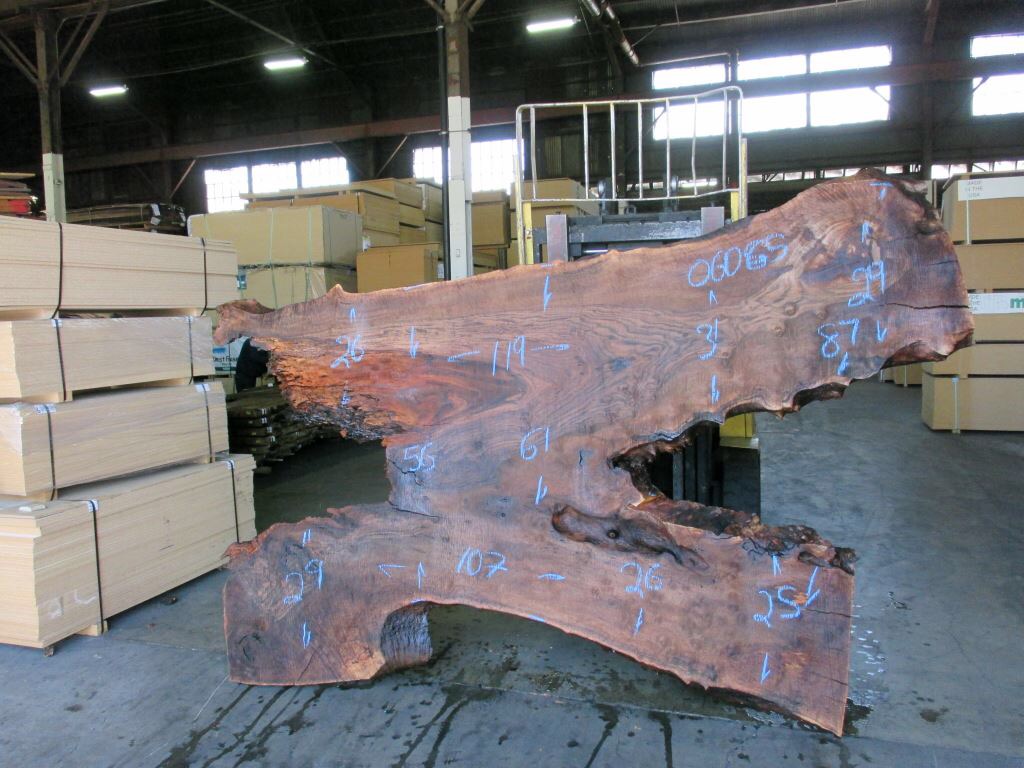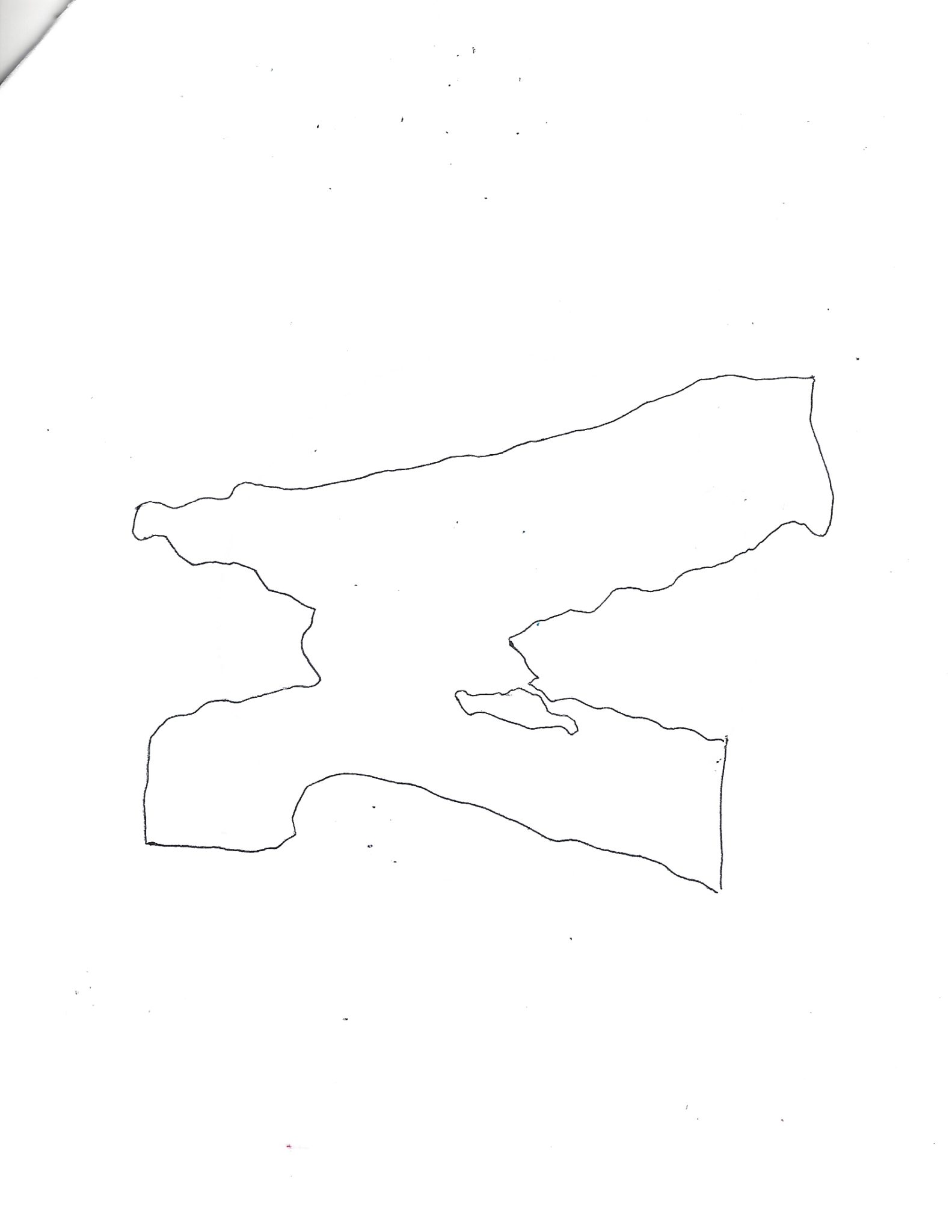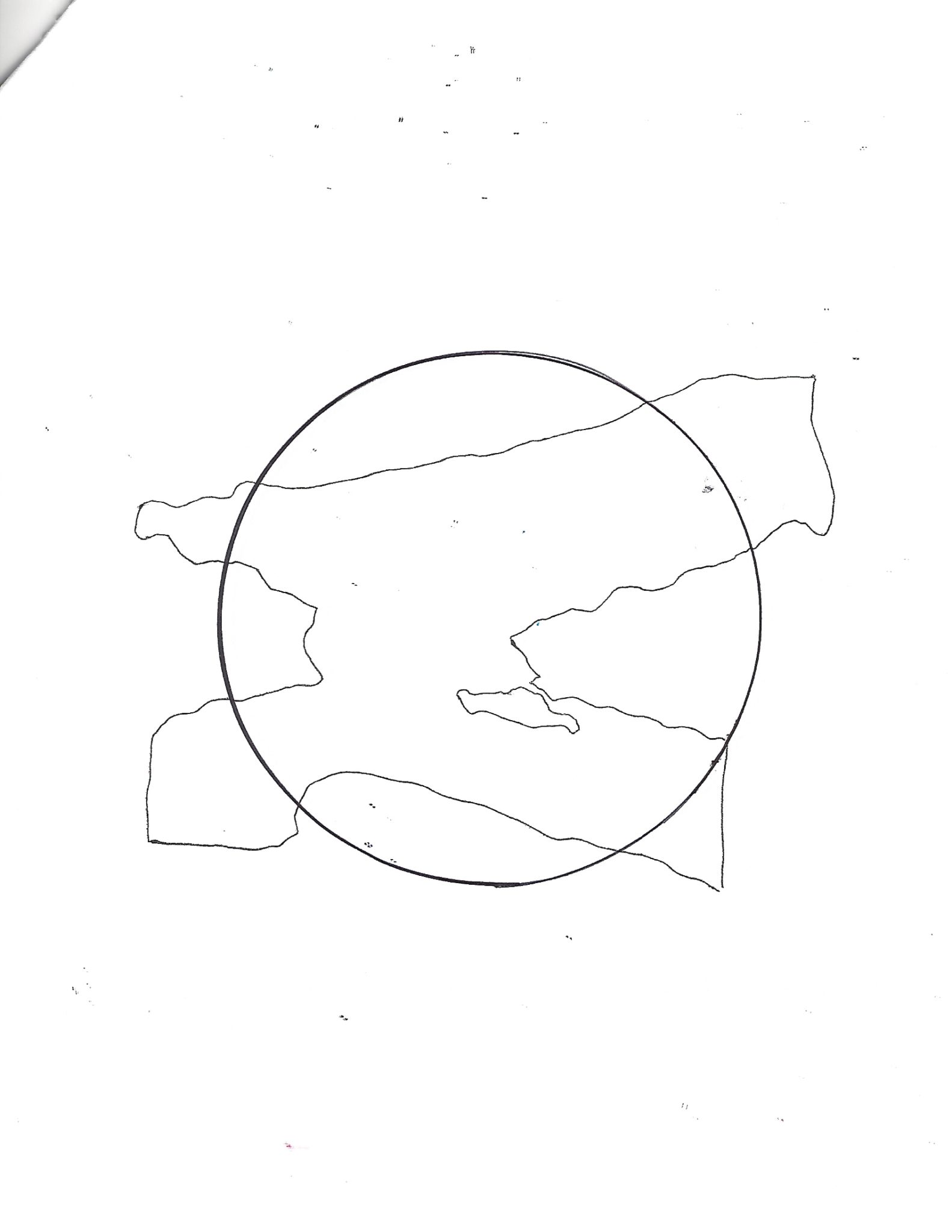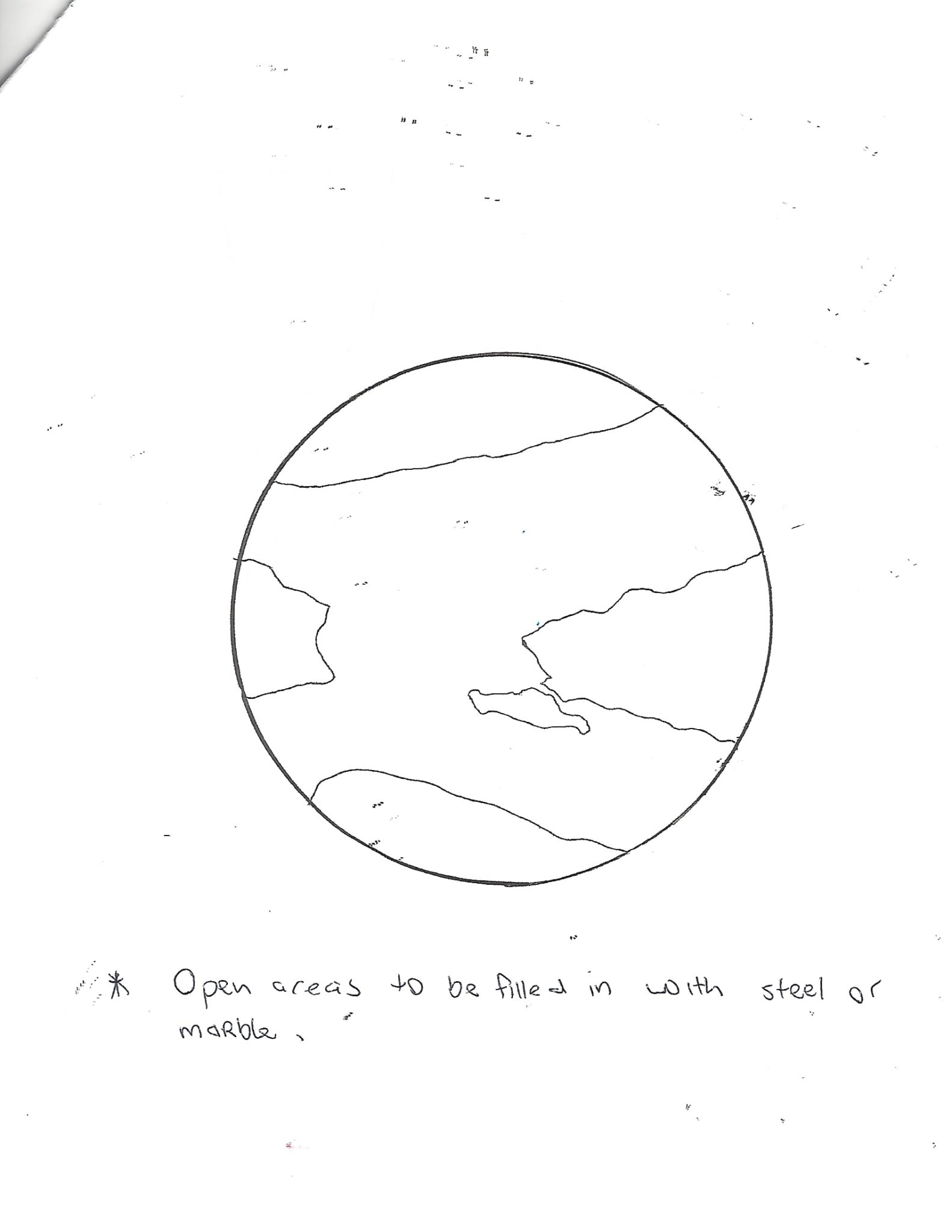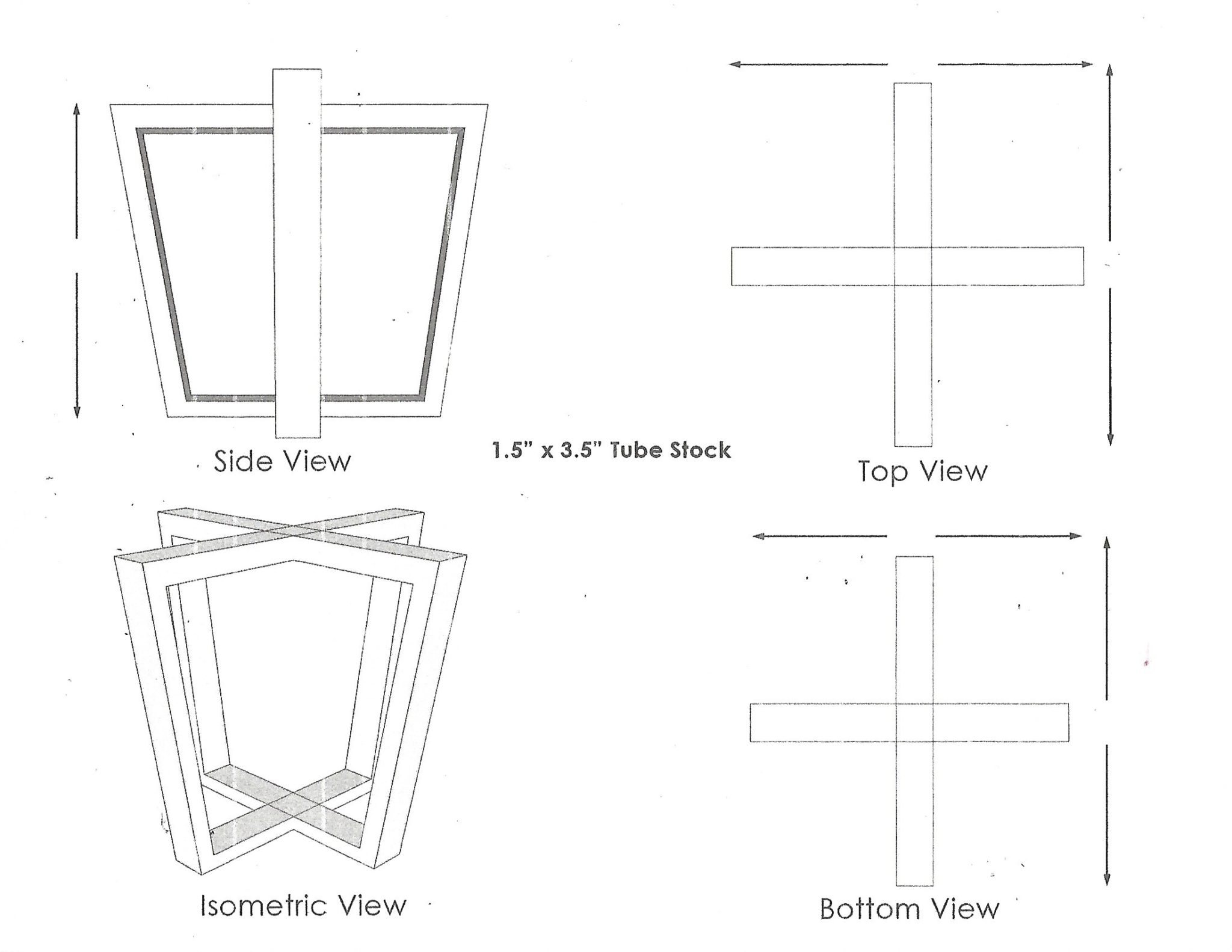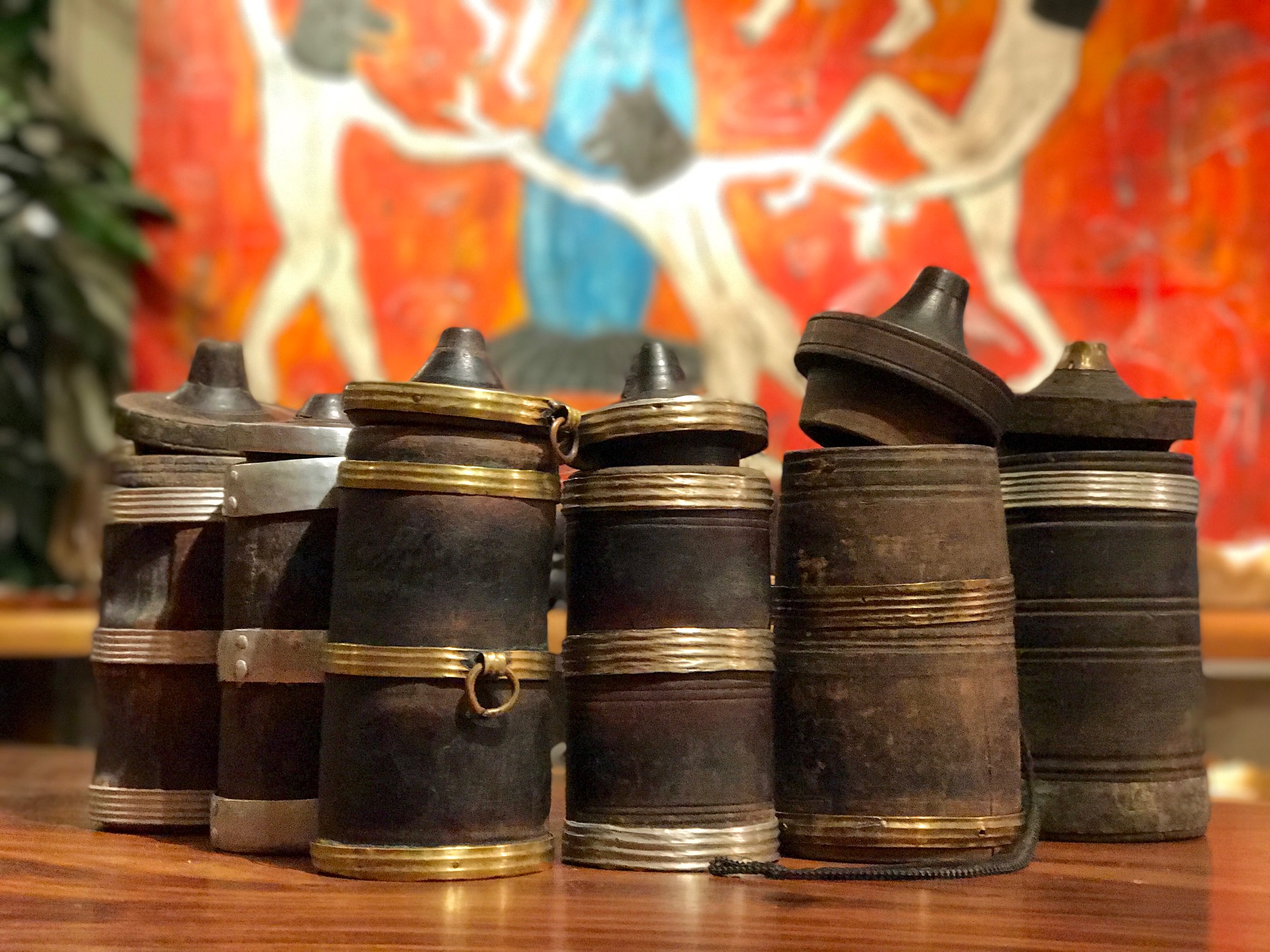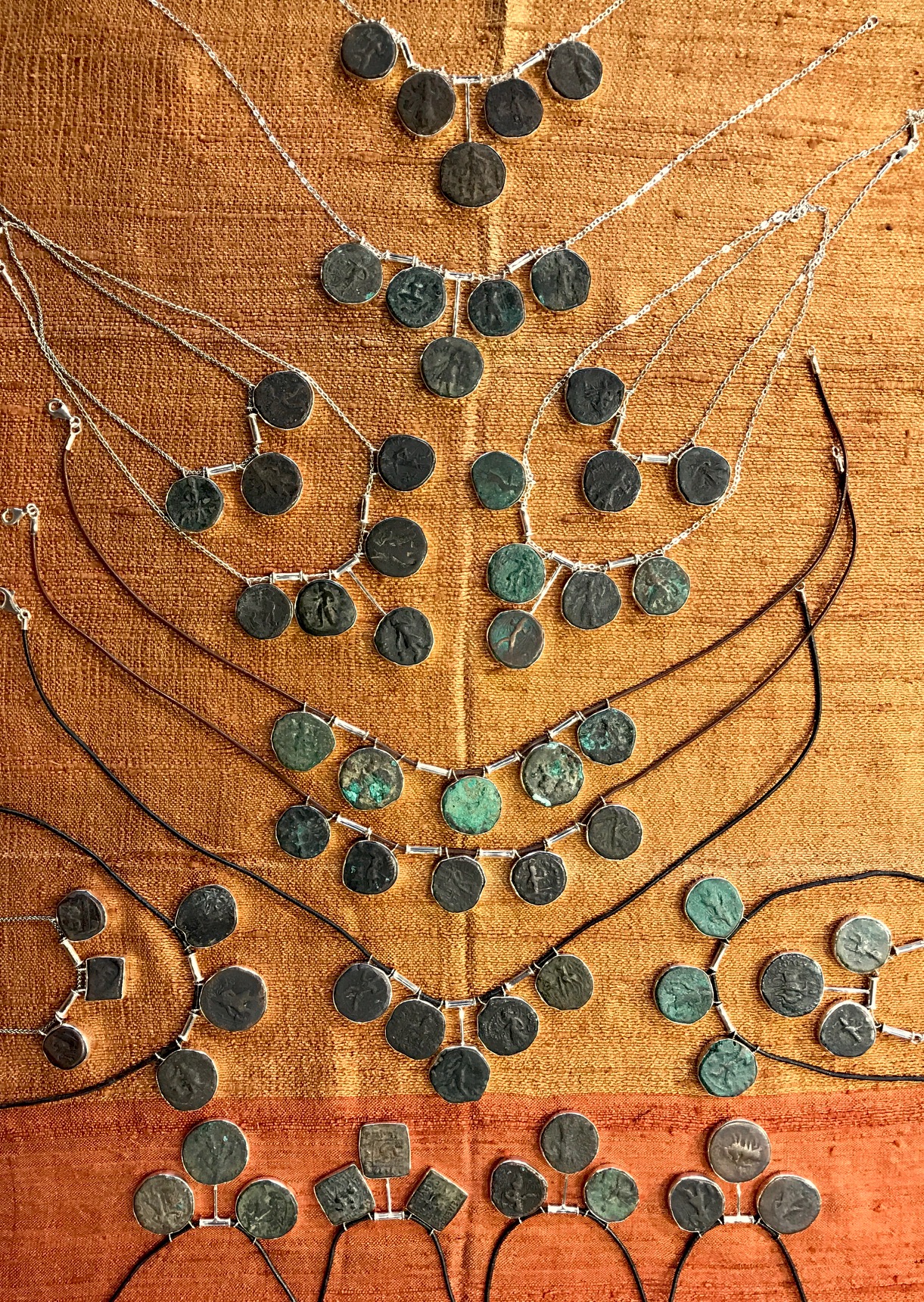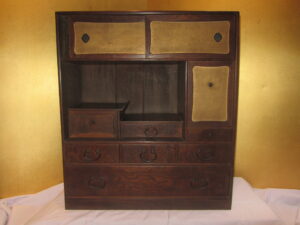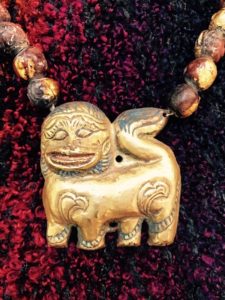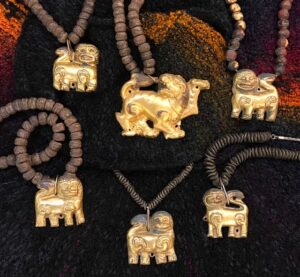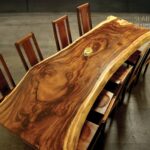Essential to the shamanic traditions of the Vietnamese is the ability to read and write Chinese. A requisite, extensive knowledge of Buddhism, Hinduism, Confucianism, Animism and Ancestor worship make the shaman’s training a long and rigorous process. They must draw on a complex base of philosophies and abilities which include the use of scroll paintings, ritual texts, and prints. The shaman use a collection of specific objects and instruments to aid them in entering the realm of the spirits. They wear intricately crafted robes designed for women, who were the original healers – before the demands of child rearing caused a gradual shift to a predominantly male profession. The elaborate imagery embroidered on the robes represents the universe with all its deities. Shaman wrap themselves in this ‘Universe’ for protection during rituals, in which they negotiate directly with supernatural beings – both good, and evil. Shaman are the cornerstones of culture and society in Vietnam and Thailand. They care for both rich and poor, and preside over individual and community events and celebrations. (please keep checking as we add to this Vietnam post)
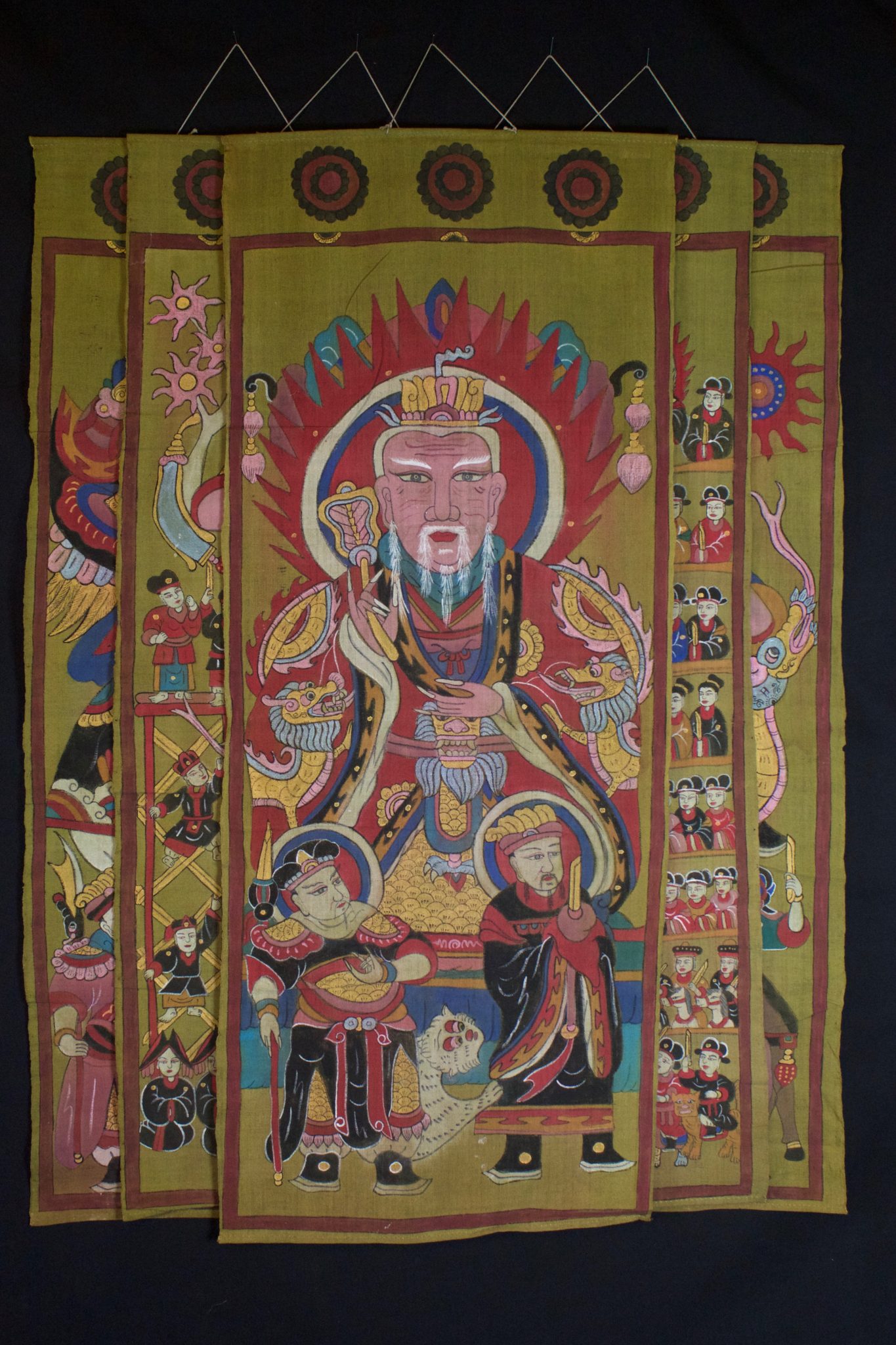
Shamans derive spiritual power from these paintings. When hung around the room in specifically arranged layouts, they effectively become the spirit world they represent and, like a portal, the shaman can then enter that realm. The ritual texts allow him/her to communicate directly with the deities and ancestors to negotiate and treat diseases and other things that have become out of balance.
An essential set of three basic painting panels is the minimum requirement for a a newly initiated shaman. Full sets, required for many rituals, can range from 17 paintings to more than 27. An example of a ritual requiring a full set would be one performed to liberate souls of the dead from Hell to be reborn into Heaven. The panels depicting the 10 Kings of the underworld are hung around the main room of a house. The shaman enters a trance, thereby entering Hell, and chants a ritual that will save the soul of the recently dead. 42” x 16” (15 pcs $6200.) Or $425 for a single individual banner.
*Please scroll to bottom of this post for detailed images of each of the large 42″ x 16″ banners above.
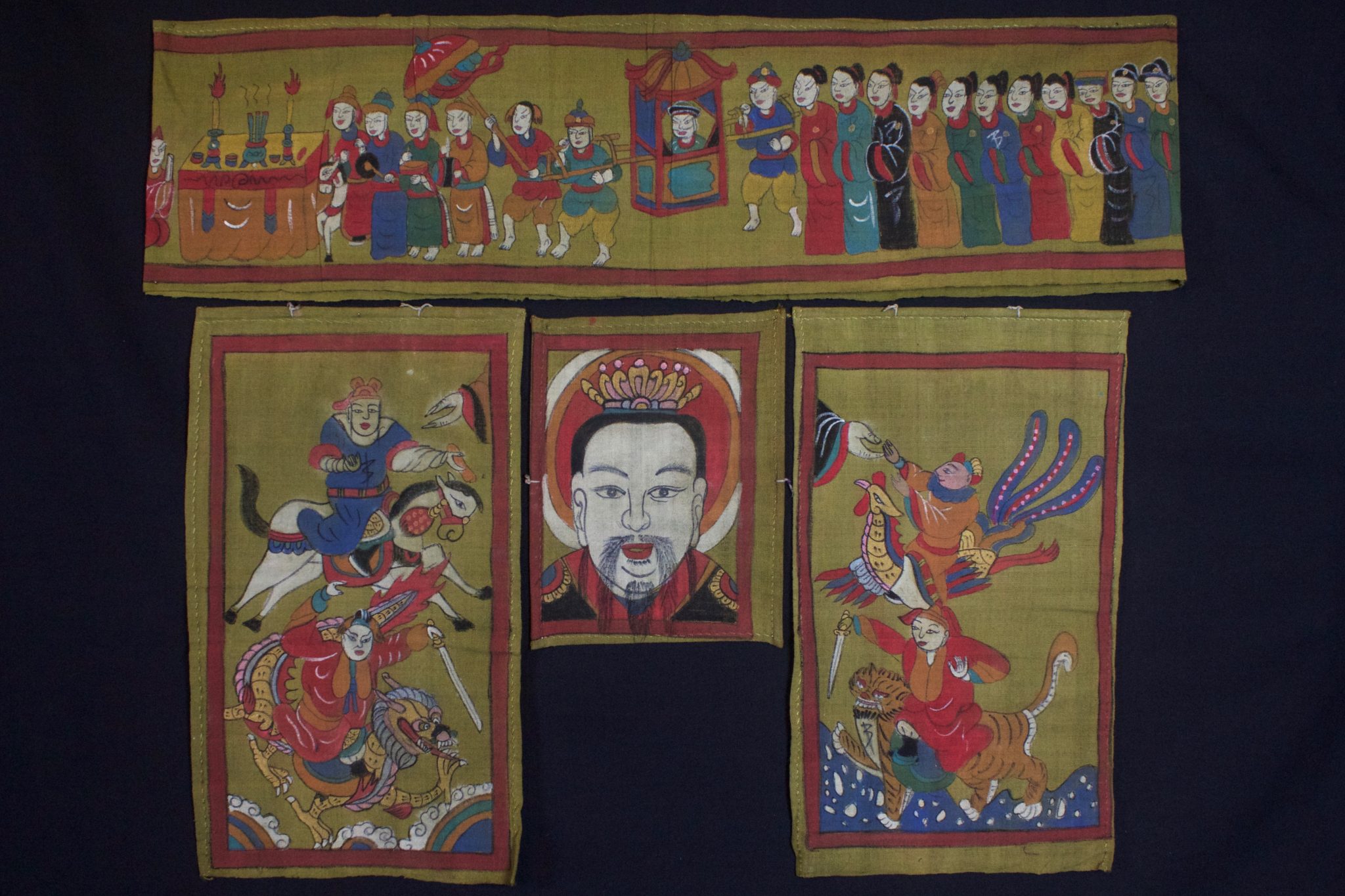
In addition to the previous set (previous image) of 18 large paintings – these are 3 smaller sizes – (3 pcs – 17 ½” x 10″, $170 each); (3 pcs – 10 ½” x 7 ½” , $110 each); (1 piece – 9″ x 80″, $325.) The horizontal one is shown folded. Please contact us for additional images.
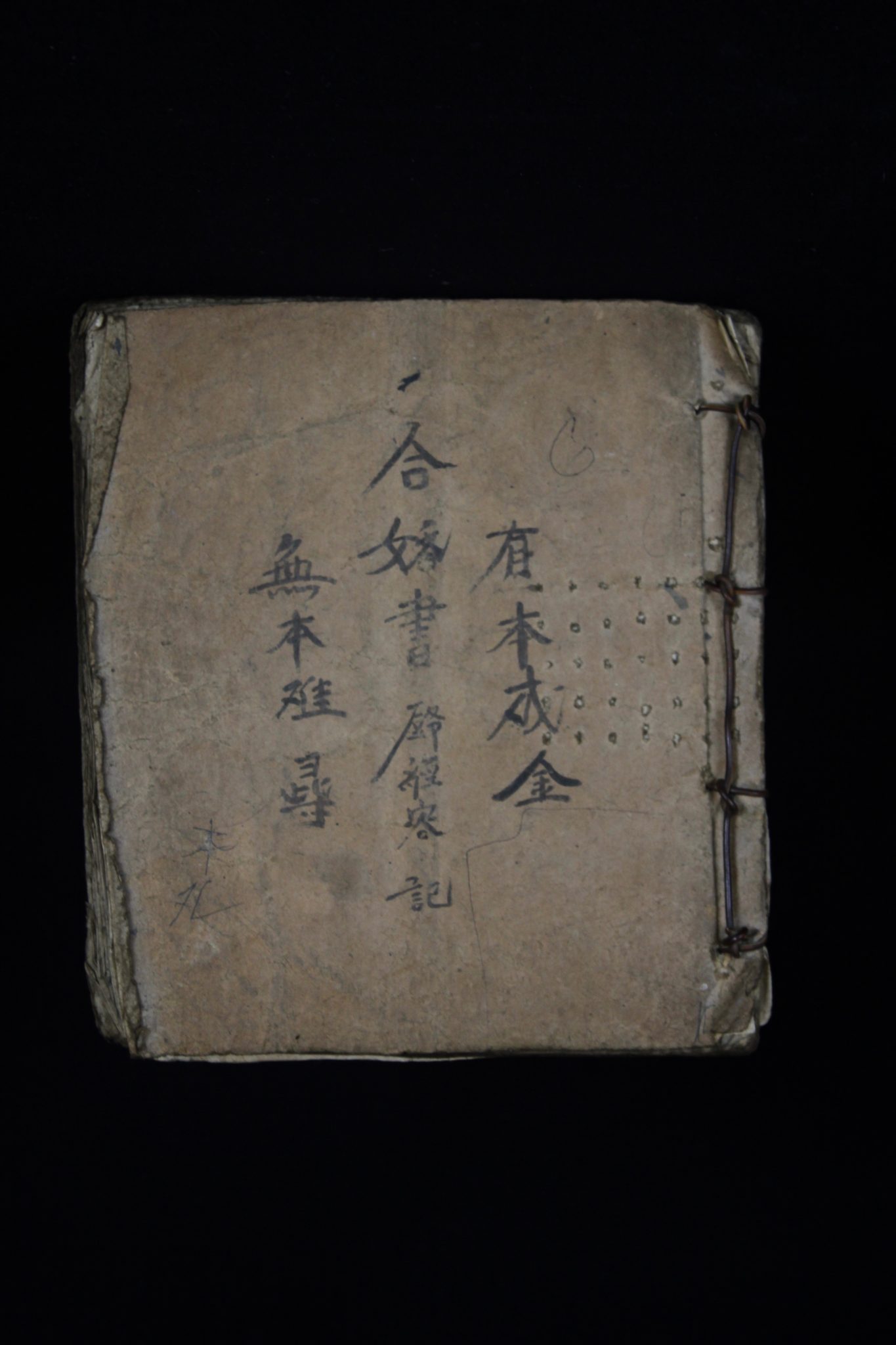
Written in Nom (Chinese characters adapted to Vietnamese), books are an integral part of a shaman’s repertoire. They range from explanations of various rituals and use of objects, to astrology, history, songs, laws, etiquette, children’s tales, hunting practices, formulas, spells and Feng Shui. Shaman make their own books to help store their knowledge therefore no two are alike and a high level shaman will have a large library. 9 ½” x 8 ½” x ¾”, $850. (see inside detail below)
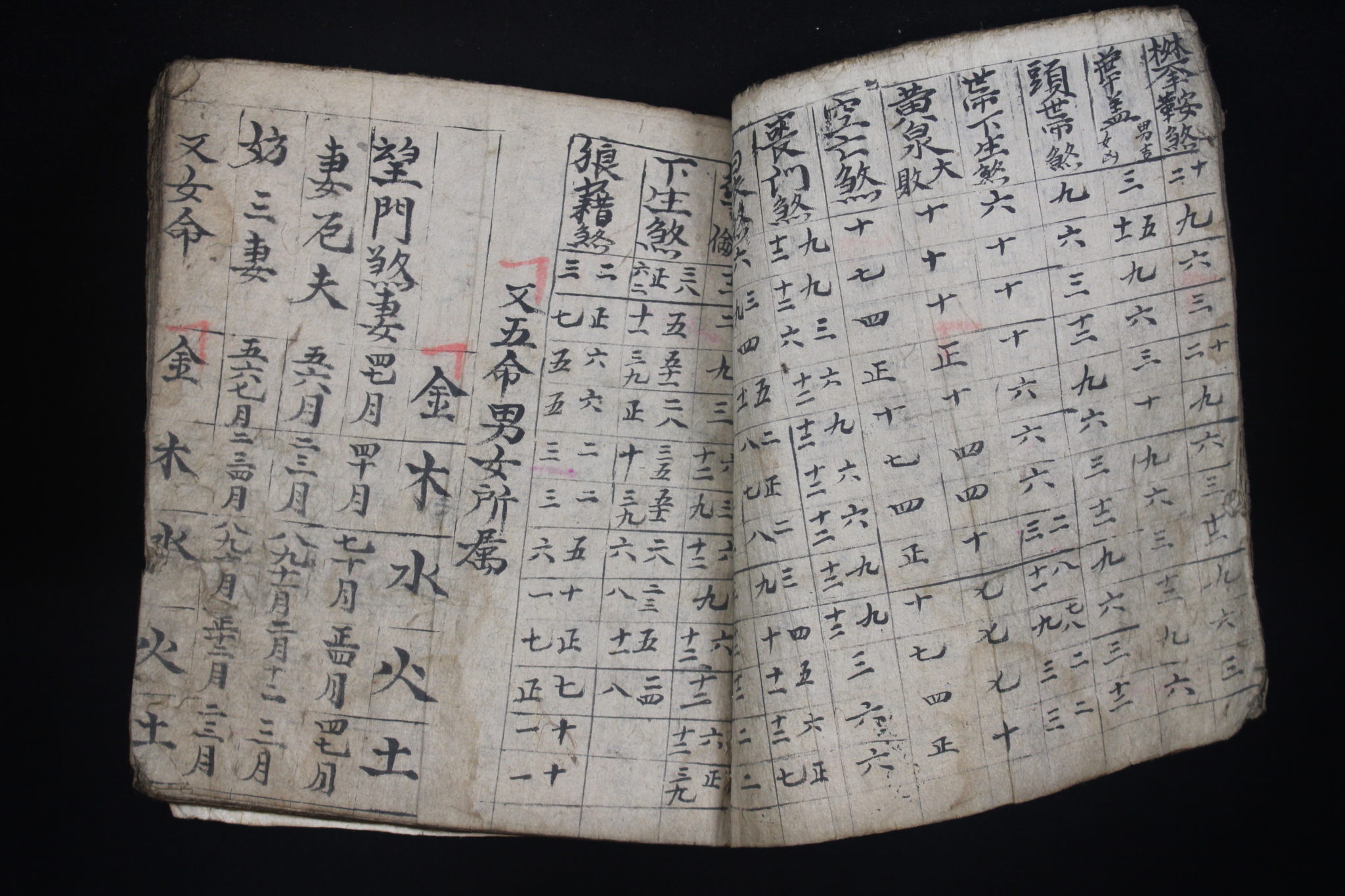
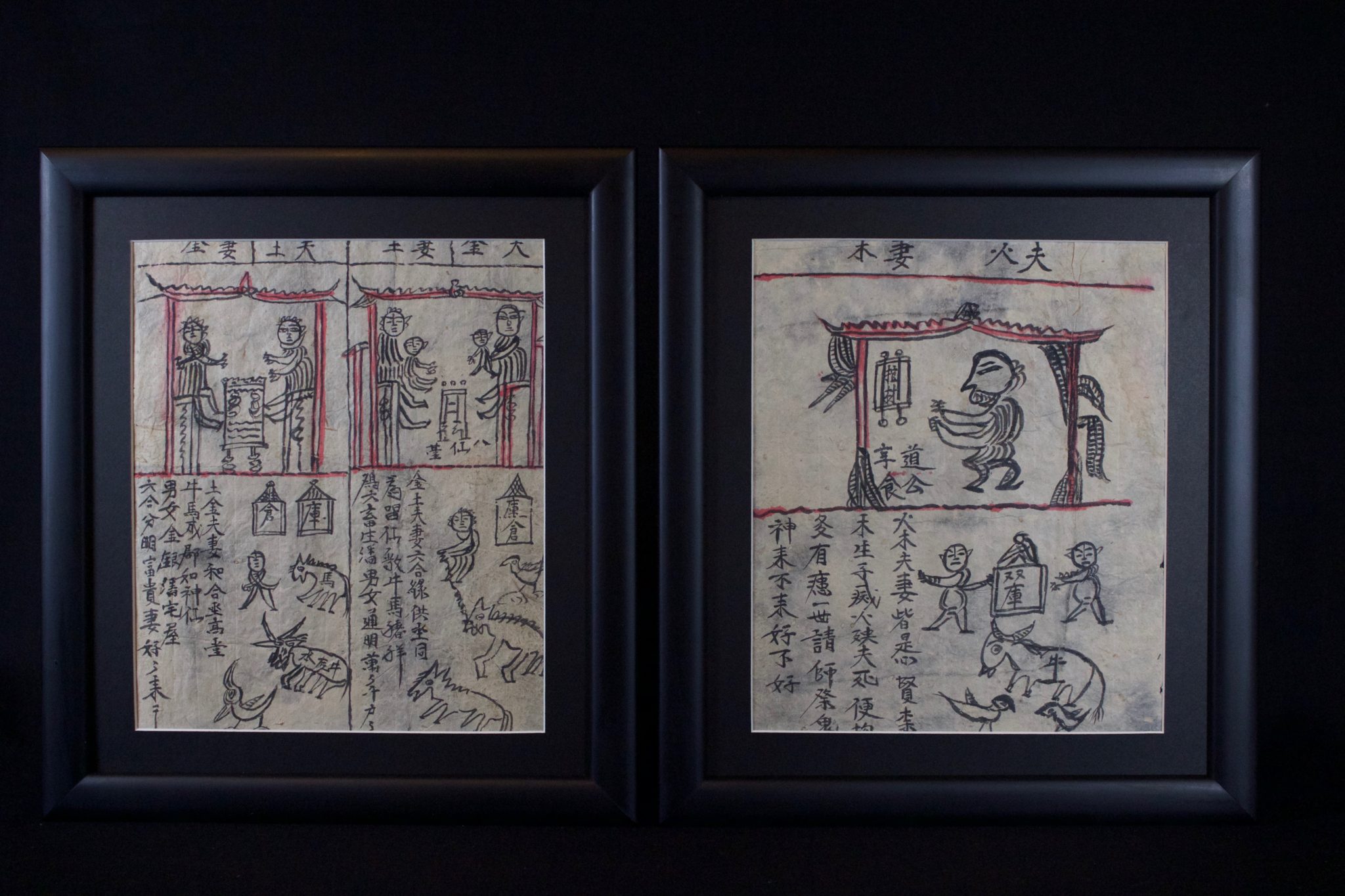
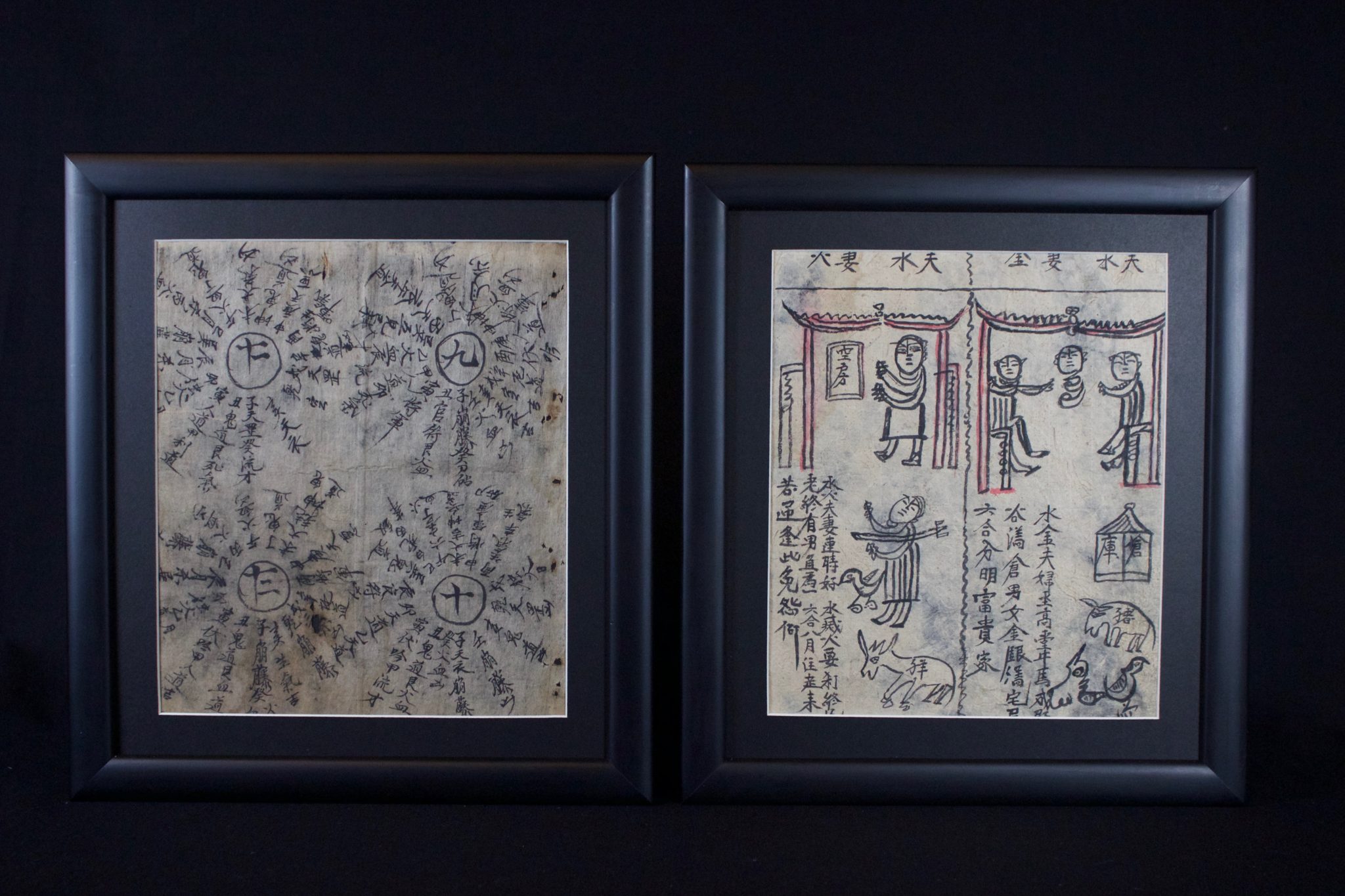
Written in Nom (Chinese characters adapted to Vietnamese), books are an integral part of a shaman’s repertoire. They range from explanations of various rituals and use of objects, to astrology, history, songs, laws, etiquette, children’s tales, hunting practices, formulas, spells and feng shui. Shaman make their own books to help store their knowledge therefore no two are alike and a high level shaman will have a large library. 12” x 11” x ½” (framed), $120. each
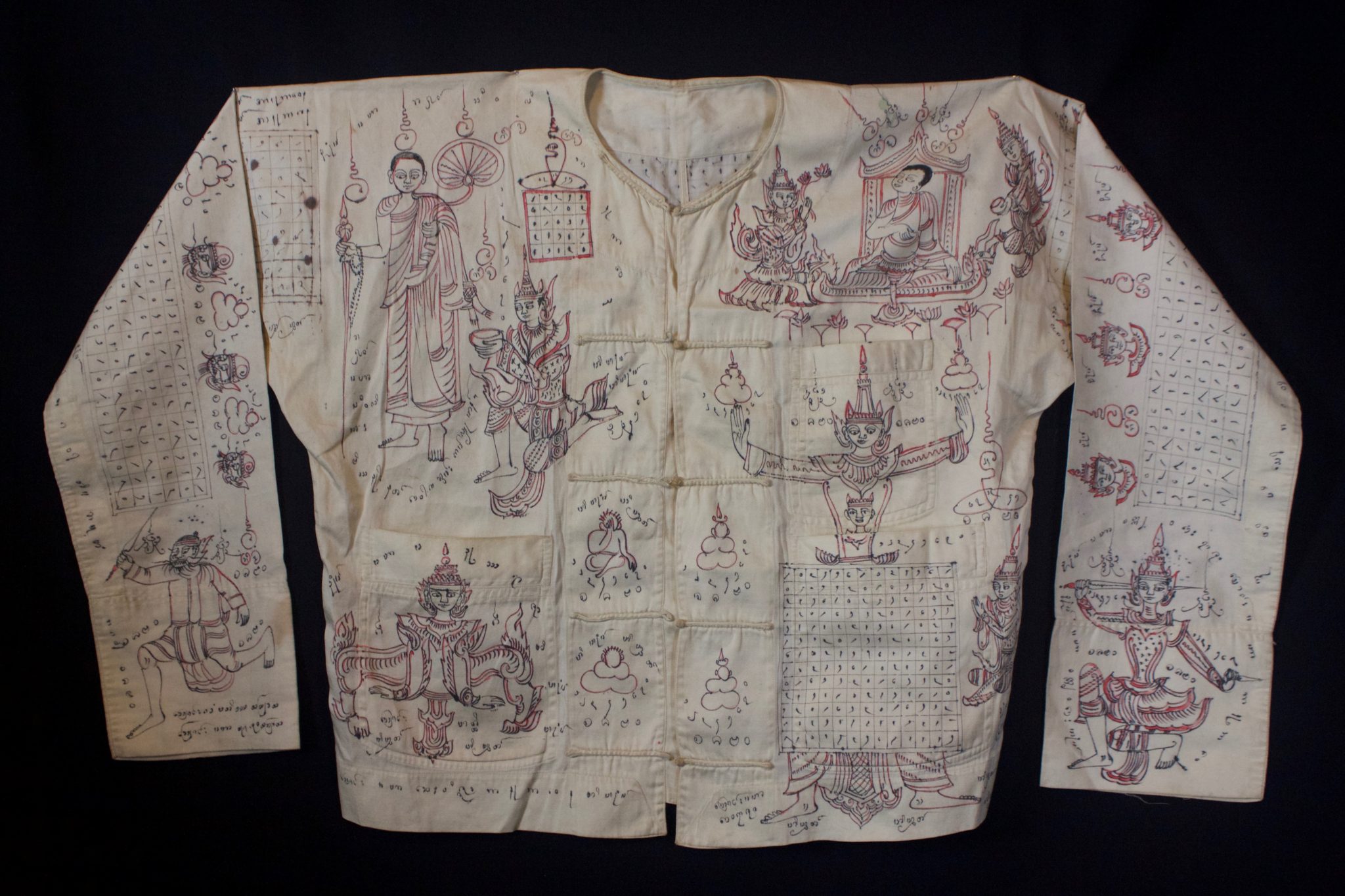
Handmade and drawn by the shaman, it depicts prayers, signs, numbers and a deities. The sacred cloth is an undergarment worn as a talisman with great protective power against physical harm, like bullets, spears, knives, wild animals and evil spirits. This one may have been commissioned by a wealthy man who felt he needed protection. Soldiers would also wear these if they could afford one. 21” x 61”, $2900. SOLD
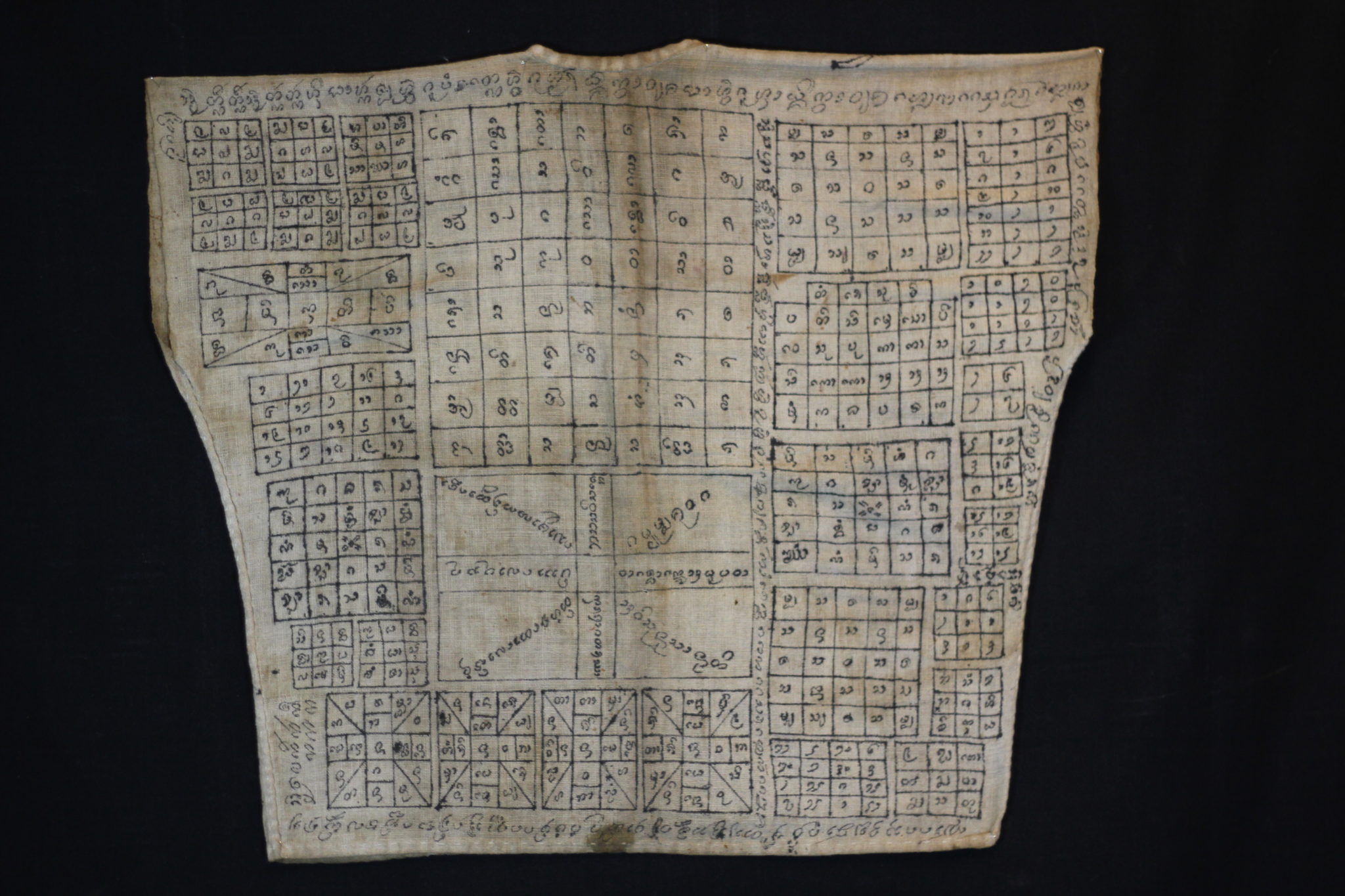
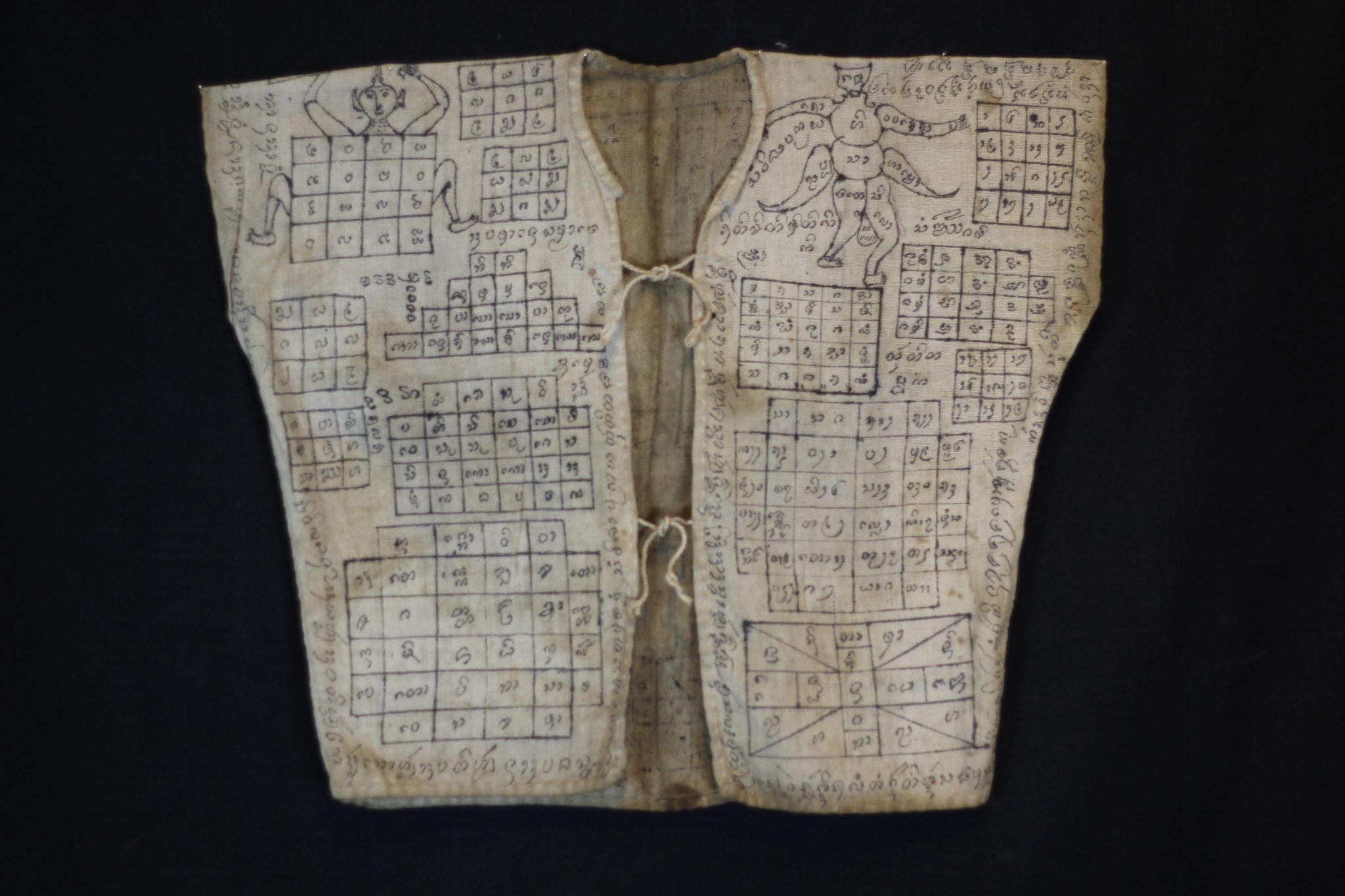
Handmade and drawn by the shaman. It is endowed with prayers, signs, numbers. The sacred cloth is an undergarment worn as a talisman with great protective power against physical harm, like bullets, spears, knives, wild animals and evil spirits. 19” x 22”, $2,900. SOLD
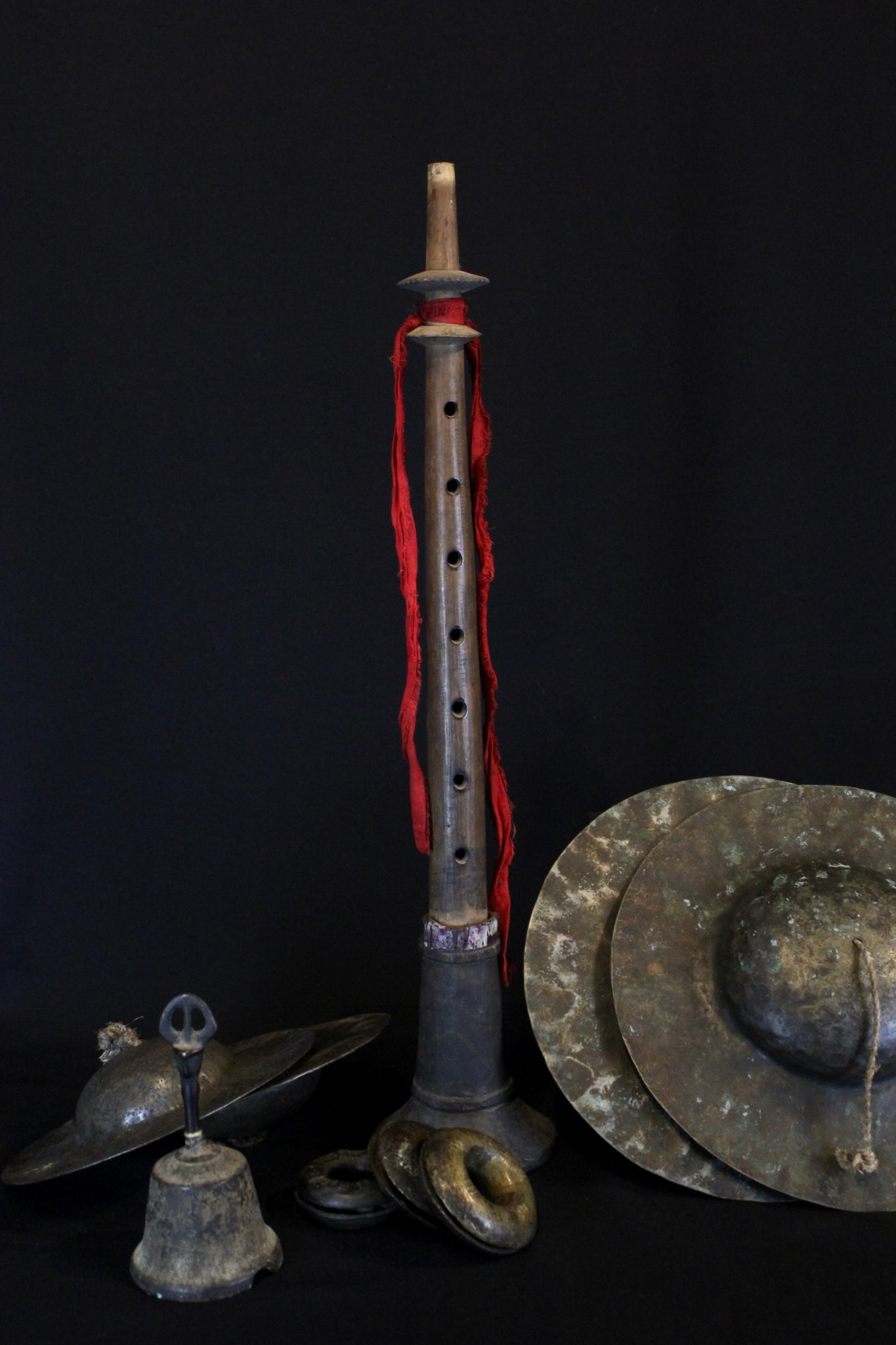
Instruments are essential tools for shaman. They create the rhythmic atmosphere that facilitates entering and maintaining the trance state necessary for the shaman to enter the spirit worlds. (Cymbals, Bells, Flute)
Cymbals -;Tuyen Province, Northern Vietnam, Cao Lan People, Late 19th to early 20th c, Bronze. For welcoming divinities and warding off evil beings. Cymbals represent the turtle – legendary hero figures, who are exercised for killing monsters. Dimensions: (small – 3 ½” x 6 ¾’ x 6 ¾”, $400.), (large – 4” x 9 ½ x 9 ½”, $590.) SOLD
Shaman/Buddhist Priest Clapper Bell; Black Yao people, Late 19th c, Metal coin as clapper, The handle is embellished with a human face. Used in religious rituals. Its sound is meant to evoke protective deities and dispel evil spirits. This type of bell is also used during chanting and incantations of mantras. 5” x 2 ½” x 2 ½”, $325. SOLD
Round Finger Bells, Hoa Binh province, Vietnam, H’mong people, Late 19th to early 20th c, Bronze, Placed on one’s finger, the tone can be modified with the palm and remaining fingers. $90. each, (2 ½” x 1” x 1”); (2 ½” x 1” x 1”); (2 ¼” x 1” x 1”). SOLD
Oboe/Flute, Cao Bang province, Red Yao people Early to mid 20th c, Wood, metal, An essential element of the musical ensembles that accompany the shaman’s rituals and performances to help the living and provide salvation for the dead. 19 ¼” x 4” x 4”, $220. SOLD
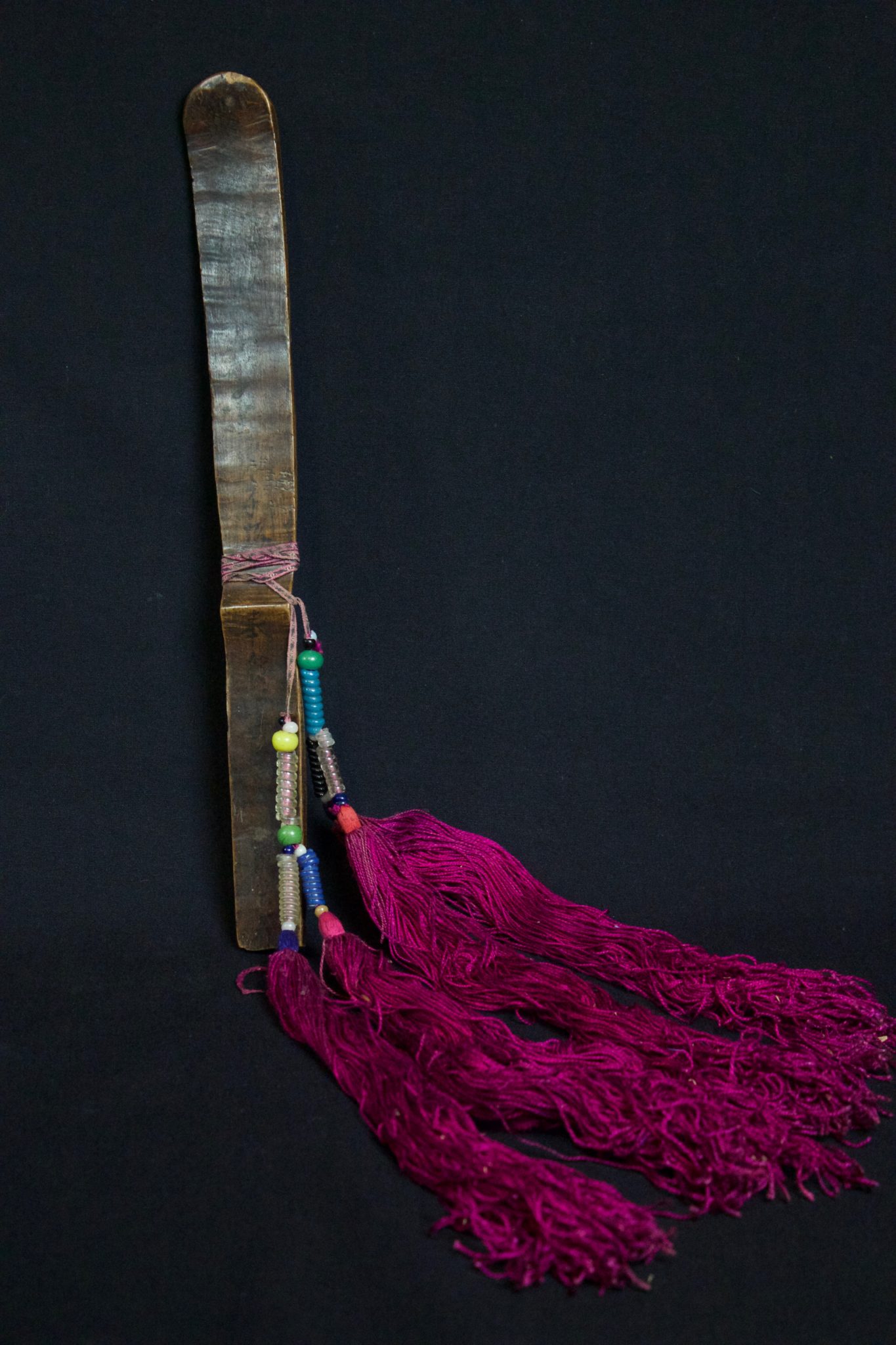
Potent tool used similarly to a Himalayan Phurba, to direct evil energy away and to summon and control spirits. Text characters are painted onto all sides. 13 ¼” x 16 ½” x ¾”, $650.
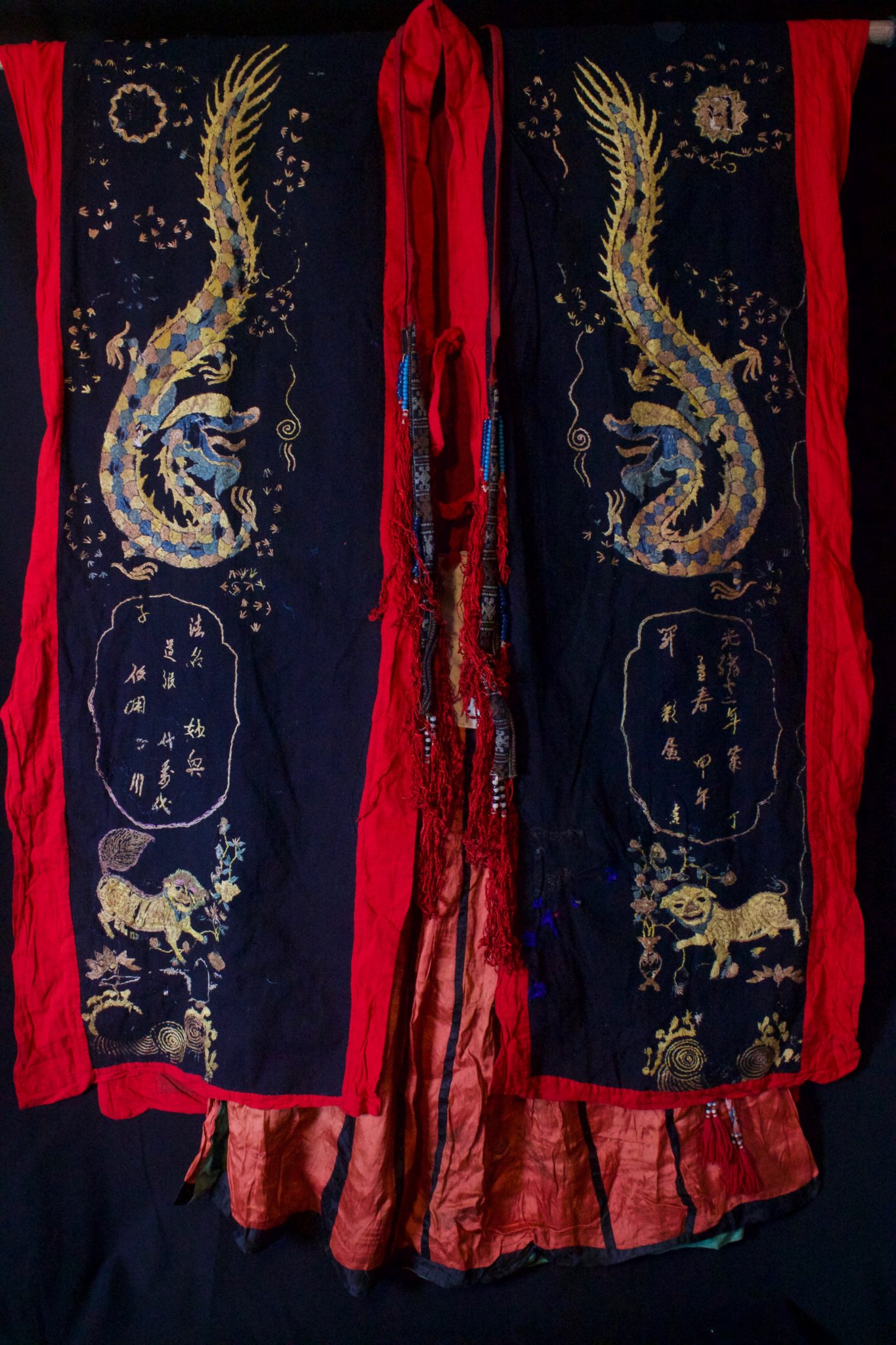
Worn by shaman priests for all ceremonies. The motif typically includes all the deities of heaven to clothe the shaman in the protection of the universe. Not a vain adornment, it is a reminder of man’s place in the hierarchical order. Long ago shamans were women and men the providers. Not being encumbered by childbirth and child rearing, men gradually replaced women as shaman but the sacred costume remained the same. This type of headpiece/scarf (image below) is worn by postulant or newly ordained shaman. High level priests will wear a hat made of human hair. Dimensions
(49” x 42” robe); (35” x 26” skirt); (106” x 3” belt); (118” x 9 ½” scarf – below), $3900 full costume.
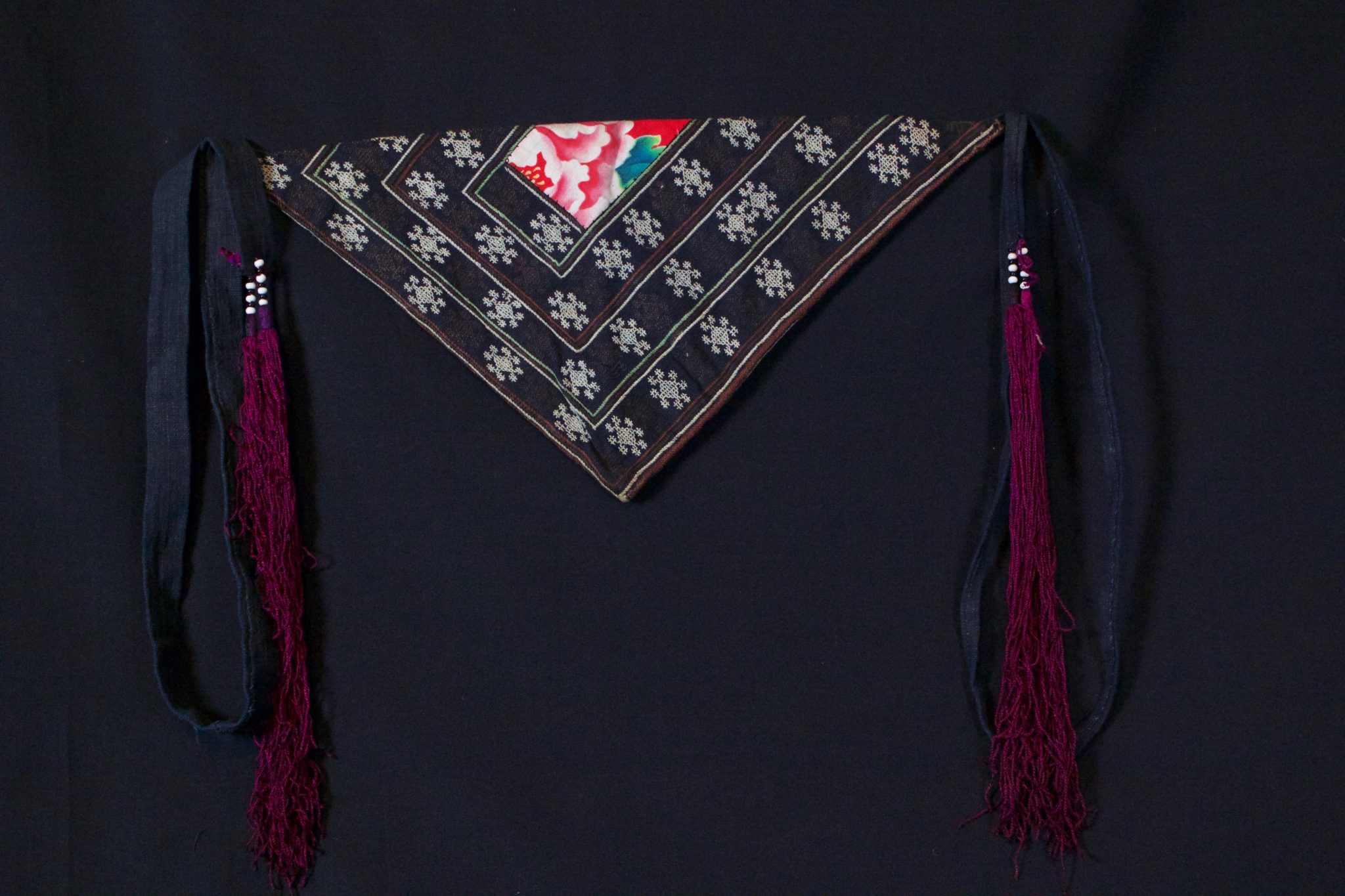
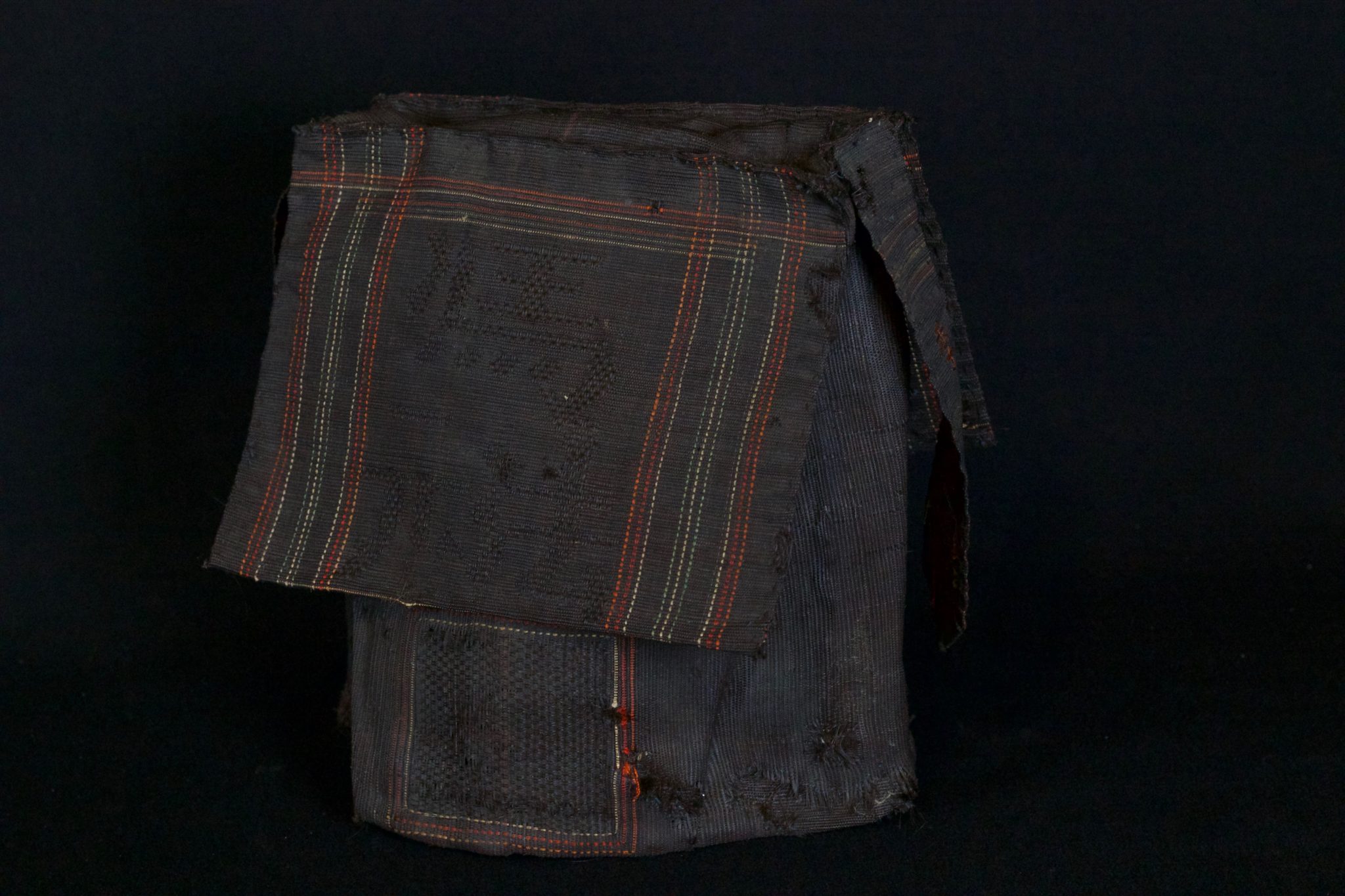
Hats are a crucial part of the shaman’s costume. Hats made from human hair are worn only by high level priests. Postulants and newly ordained shaman wear a cotton and silk head scarf. Human hair strands are twisted together to make thicker ones, dyed dark brown and woven into patterns. They are very difficult to make but are durable and last a long time. The symbol for good luck symbol is woven into the front of the hat and the shaman’s name into back. 9” x 10” x 2”, $675.
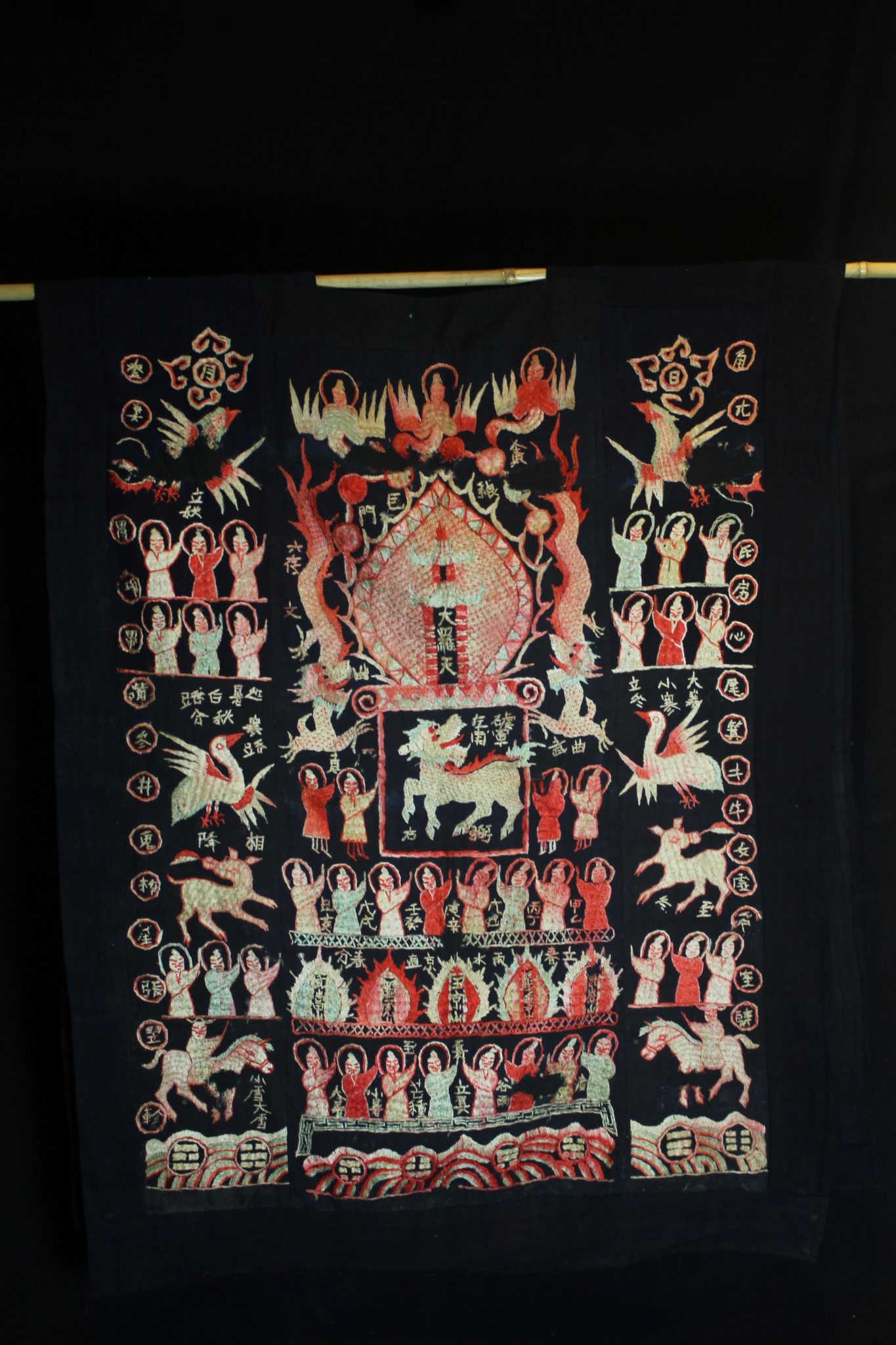
Worn only by high level shaman. The use of expensive and difficult to obtain brighter European dyes indicates an exceptional piece. The motif typically includes all the deities of heaven to clothe the shaman in the protection of the universe. Not a vain adornment, it is a reminder of man’s place in the hierarchical order. Originally a female costume. Long ago shamans were women and men the providers. Not being encumbered by childbirth and rearing, men replaces women as shamans but retained this part of the sacred costume. *more detailed information available. 45” x 26”, $2900. (front view below) SOLD
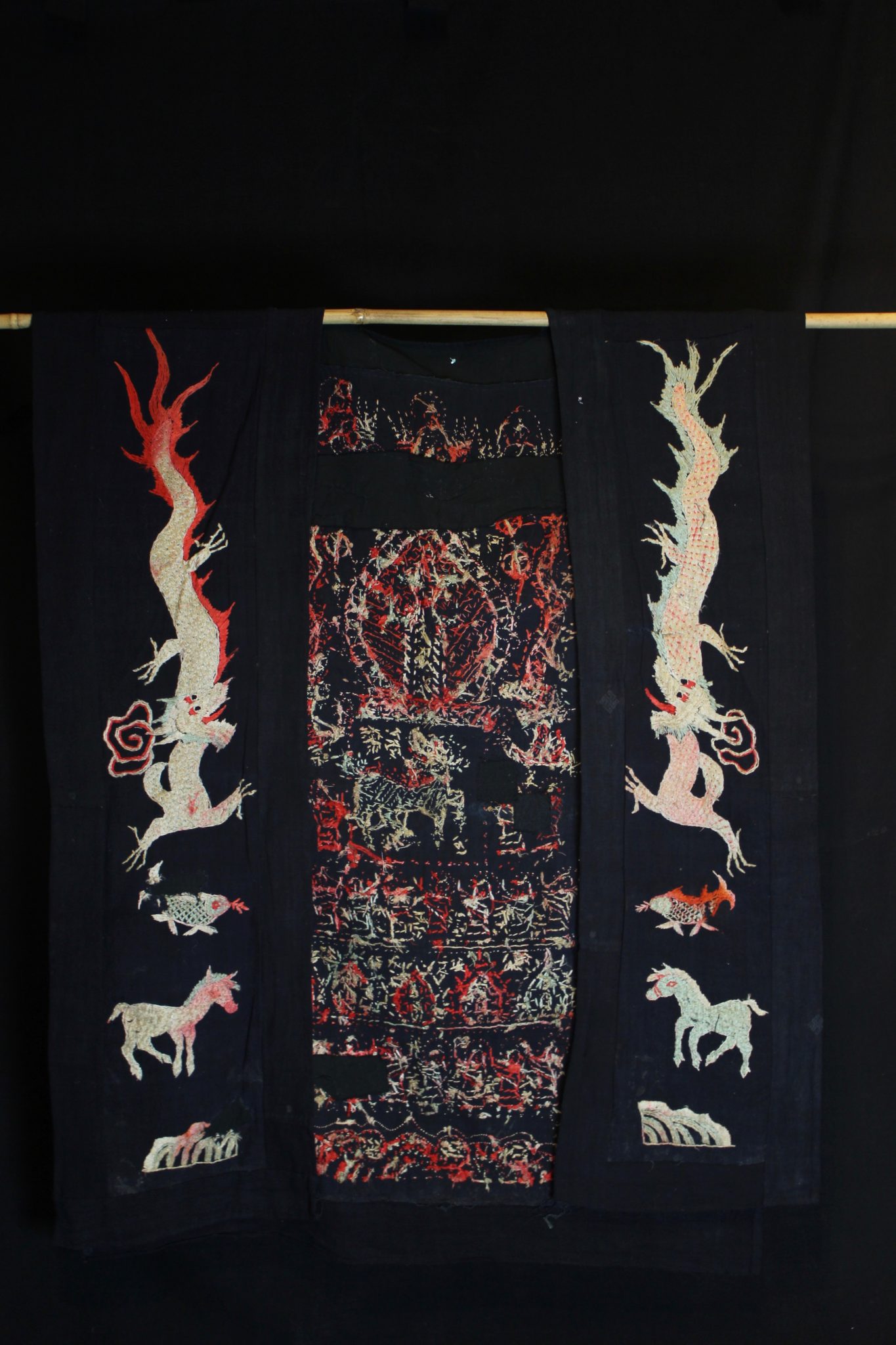
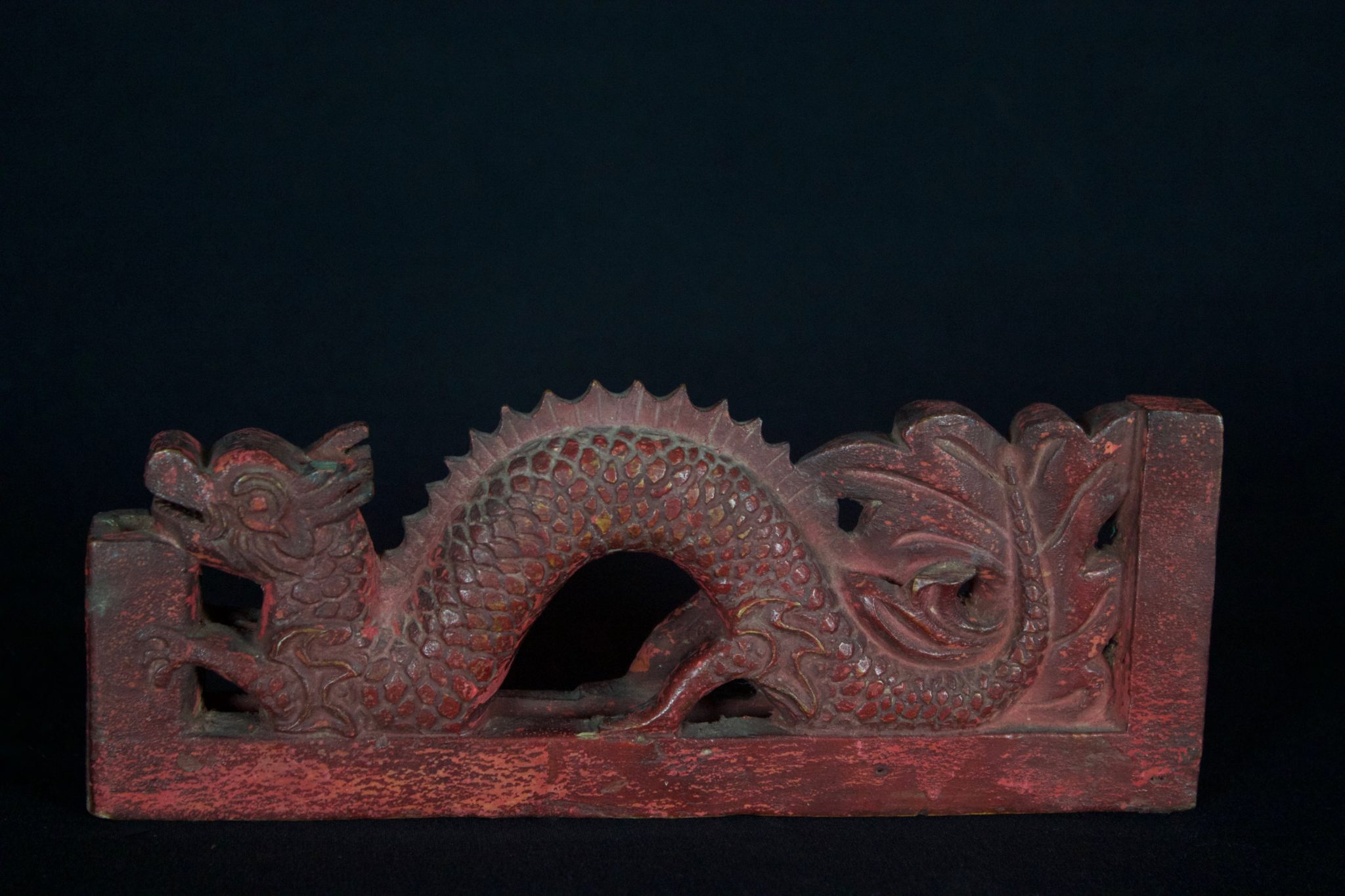
Pan Hung is a Taoist mythical, composite beast, usually a varied mixture of Dragon, Tiger and Dog. This particular wand is dominantly Dragon. It is typically used for calling spiritual powers and for fending off evil spirits – especially at funeral rites, and to wave over items to be burned as offerings to the ancestors. The slot on the underside is for mounting on a wall when not in use. 3” x 1” x 8”, $375.
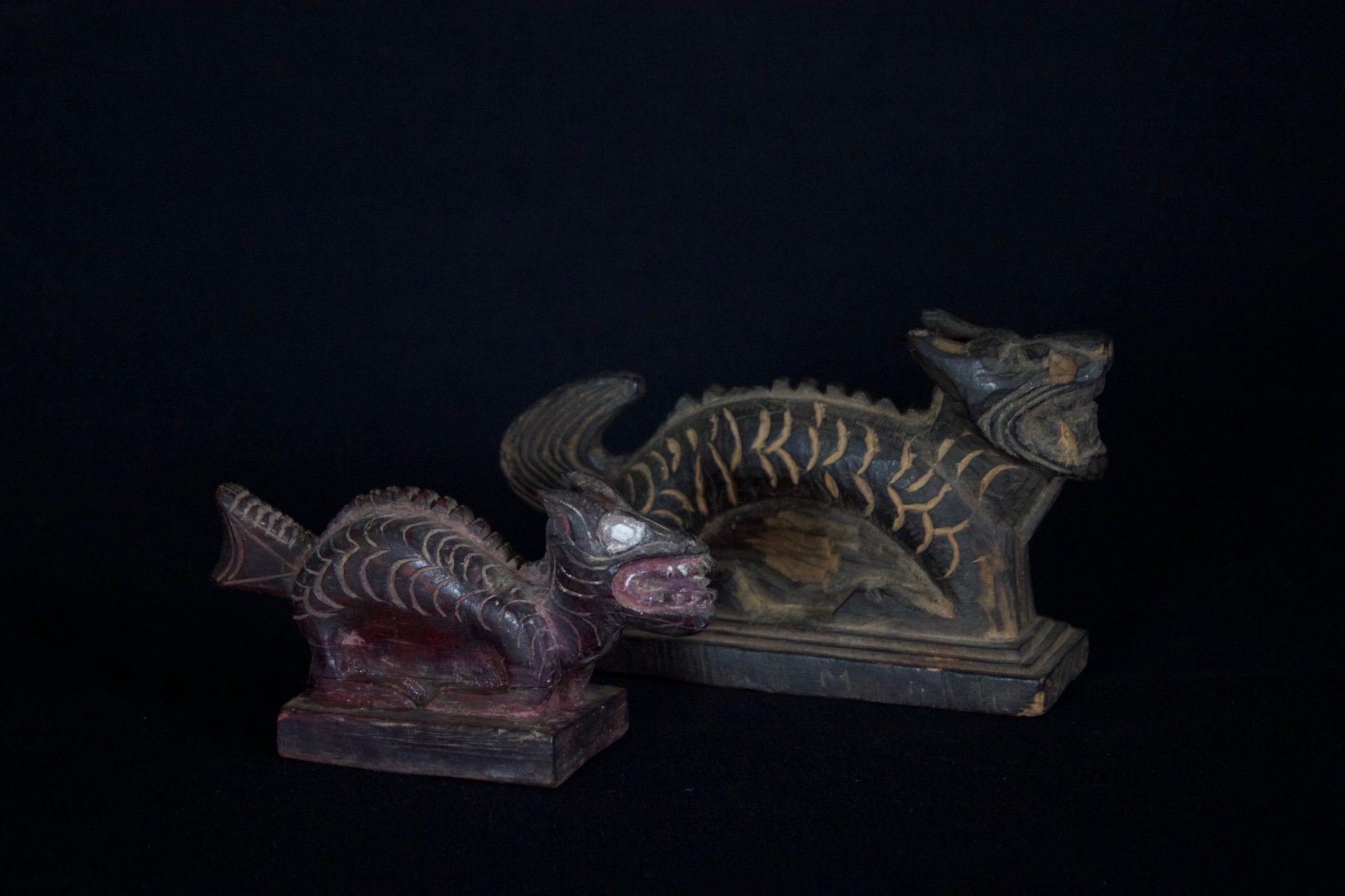
Pan Hung is a varied mythical, composite beast: Dragon, Tiger, Dog. It is typically used for calling spiritual powers and for fending off evil spirits – especially at funeral rites, and to wave over items to be burned as offerings to the ancestors. (small – Early 20th c, 2 ½” x 1 ¾” x 5”, $340.); (large – Mid 20th c, 3 ½” x 1 ½” x 6 ¼”, $240.)
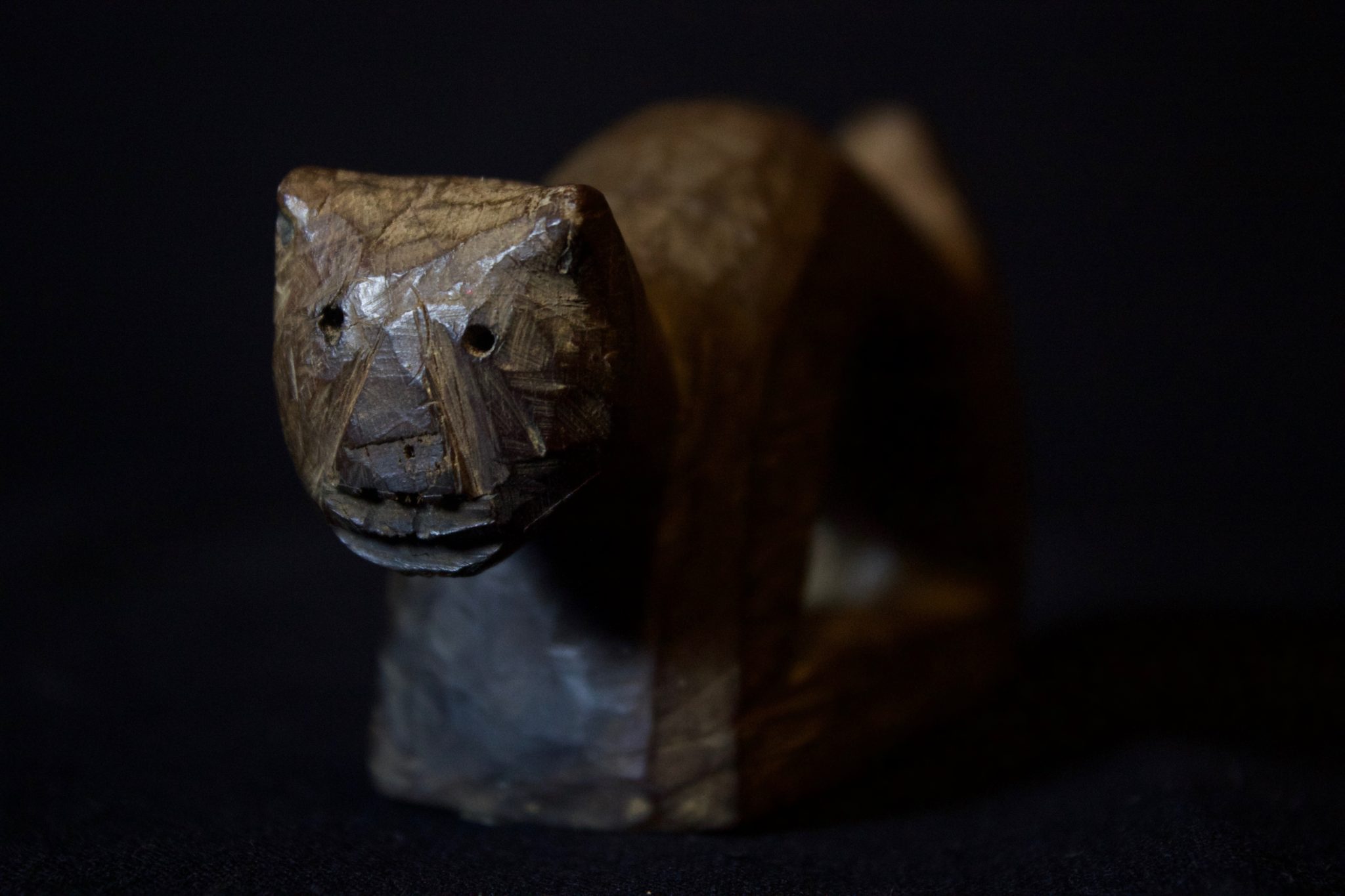
Pan Hung is a Taoist mythical, varied, composite beast: Dragon, Tiger, Dog. It is typically used for calling spiritual powers and for fending off evil spirits – especially at funeral rites, and to wave over items to be burned as offerings to the ancestors. 2 ¼” x 1 ¼” x 4”, $190. SOLD
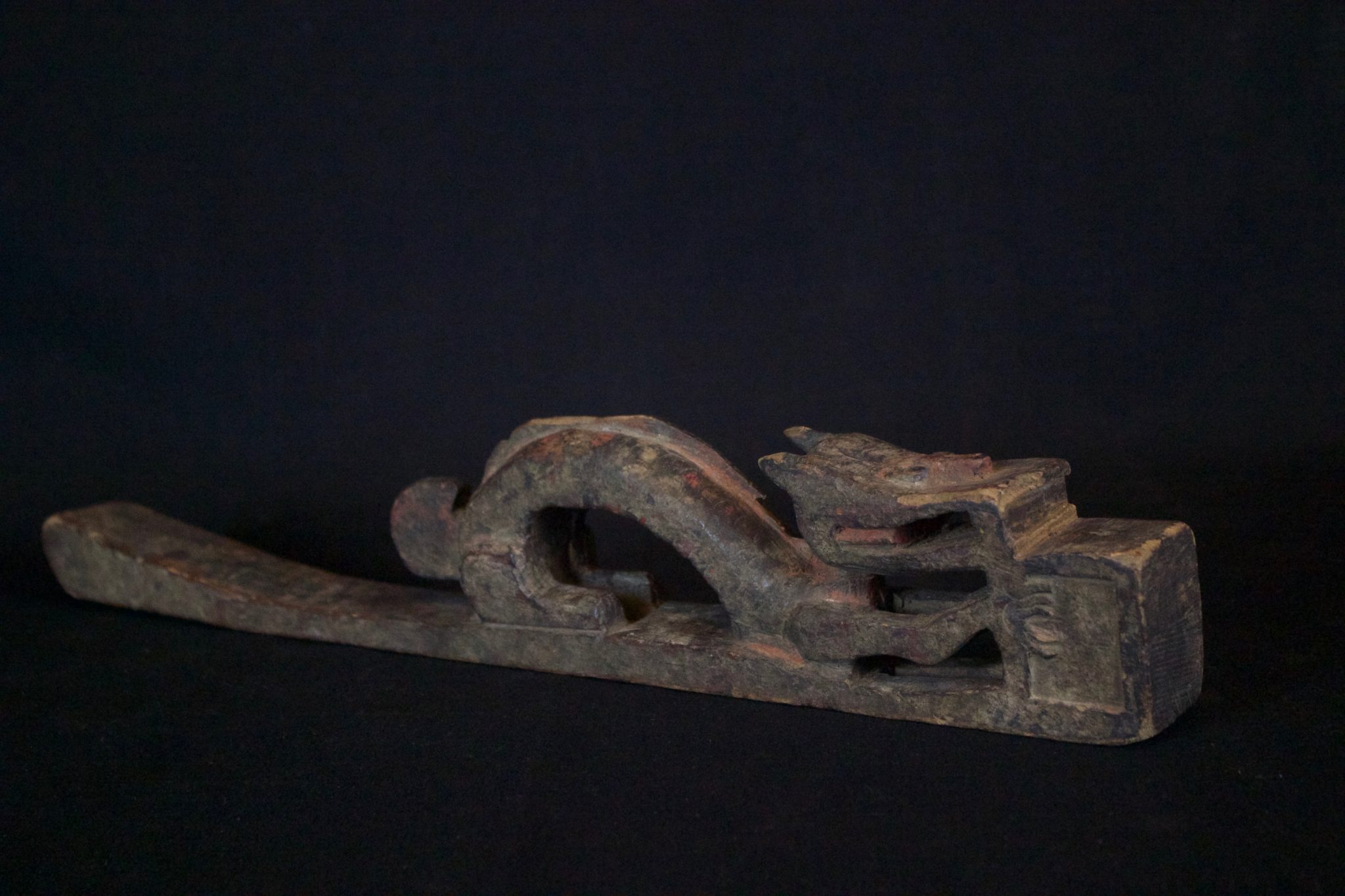
Pan Hung is a Taoist mythical, composite beast: Dragon, Tiger, Dog. This particular wand is dominantly Dragon. It is typically used for calling spiritual powers and for fending off evil spirits, especially at funeral rites, and to wave over items to be burned as offerings to the ancestors. The slot on the underside is for mounting on a wall when not in use. 3 ¾” x 1 14” x 18”, $800.
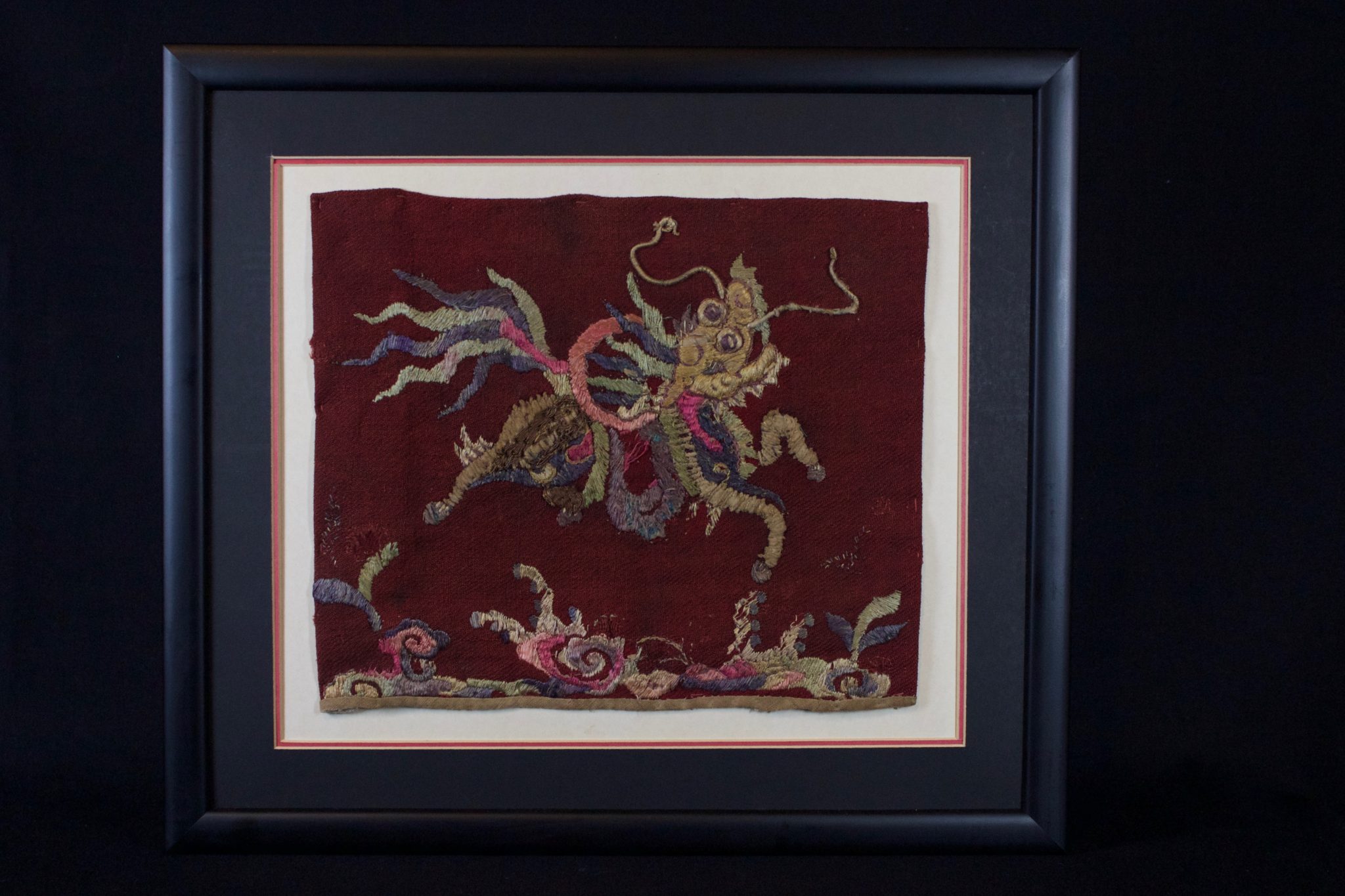
One of the four sacred animals, the unicorn symbolizes purity, happiness and wealth. If the unicorn appears, many good things will happen. It is often hung over the altar table in pagodas, temples or in homes of traditional families. Its strength and faithful nature are desirable for guarding temples and places of worship. Almost all of these pieces from this time period are portrayed in blue, cream and metallic color schemes. Because of its coloring, this panel is unusual and particularly desirable. 15 ½” x 17 ½” x ¾”, $590.
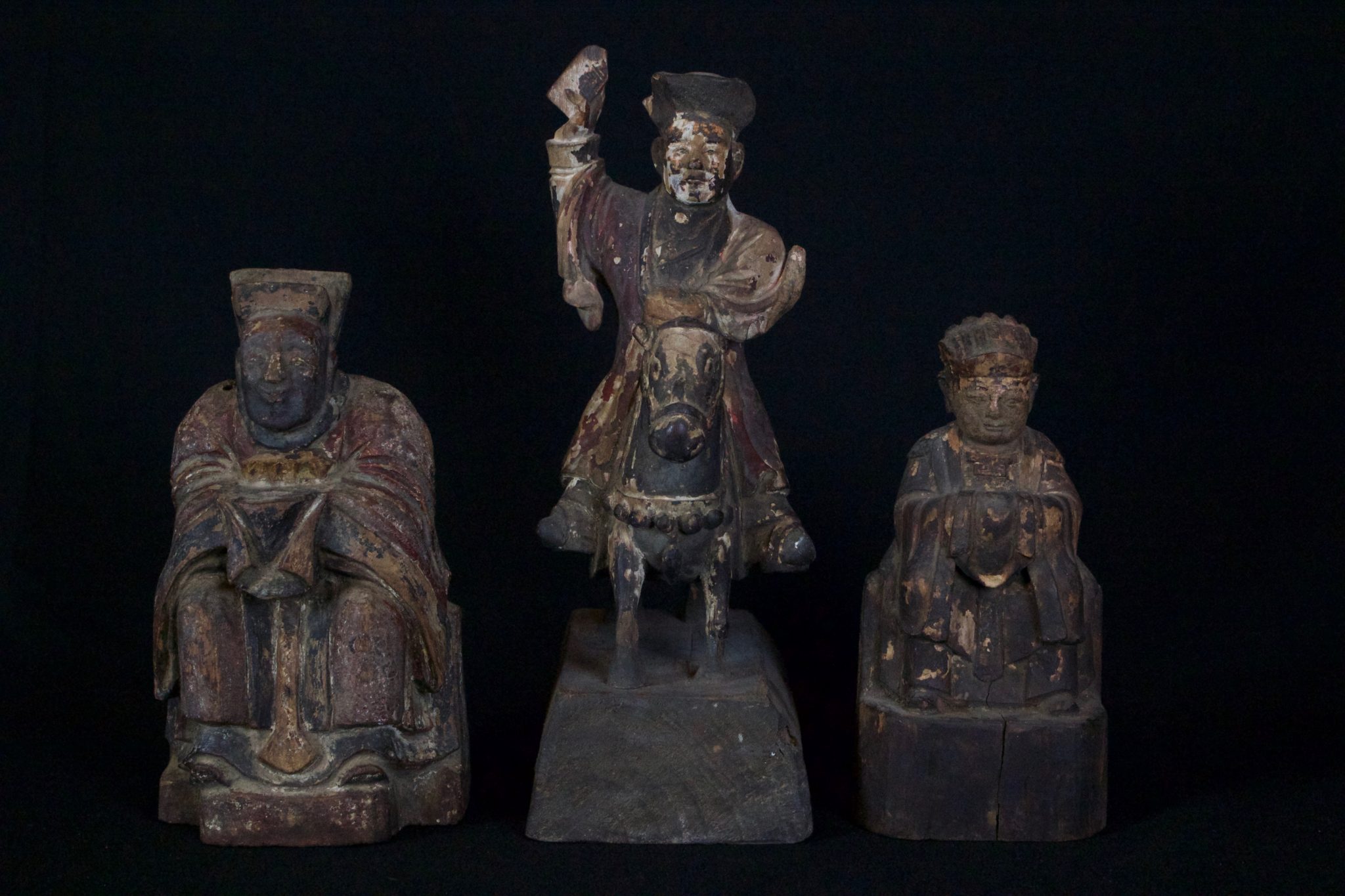
Kept in a Shaman’s home. Part of the items required to contact the spirit world. Every shaman has a set of three ‘Zhu Zhong Fan’ figures. They are: ‘To Sai’ – an ancestor shaman priest figure; ‘Nyut Hung’ – a seated Mandarin or God figure; and ‘Khong Zhao’ – a protecting officer or messenger to the gods. He is always mounted and brandishing a sword or pennant. They are only sacred once they are gifted with a soul. A ceremony is performed calling for the deity or ancestor to enter the figure. A piece of silver and some threads are placed in a secret hole in the back and sealed up. This is where the soul resides. When the figure is given away or sold the silver is removed rendering the figure inert and no longer sacred. (left – ‘Nyut Hung’ figure, 8” x 4 ¼” x 2 ½”, $650); (middle – ‘Khong Zhao’ figure, 11” x 4” x 6 ¾”, $900.); (right – ‘To Sai’ figure,7” x 3 ¼” x 2 ½”, $650).
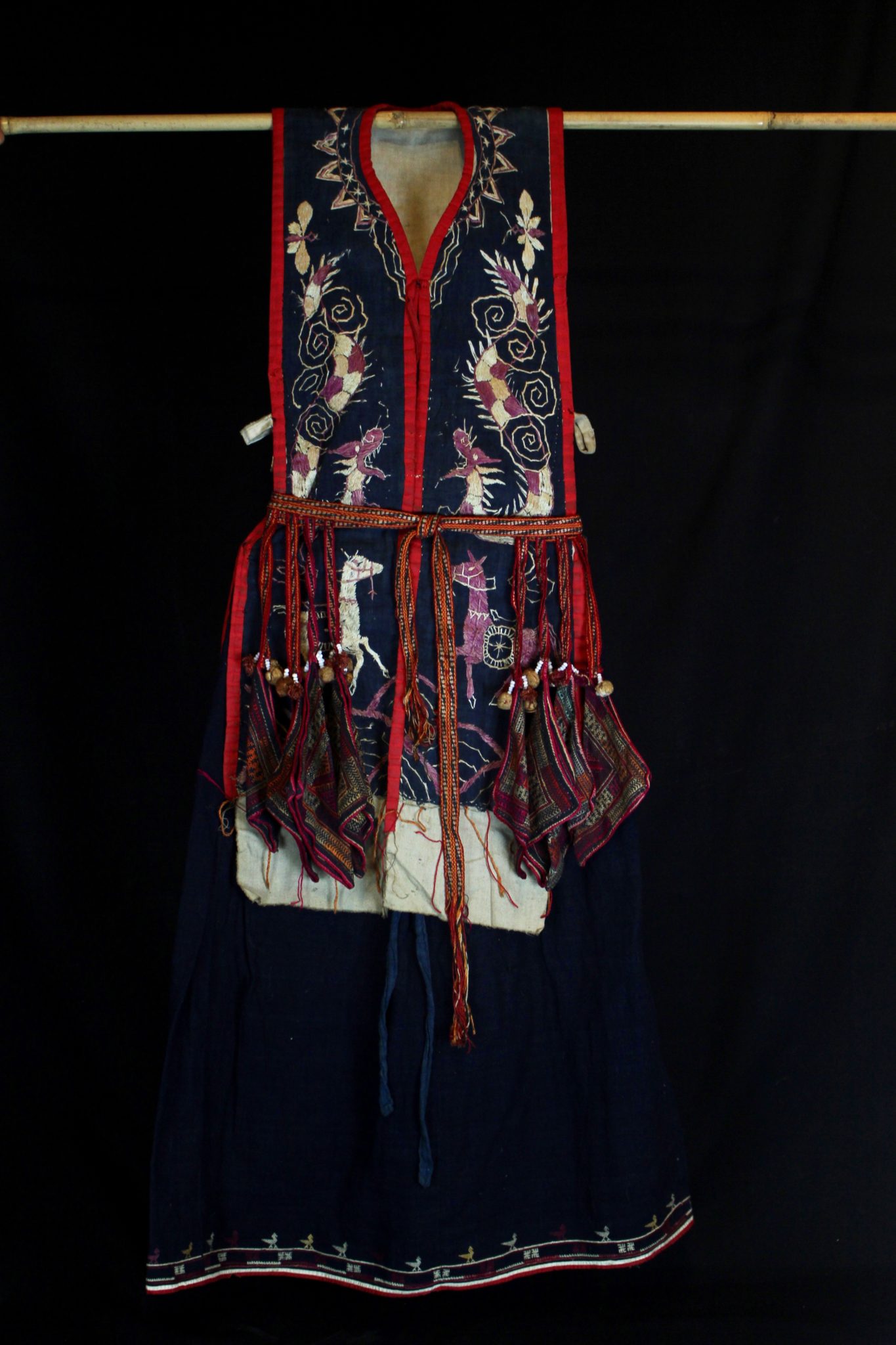
Worn only by high level shaman. The motif typically includes all the deities of heaven to clothe the shaman in the protection of the universe. Not a vain adornment, it is a reminder of man’s place in the hierarchical order. Originally a female costume. Long ago shamans were women and men the providers. Not being encumbered by childbirth and rearing, men replaces women as shamans but retained this part of the sacred costume. *more information available. 47” x 27 ½” x 3”, $3100.
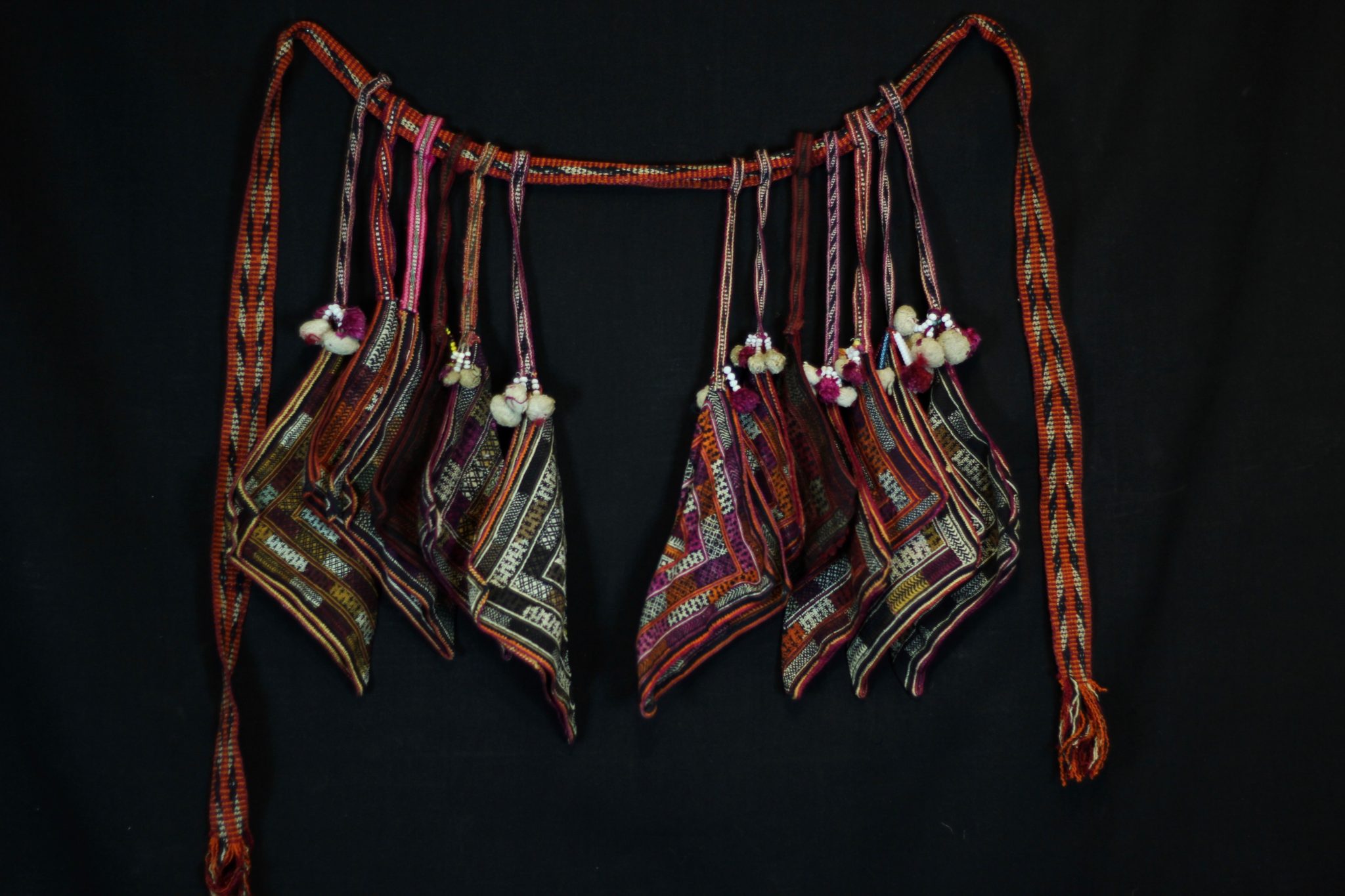
Worn by shaman while performing religious rituals. A complete belt would have a minimum of 12 handkerchiefs (embroidered squares). The belt is passed down through generations, revealing its history. If a shaman has two sons or apprentices, he will spit the belt and the new shaman’s wife would make the other necessary handkerchiefs. Several generations are represented in this belt. 75” x 18” x 2 ½”, $775.
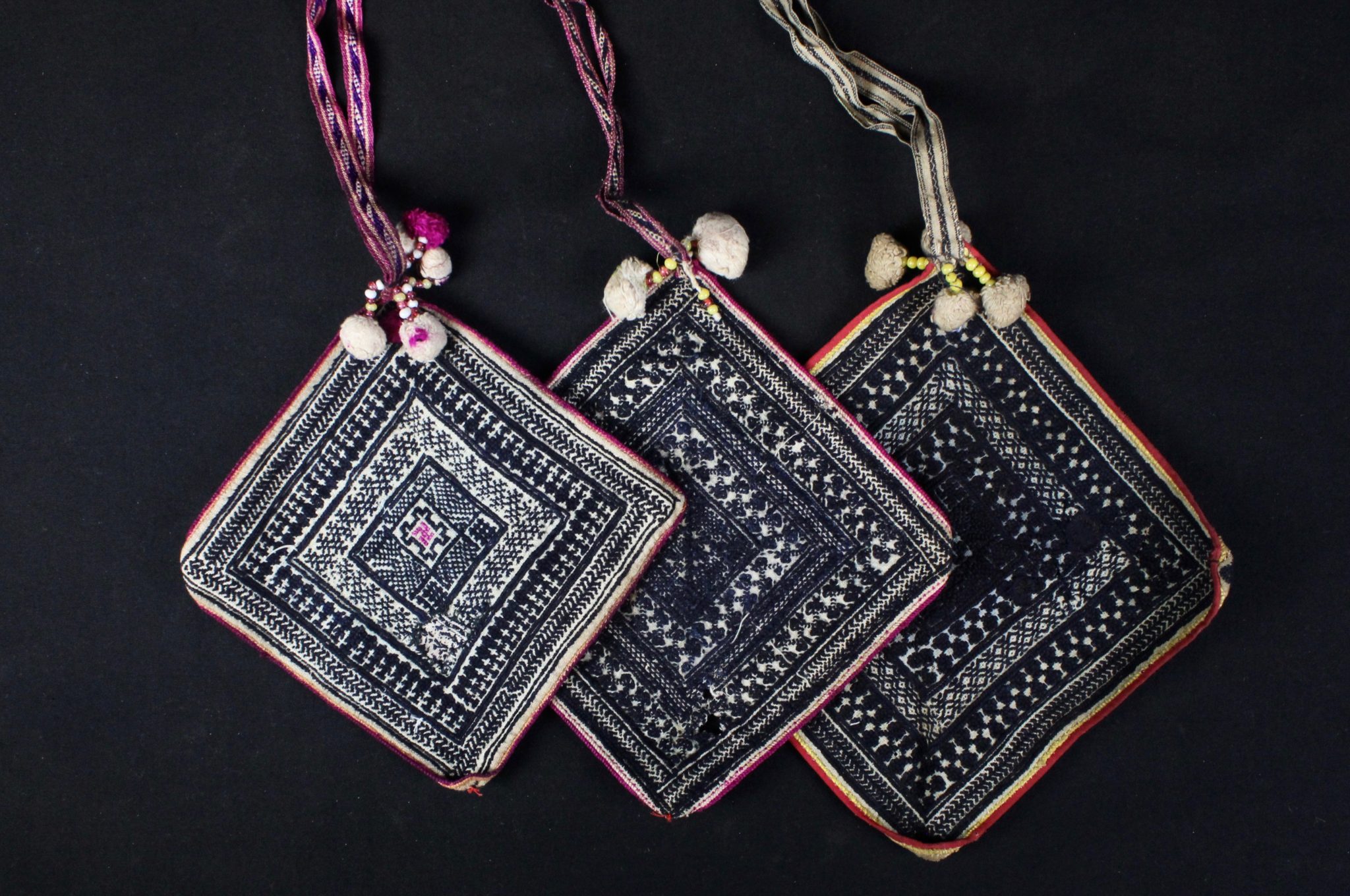
Worn by shaman while performing religious rituals. A complete belt would have a minimum of 12 squares (handkerchiefs). The belt is passed down through generations, revealing its history. $75. to $90.
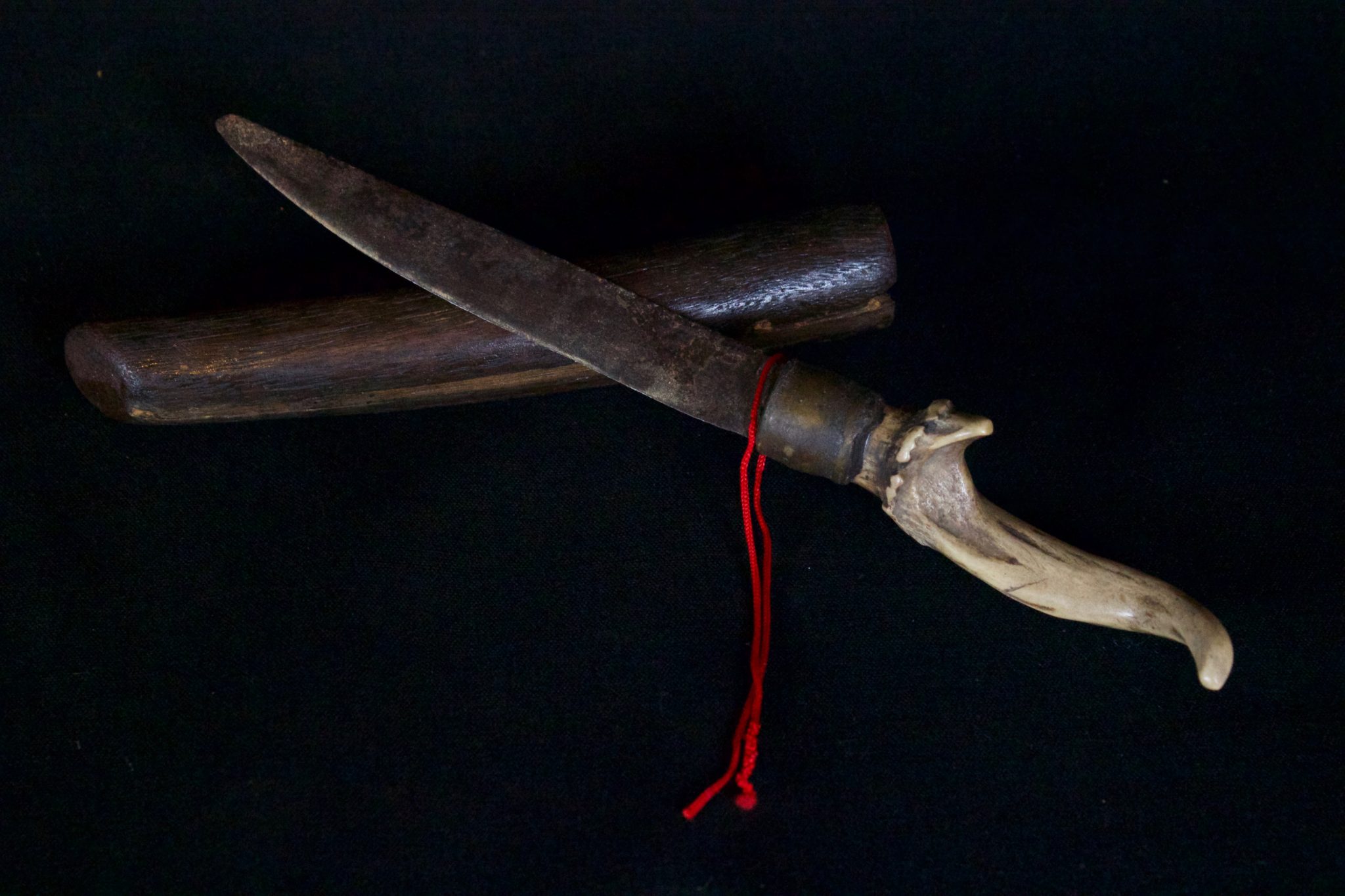
Used in sacred rituals. 10” x 1 ½” x 1”, $580.
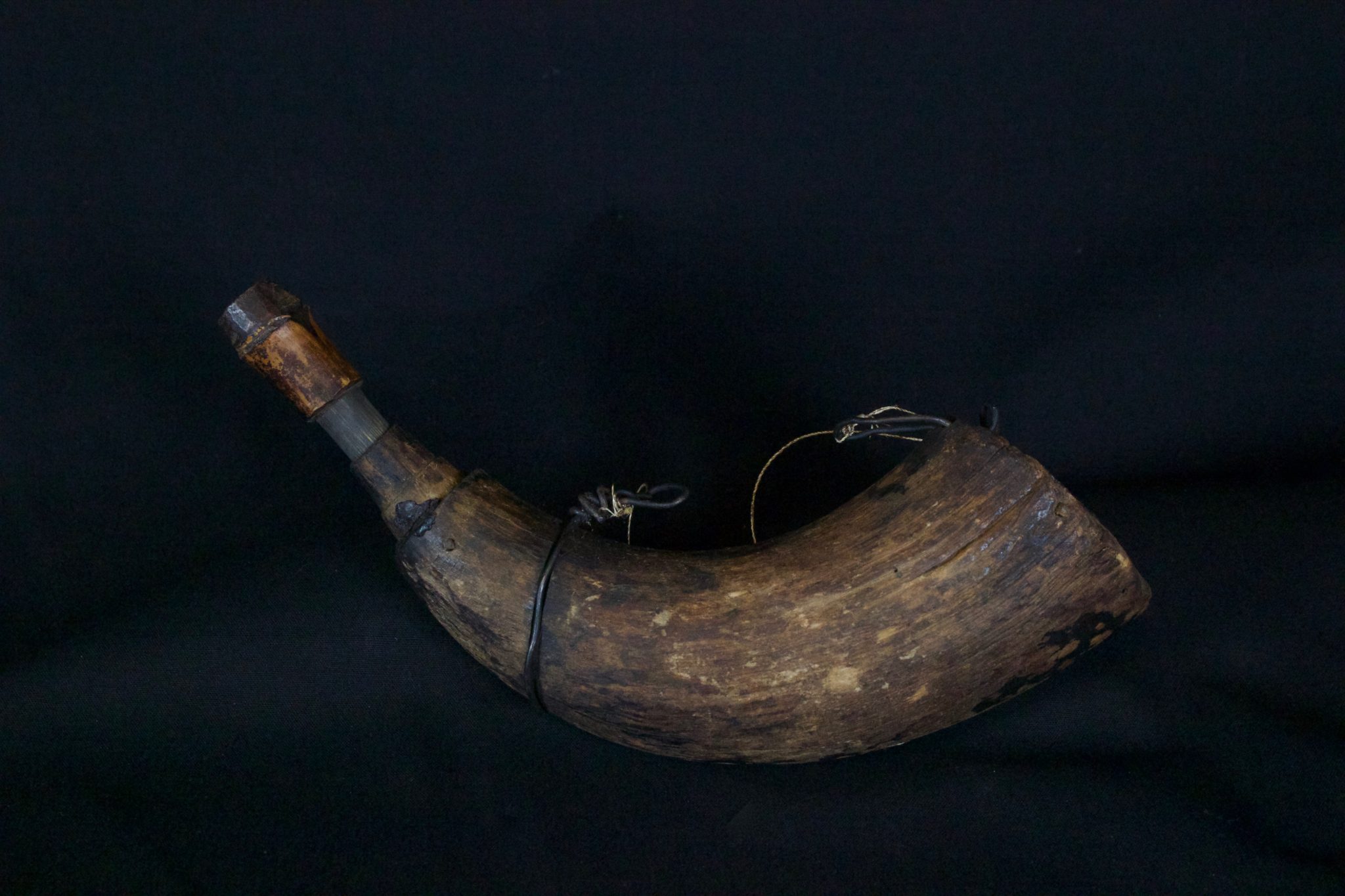
To carry medicinal remedies used in healing rituals, 10” x 4” x 2 ½”, $420.

Printing blocks are important shaman tools for creating talismans and ghost money to burn as offerings to deities. They were stamped on paper or on envelopes to mark the contents as holy. (Top – 2 ¼” x ½’ x 5’, $110.); (Bottom, 1 ¾” x 6 ¼” x 1”, $90.) see image below for example of a print
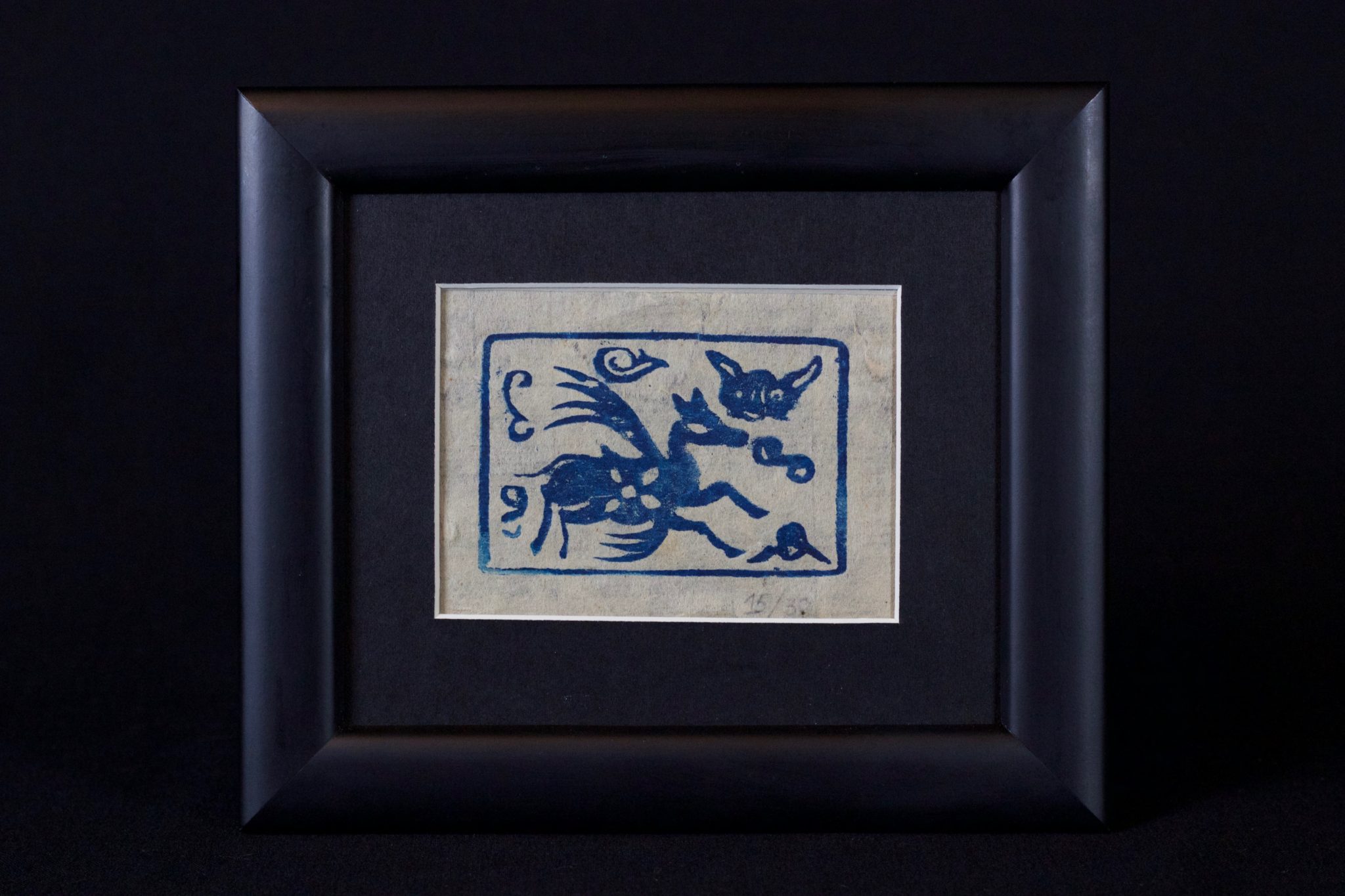
Print from a hand carved shamanic printing block (see previous image). The print would be burned for carrying a message to deities for protecting people against evil spirits. ‘Do’ paper is made from the bark of Rhamnoneuron balansae tree. This one is for a variety of ceremonies: initiation of a shaman; fending off evil spirits; building a house or farm structure, 6 ¼” x 7 ¼” x ¾”, SOLD
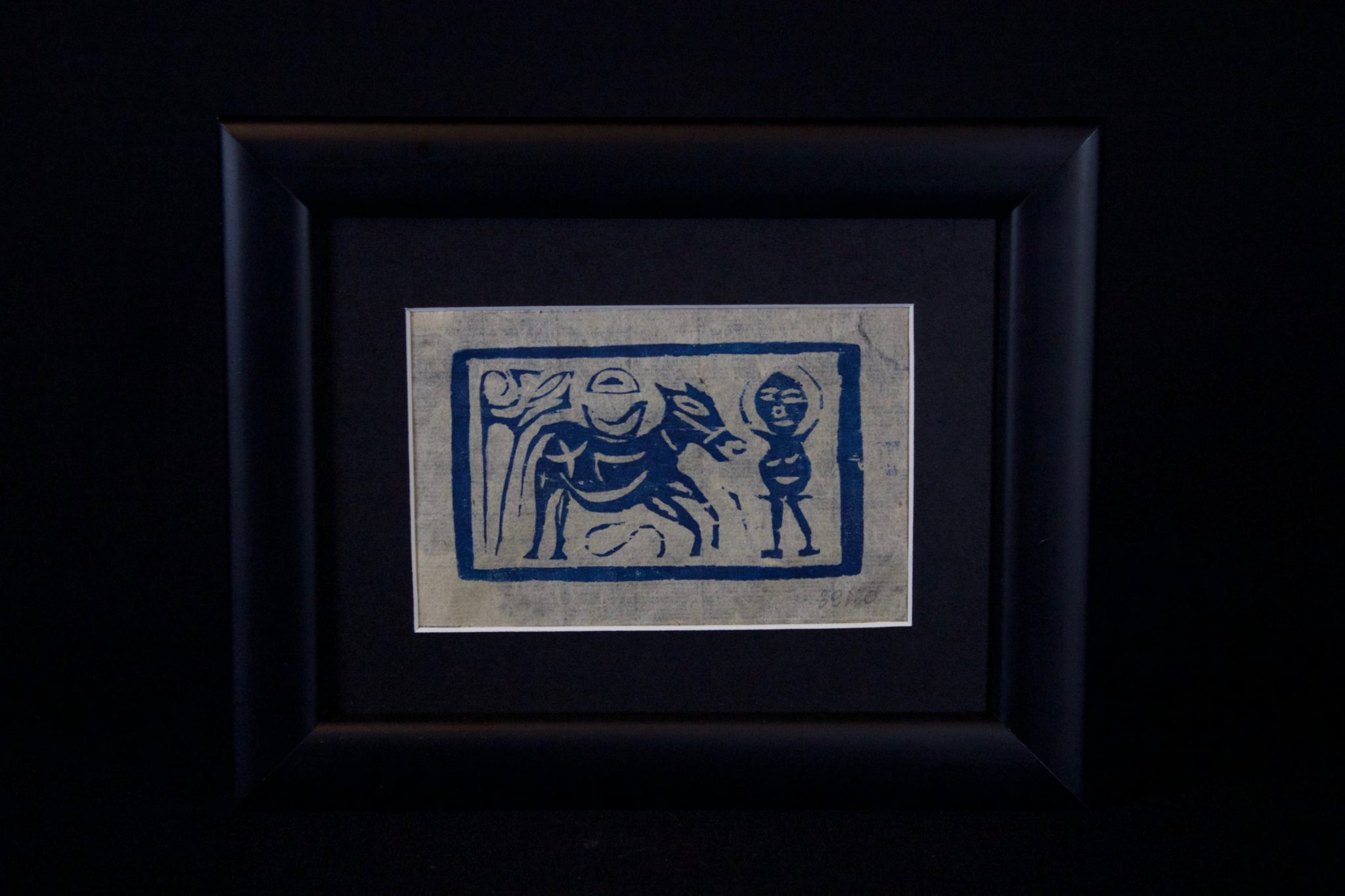
This print is for worshiping the stars in an effort to relieve someone’s run of bad luck, 7” x 10 ¾” x ¾”, SOLD
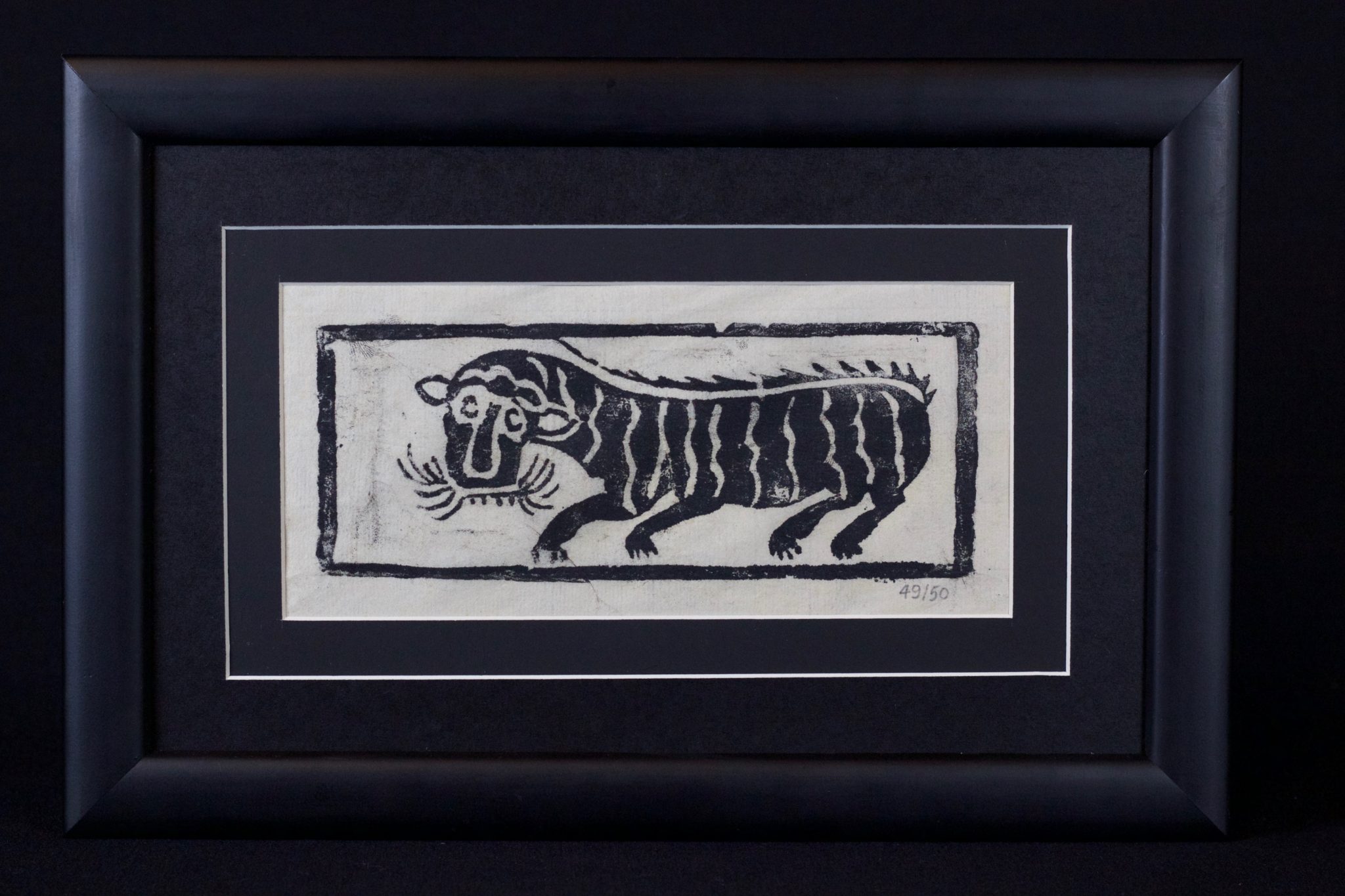
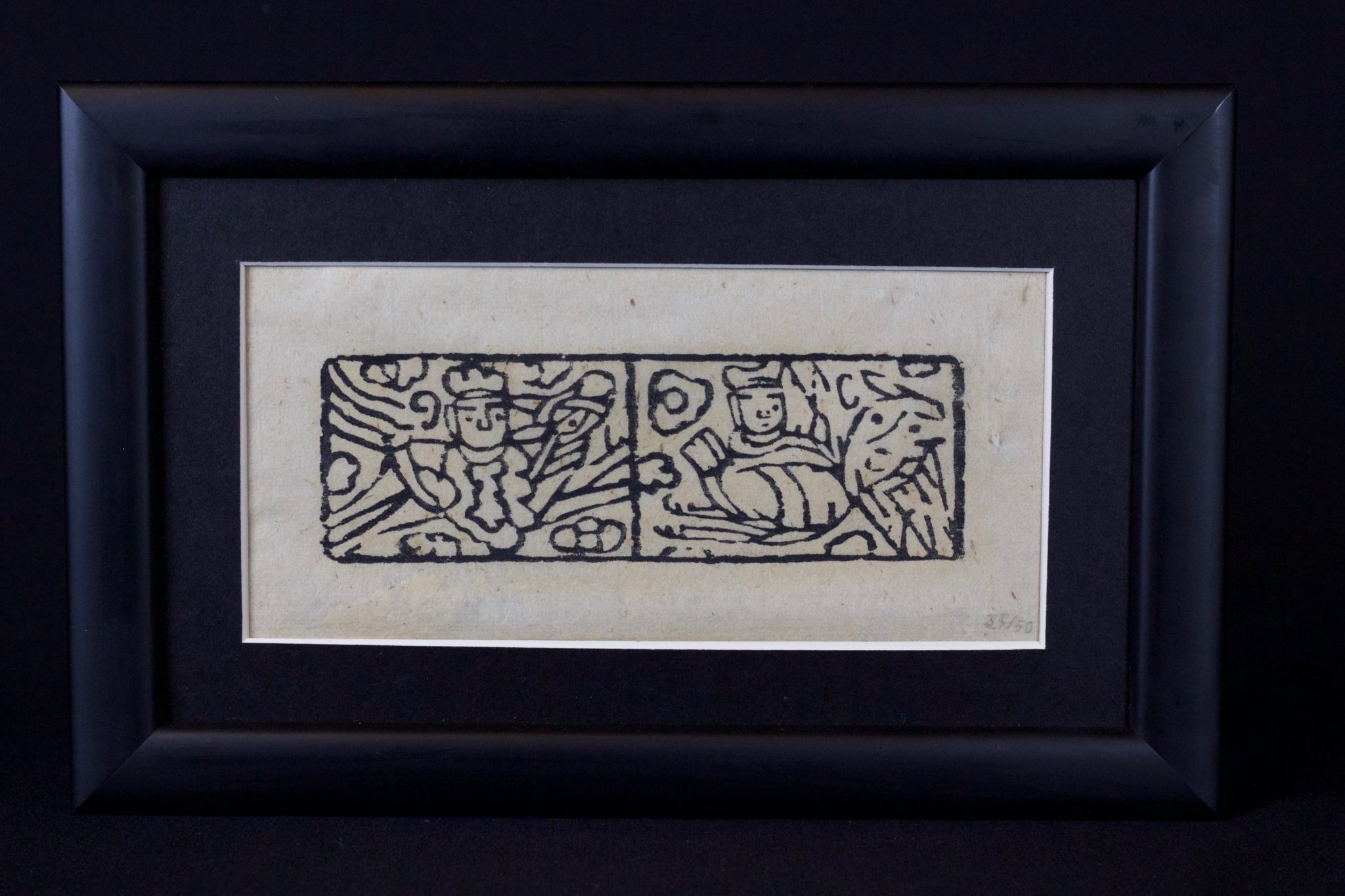
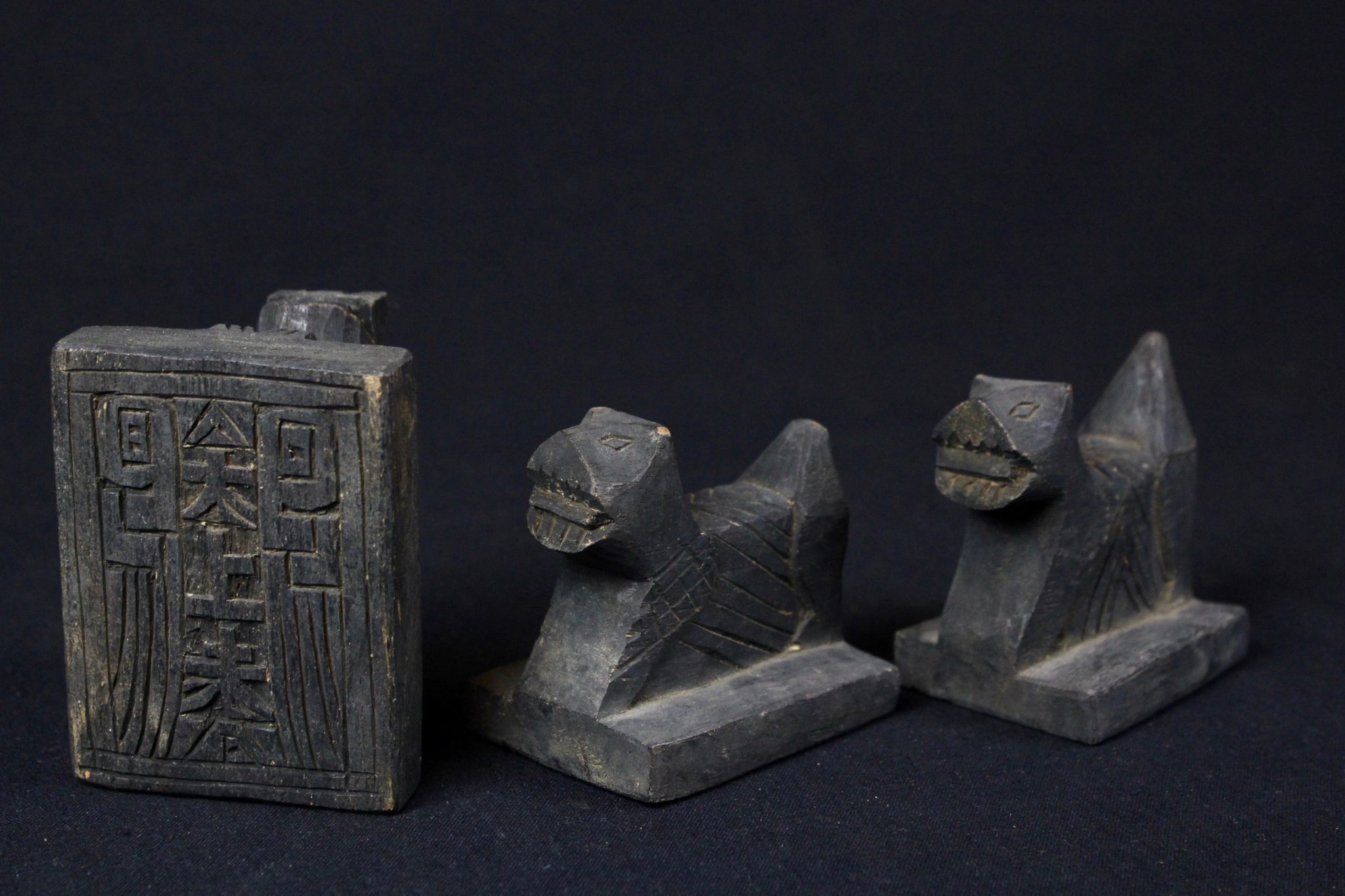
Important tool for a shaman. They are unique to a particular shaman and used as a mark of authenticity. They would be placed on a message from one shaman to another, to the deities or into the shaman’s book. $50./$60. each – Dimensions left to right: (left -2 ¾” x 2 ¼” x 3 ½”, $60.); (middle – 2 ¾” x 2” x 2 ¾”, $50.); (right – 2 ¾” x 1 ¾” x 2 ¾”, $50.)
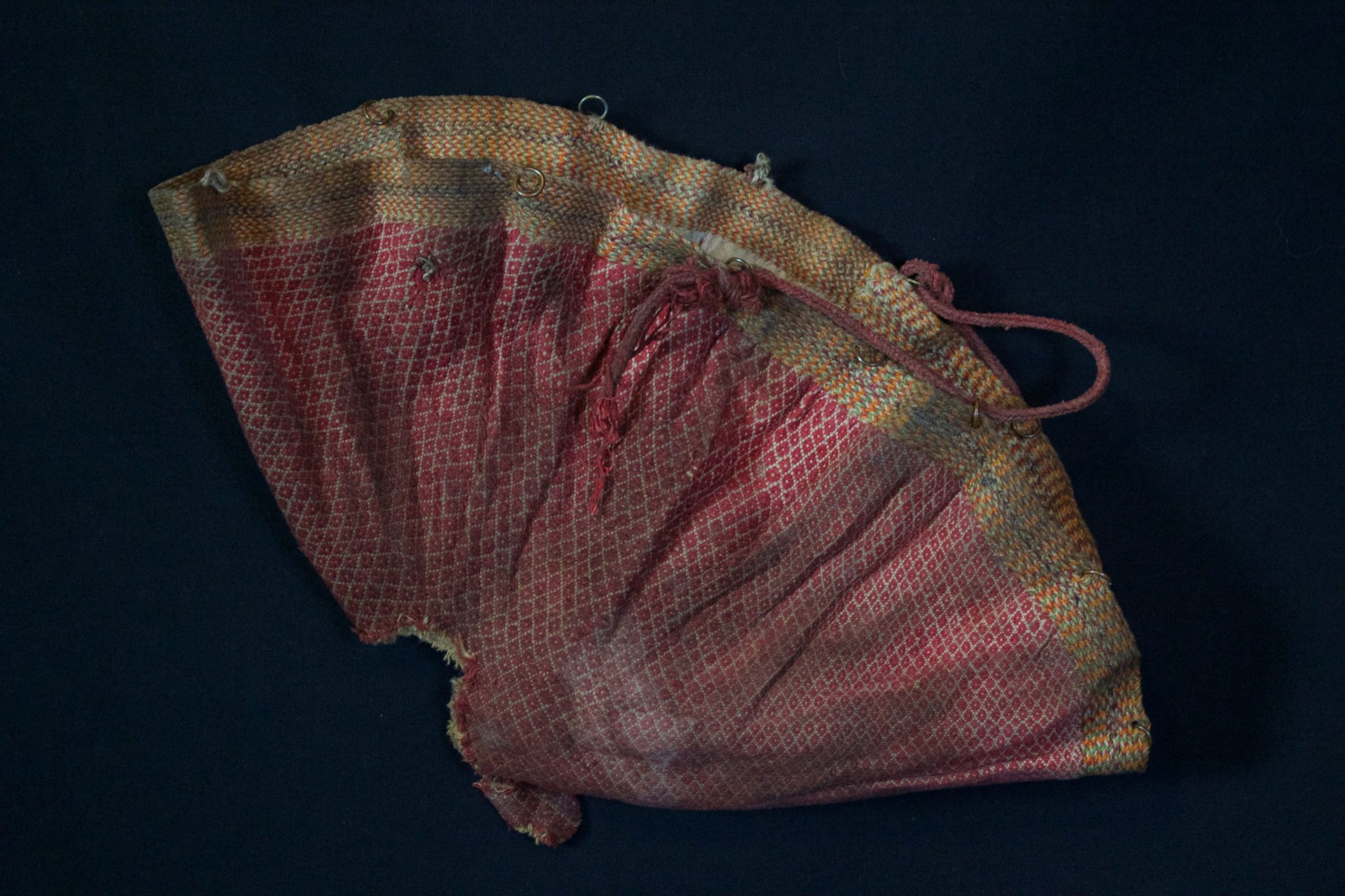
Shaman use a bag or purse to keep and carry magic ritual items. 8” x 15” x ½”, $70.
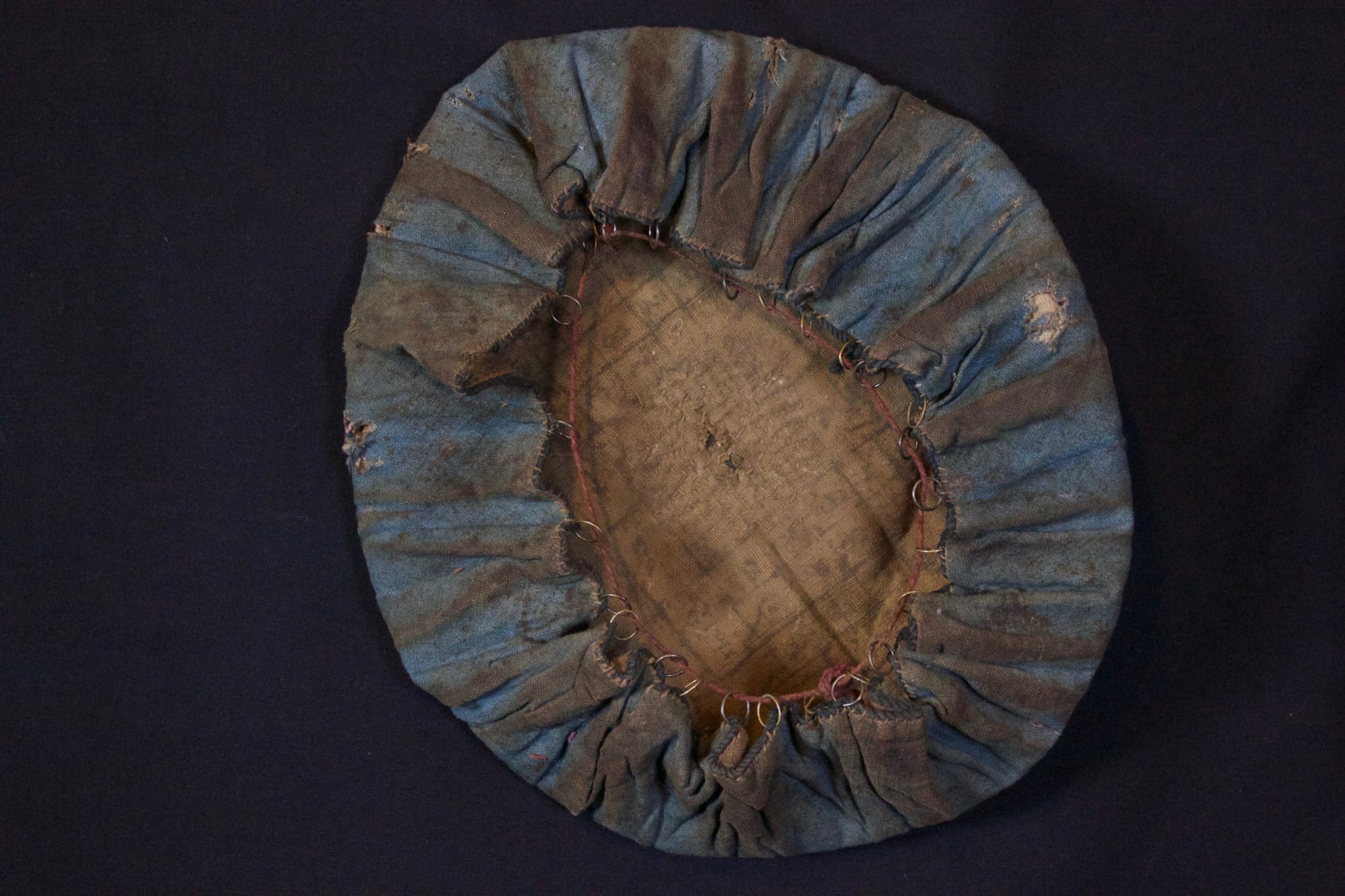
Bag or Purse to carry magic ritual items, 11” x 17” x ½”, $120.
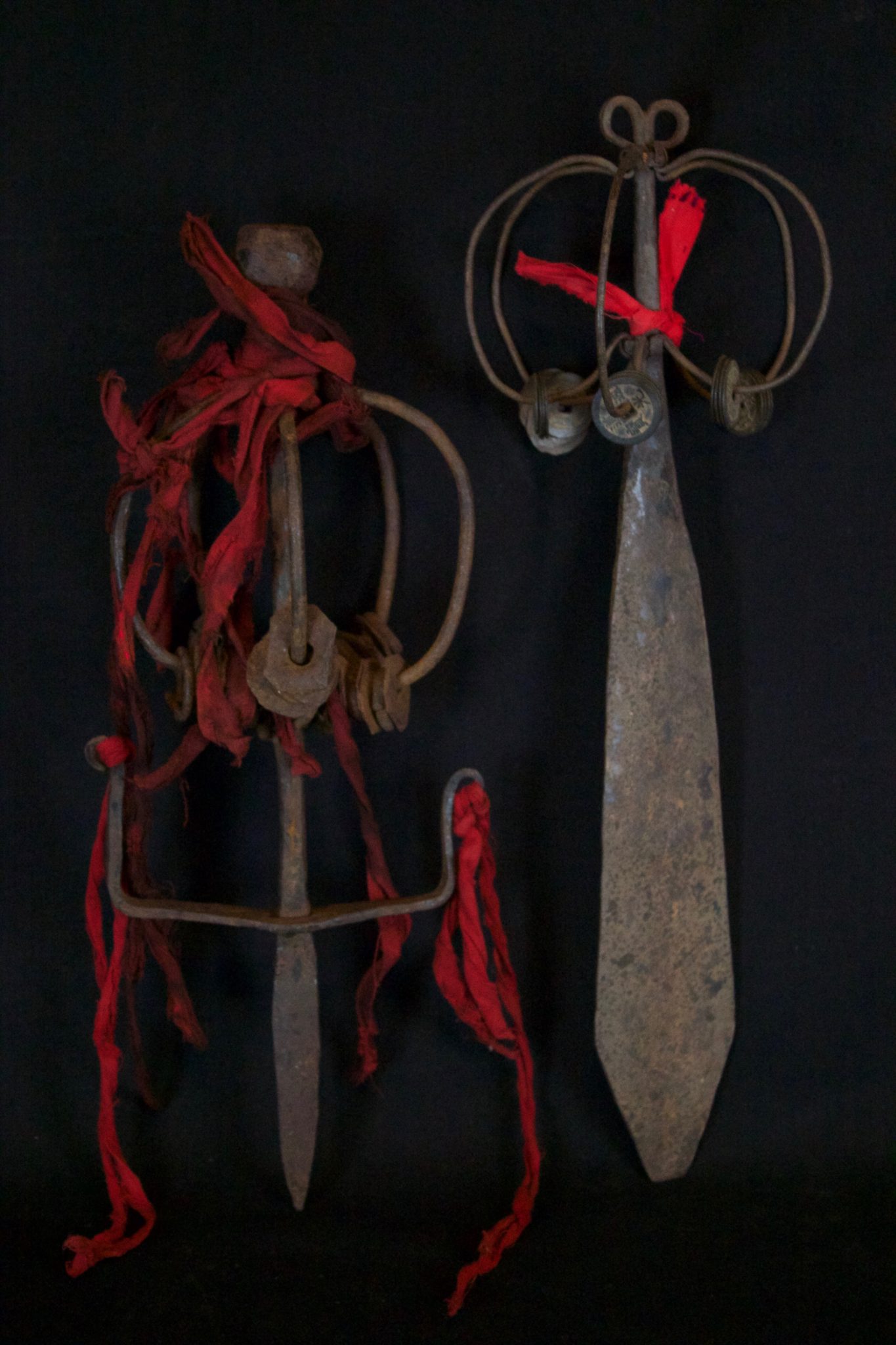
These commanding rattle daggers are the most common ritual weapon used by a shaman priest. Similar in function to swords, they fend off evil spirits when shaken. The red streamers attract cosmic energy to empower it. The coin-laden top is still wound with red streamers from the ceremony it was last used in. Dimensions (left – 15” x 6 ¼” x 4 ½”, $350 SOLD); (right – 16 ½” x 5 ½” x 5”, $350. SOLD)
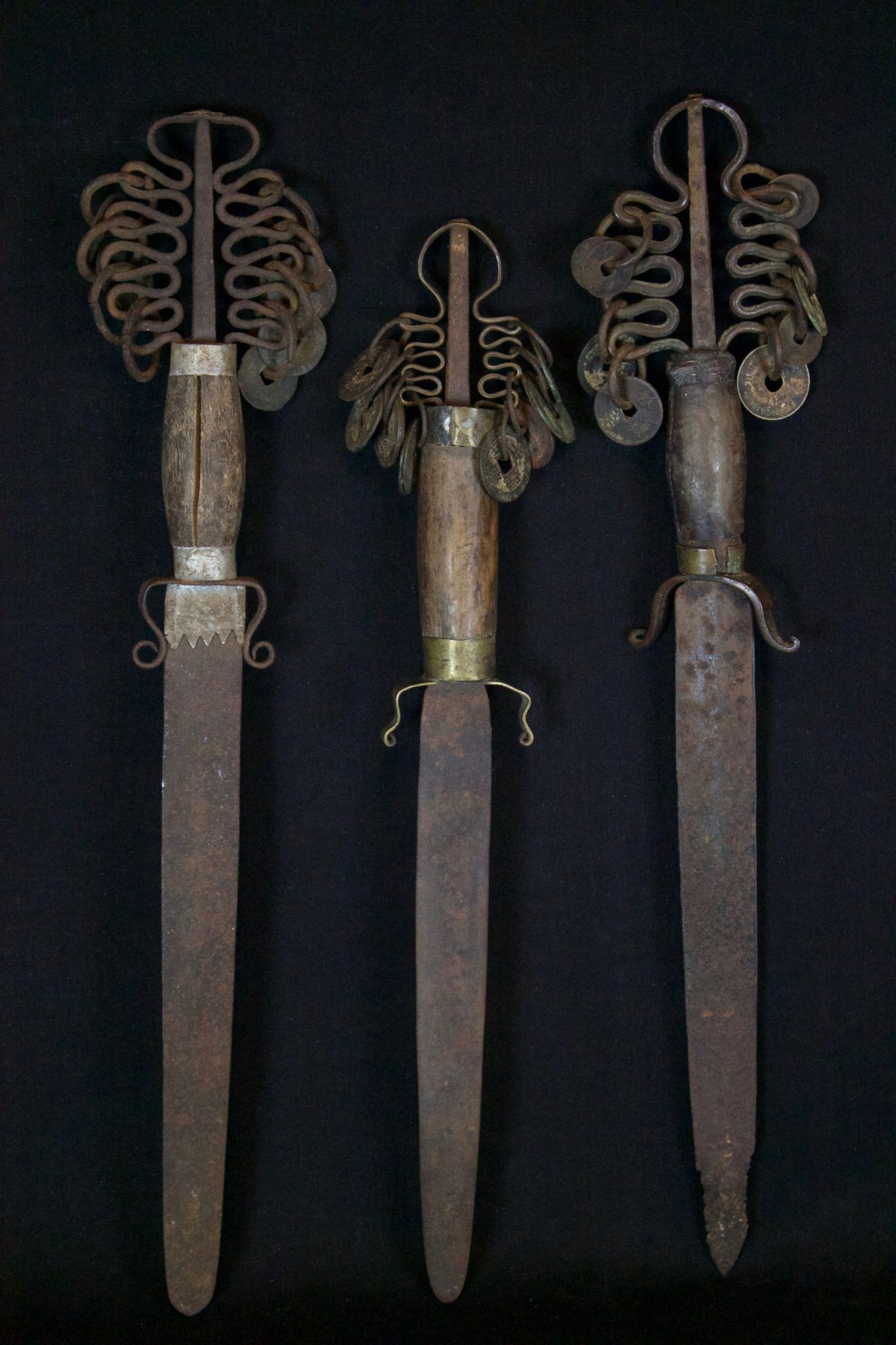
An essential item for any Yao shaman ritual. Used to summon gods and goddesses and to punish disobedient spirits. Harmless to mortals, but a formidable weapon when shaken against evil spirits. This is a male sword – top detail differs on female swords. $295. each, Dimensions left to right, (left – 15 ¼” x 3 ¼” x 1” SOLD); (middle – 15 ¼” x 3 ¼” x 1” SOLD); (right -13 ¾” x 3” x 1”)
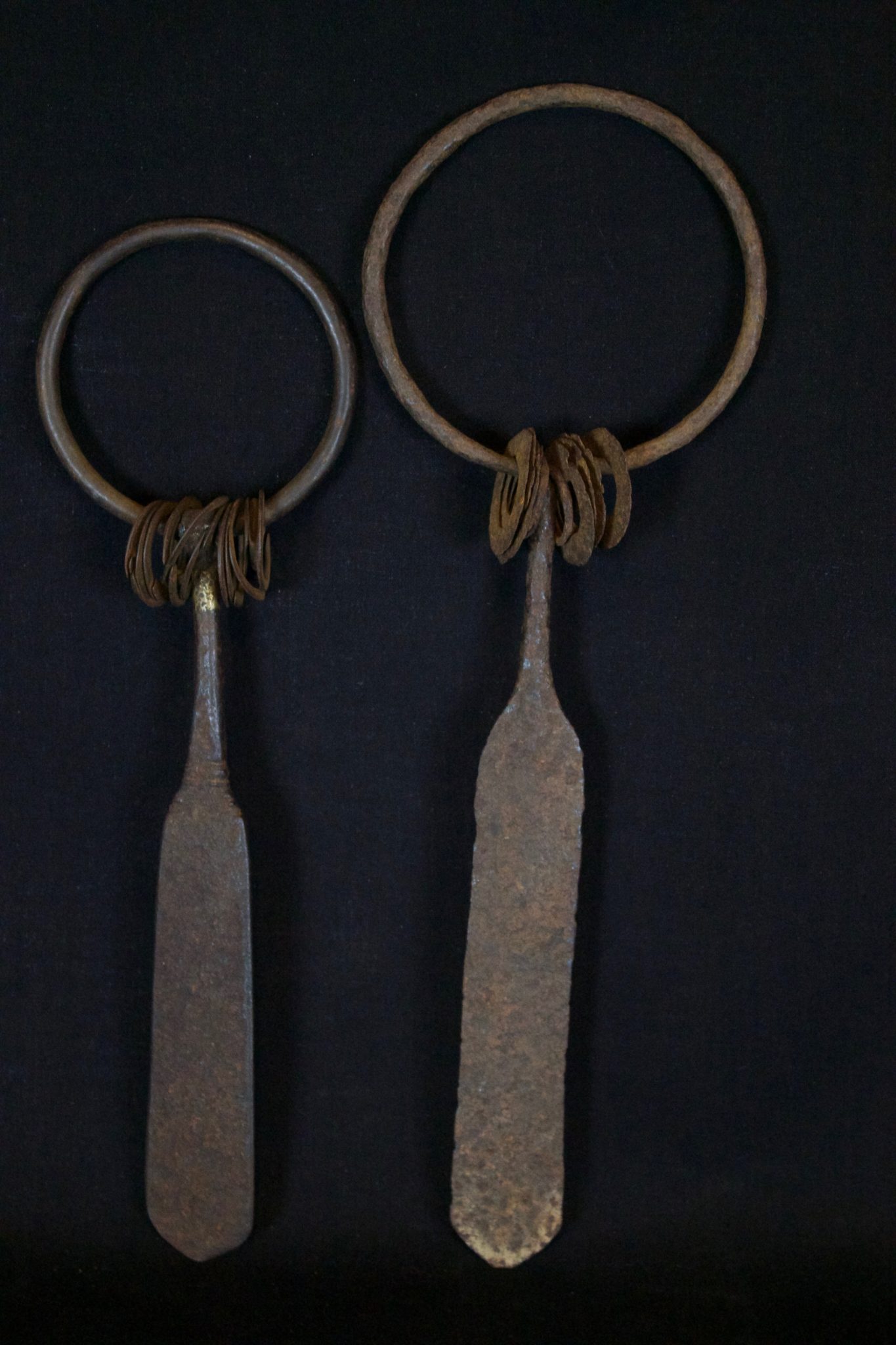
Ritual Dragon Knife, Vietnam, San Diu people Early 20th c, Iron, patinated with use and age, Used in rituals to subdue evil forces. (small – 12” x 3 ¾” x 1 ¼”, $270.); (large – 13 ¾” x 4 ½” x 1 ¾”, $270.)
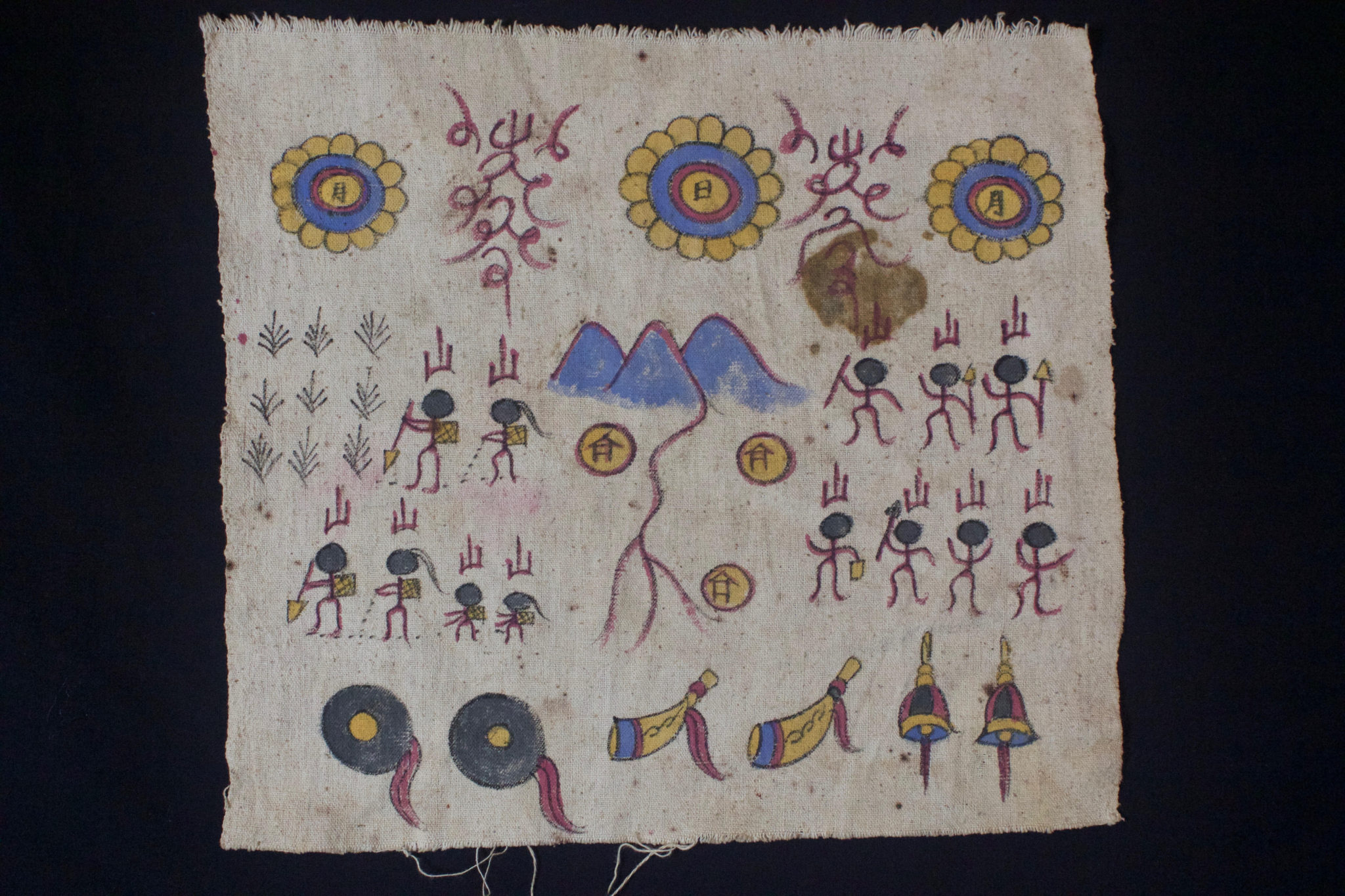
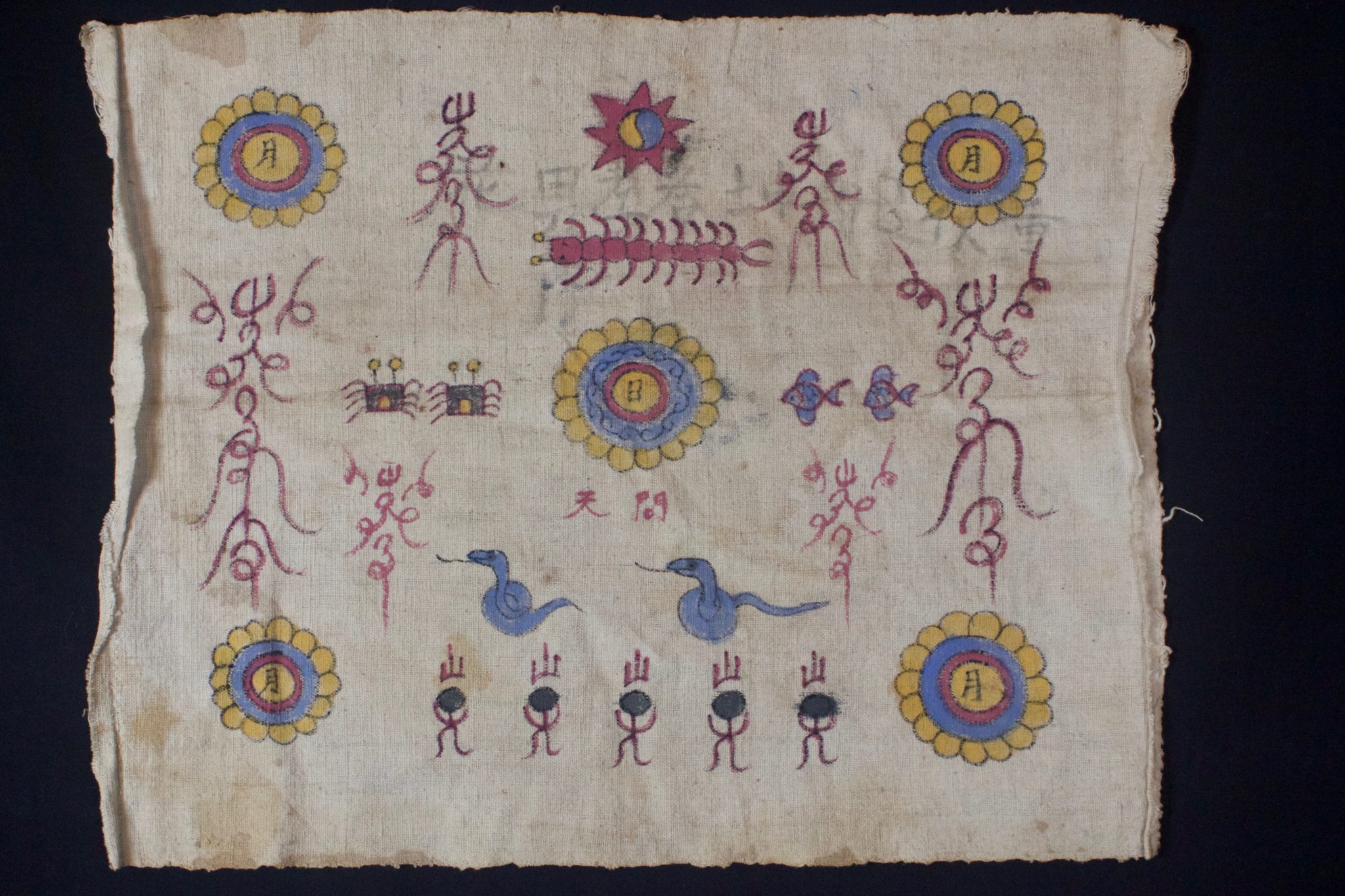
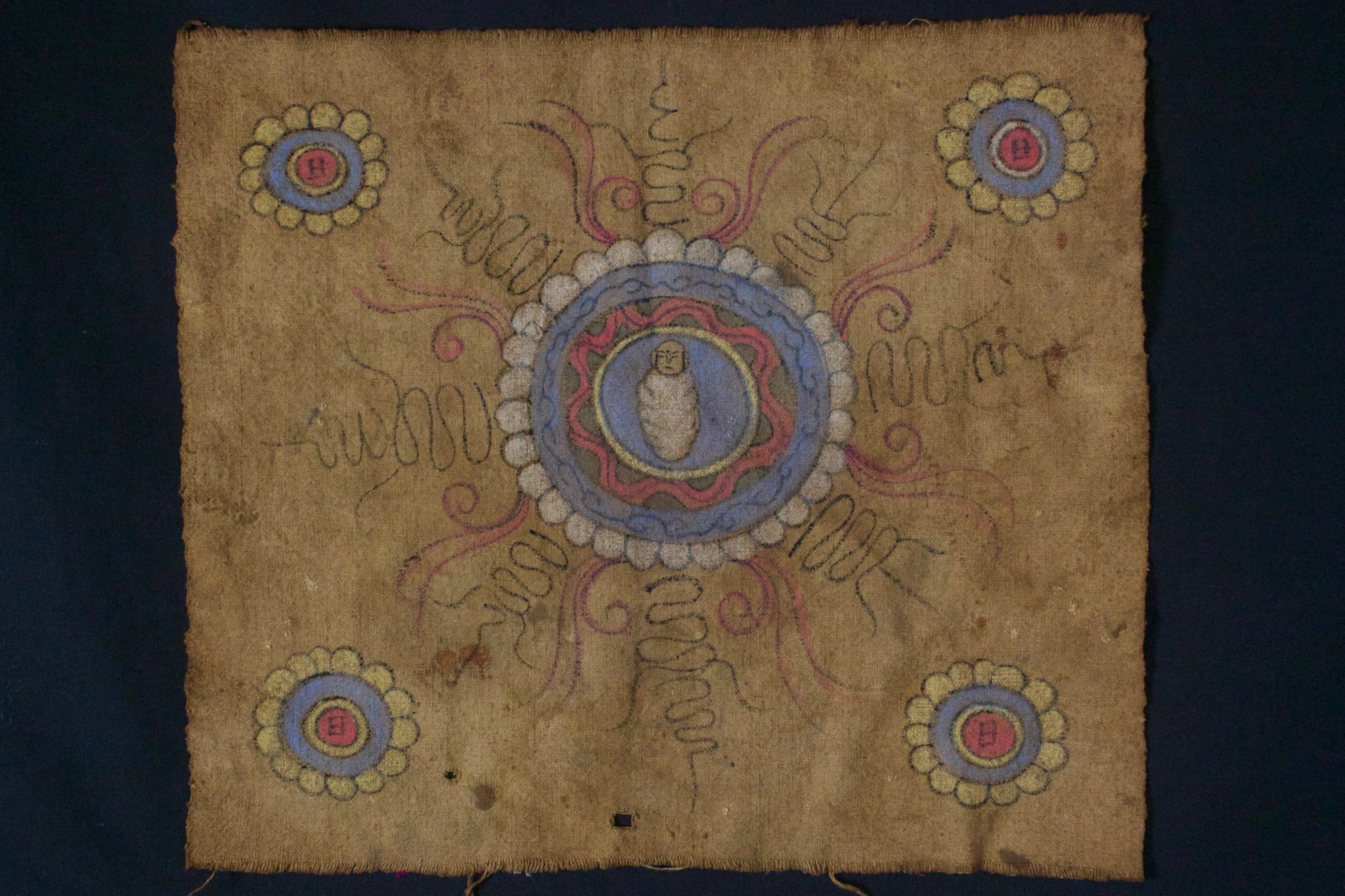
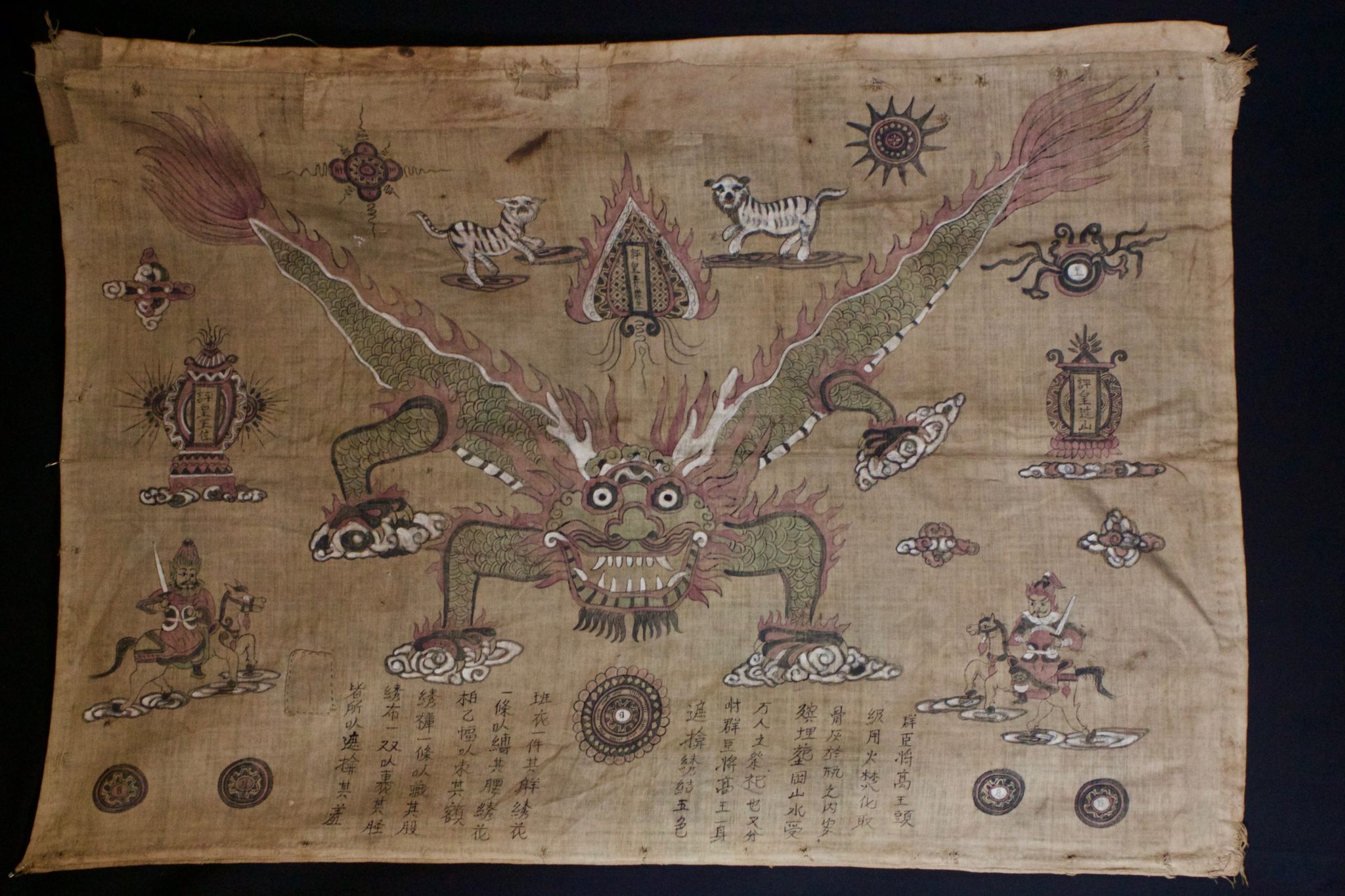
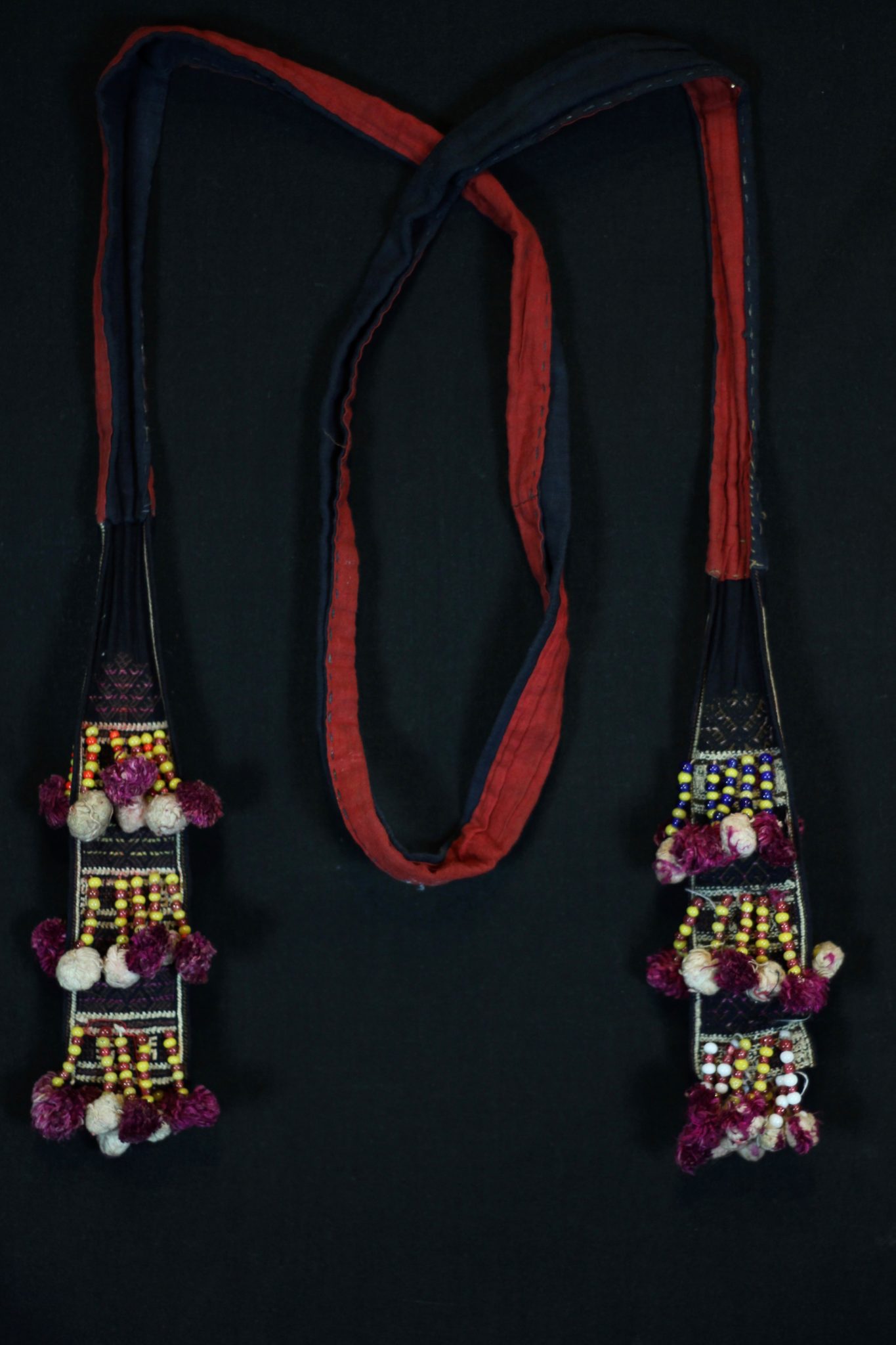
Part of shaman’s traditional ritual costume. 69 ½” x 3” x 1”, $180.
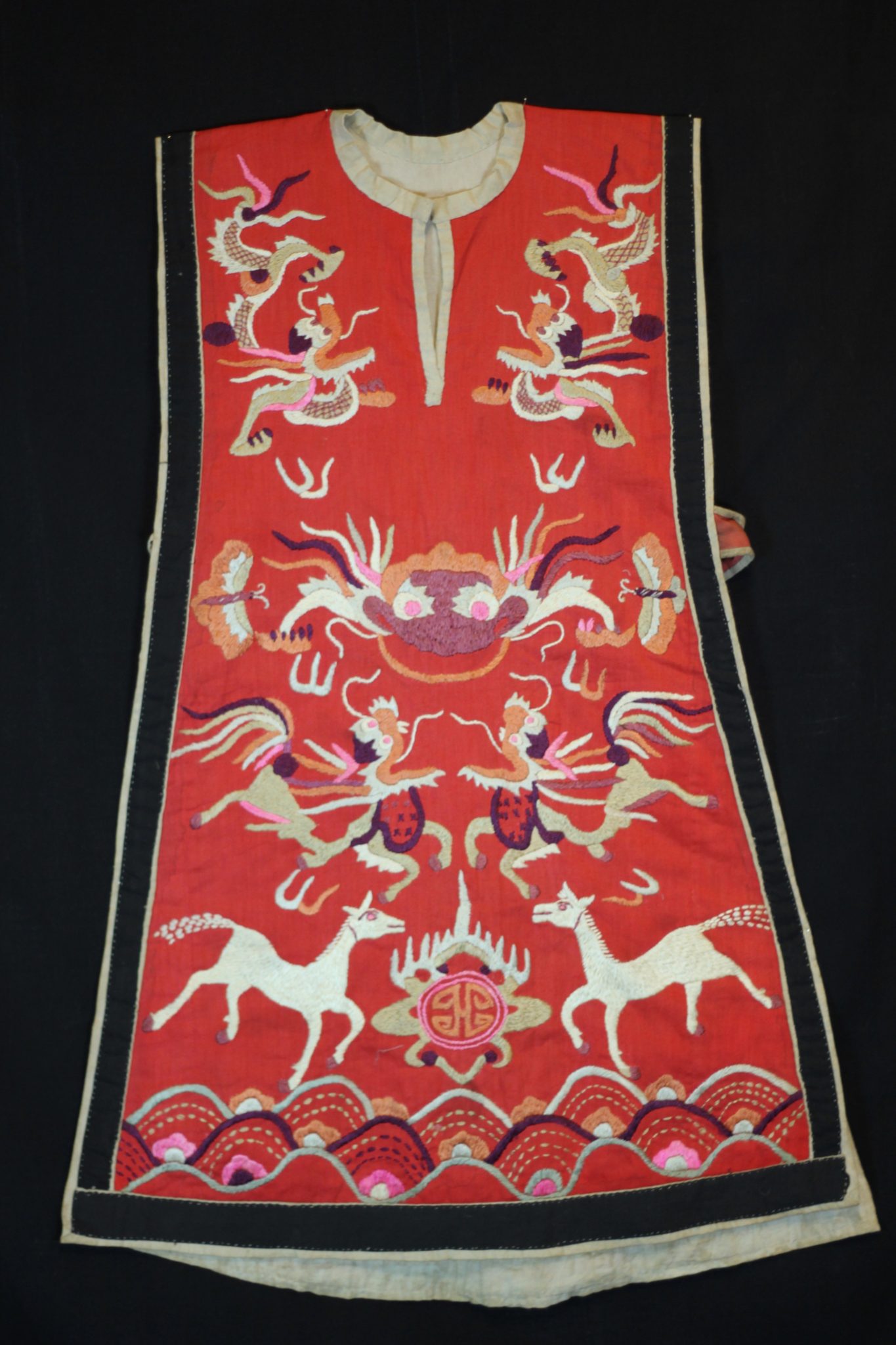
Worn only by high level shaman. The motif typically includes all the deities of heaven to clothe the shaman in the protection of the universe. Not a vain adornment, it is a reminder of man’s place in the hierarchical order. Originally a female costume. Long ago shamans were women and men the providers. Not being encumbered by childbirth and rearing, men replaces women as shamans but retained this part of the sacred costume. 34” x 24”, $2800.
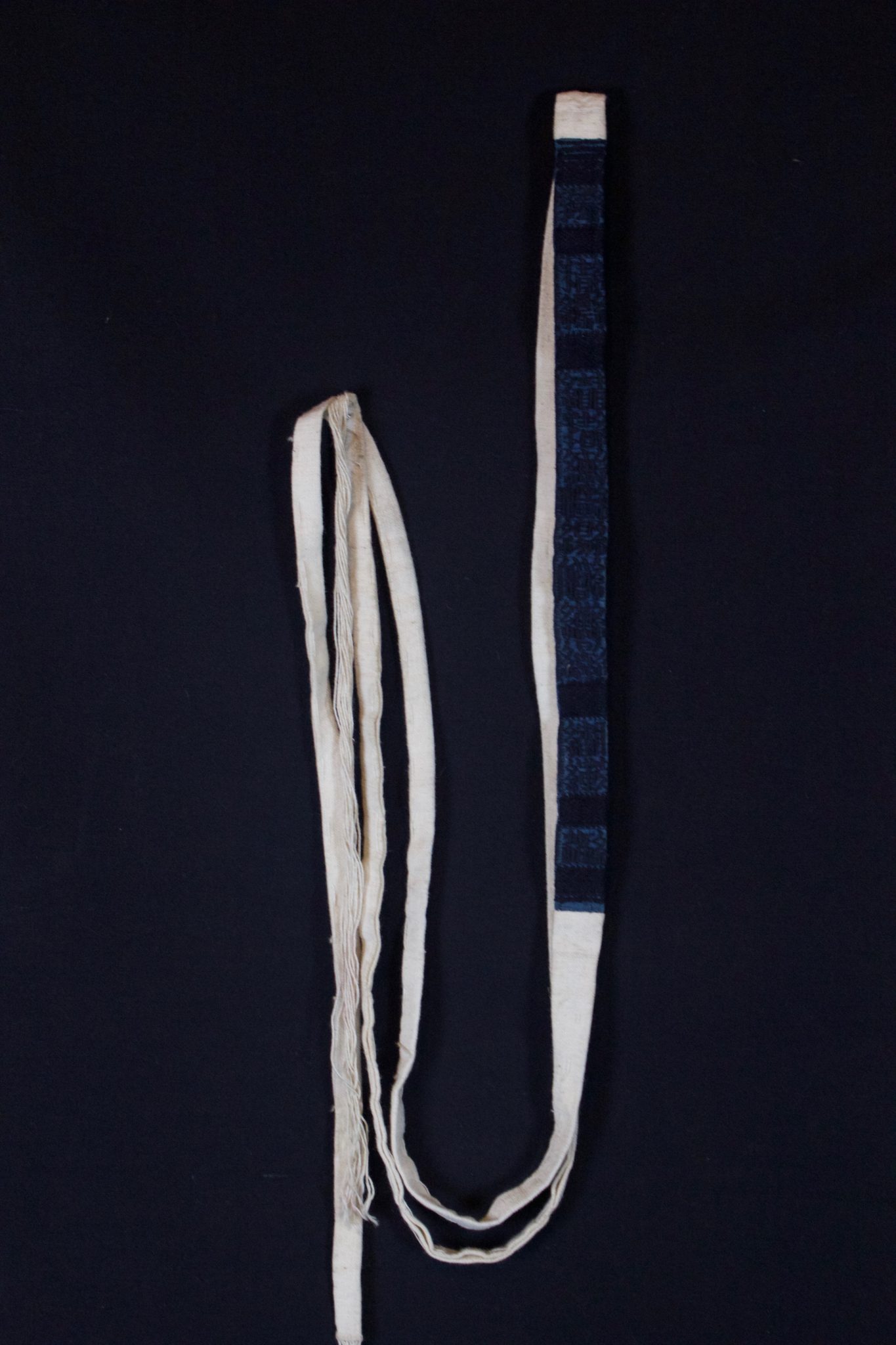
Part of shaman’s traditional costume. 110” x ¾”” x ⅛”, $30.

Worn only by high level priest/shaman. The motif typically includes all the deities of heaven to clothe the shaman in the universe for protection. Not a vain adornment, it is a reminder of man’s place in the hierarchical order. Originally a female costume. Long ago shamans were women and men the providers. Not being encumbered by childbirth and rearing, men replaces women as shamans but retained this part of the sacred costume. 49” x 29”, $2200. (see below for back view)
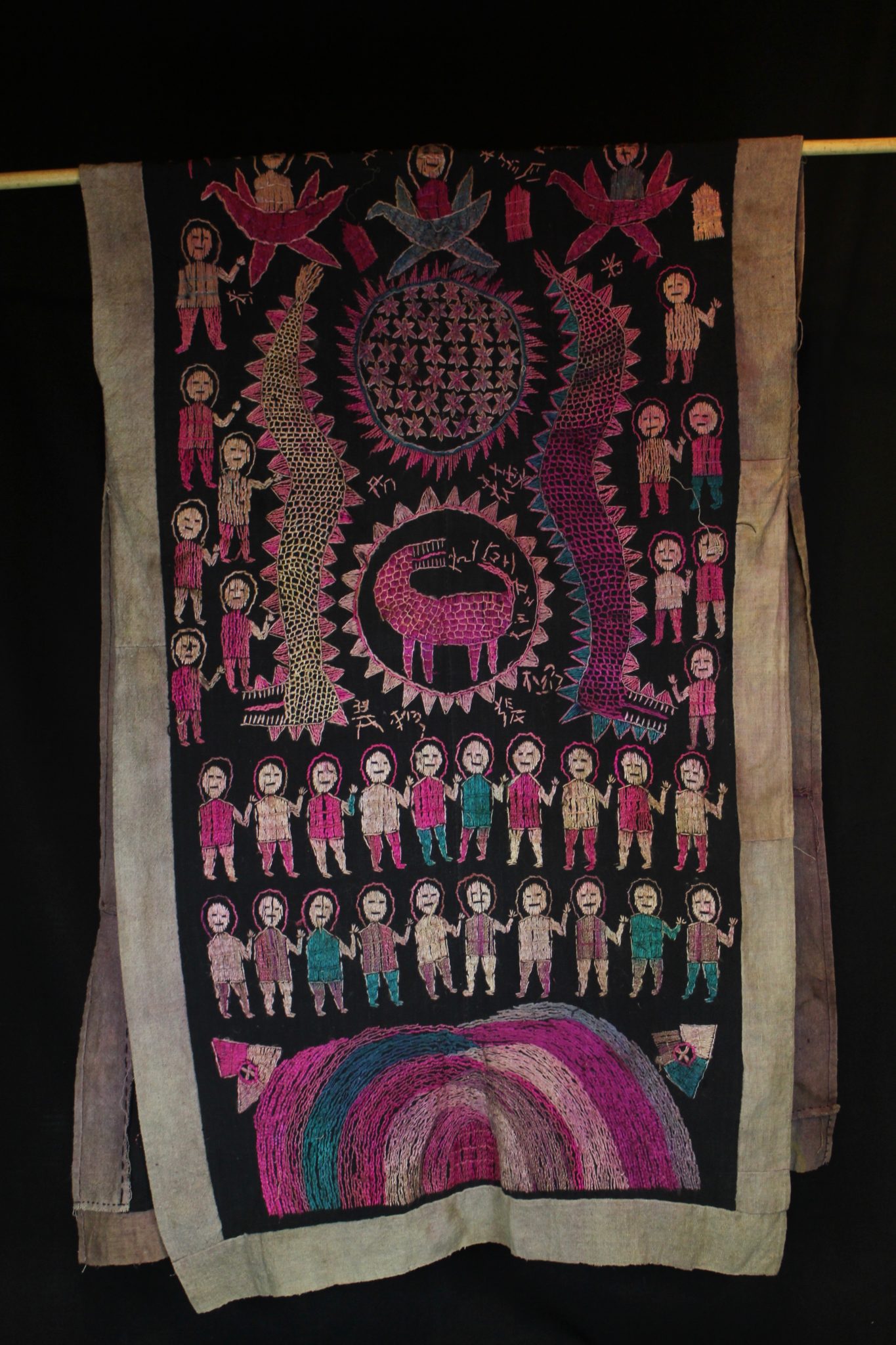
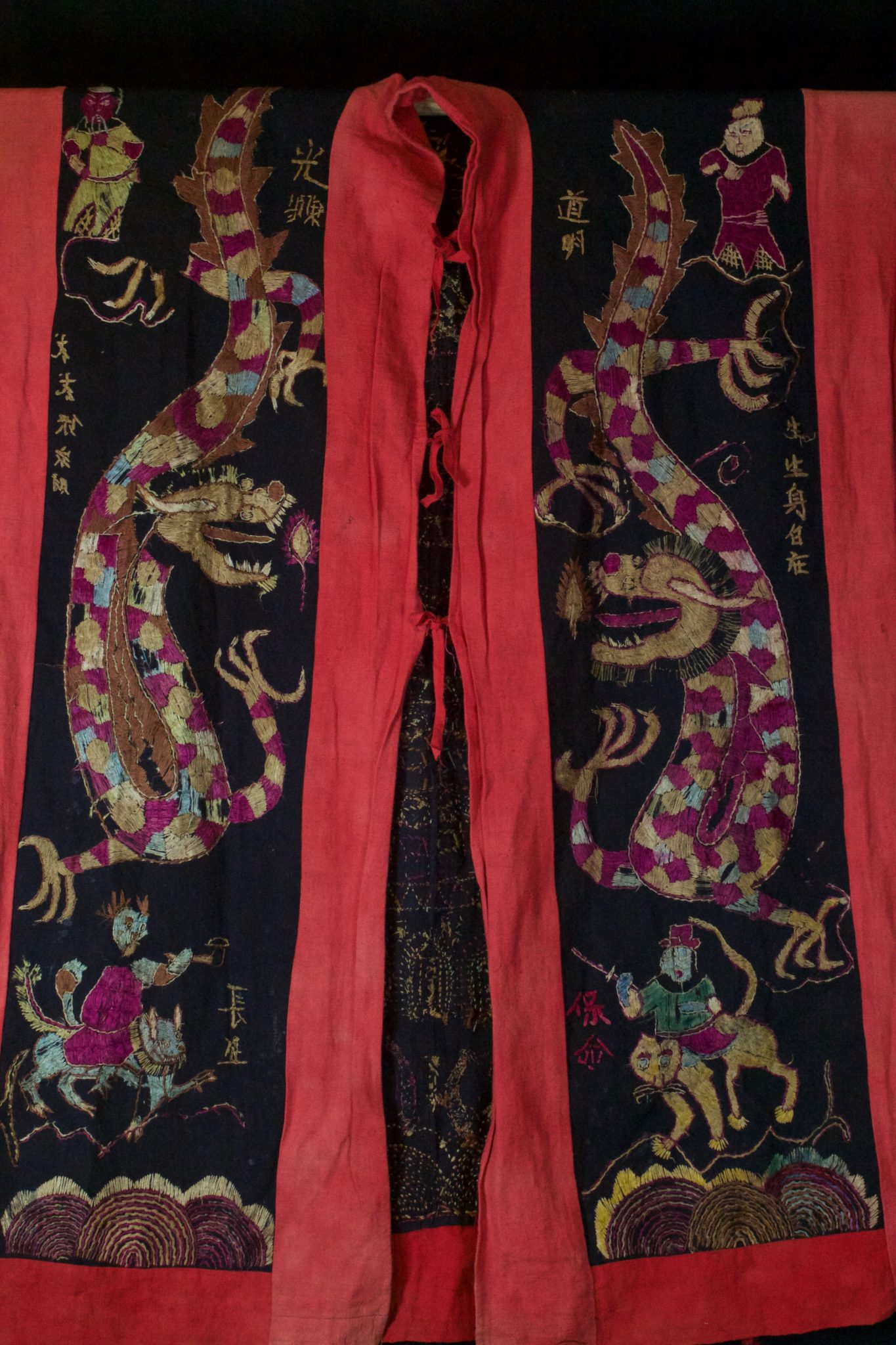
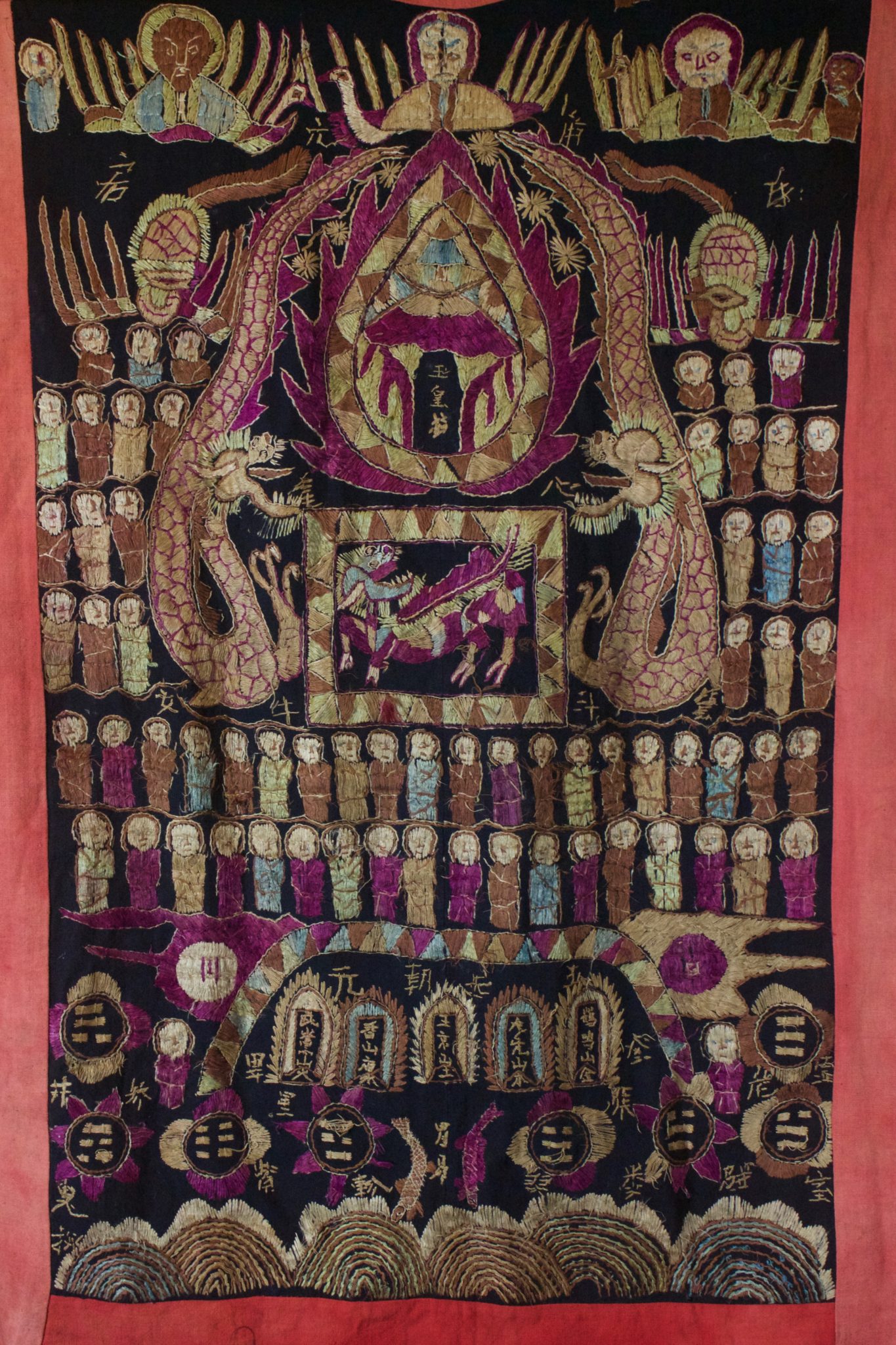
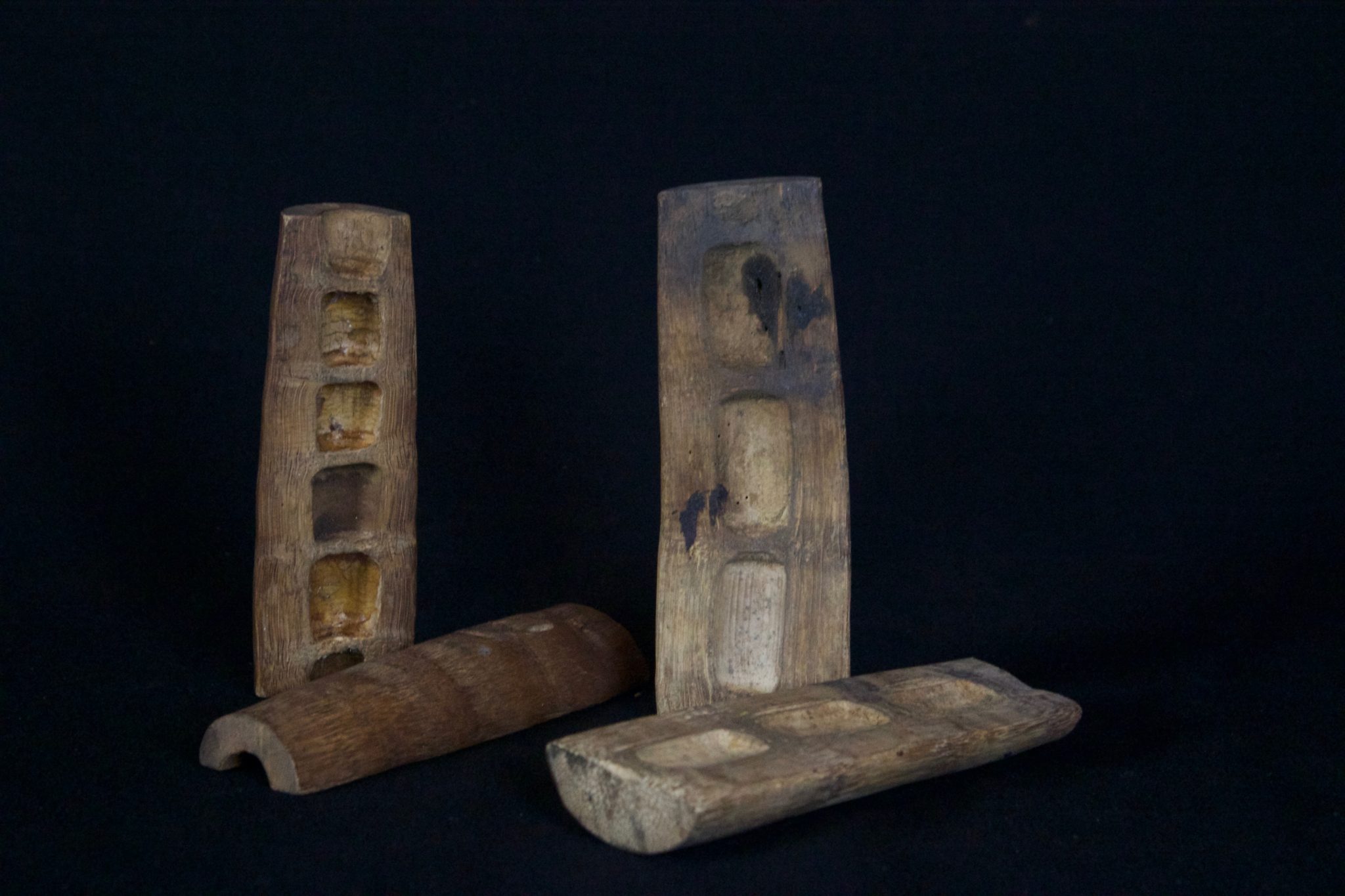
These pairs of blocks are used by shaman to get answers to questions and requests. They are round on the yin side and flat on the yang side. They are thrown like dice. The answer is determined by the configuration of how they land: 1 yin and 1 yang side up = YES; Both the same side up = NO (also typically made of wood or horn) $175 each set. Dimensions: (right – 5” x 1 ¾” x 1 ½”); (left – 4 ¾” x 1 ½” x 1 ½”)
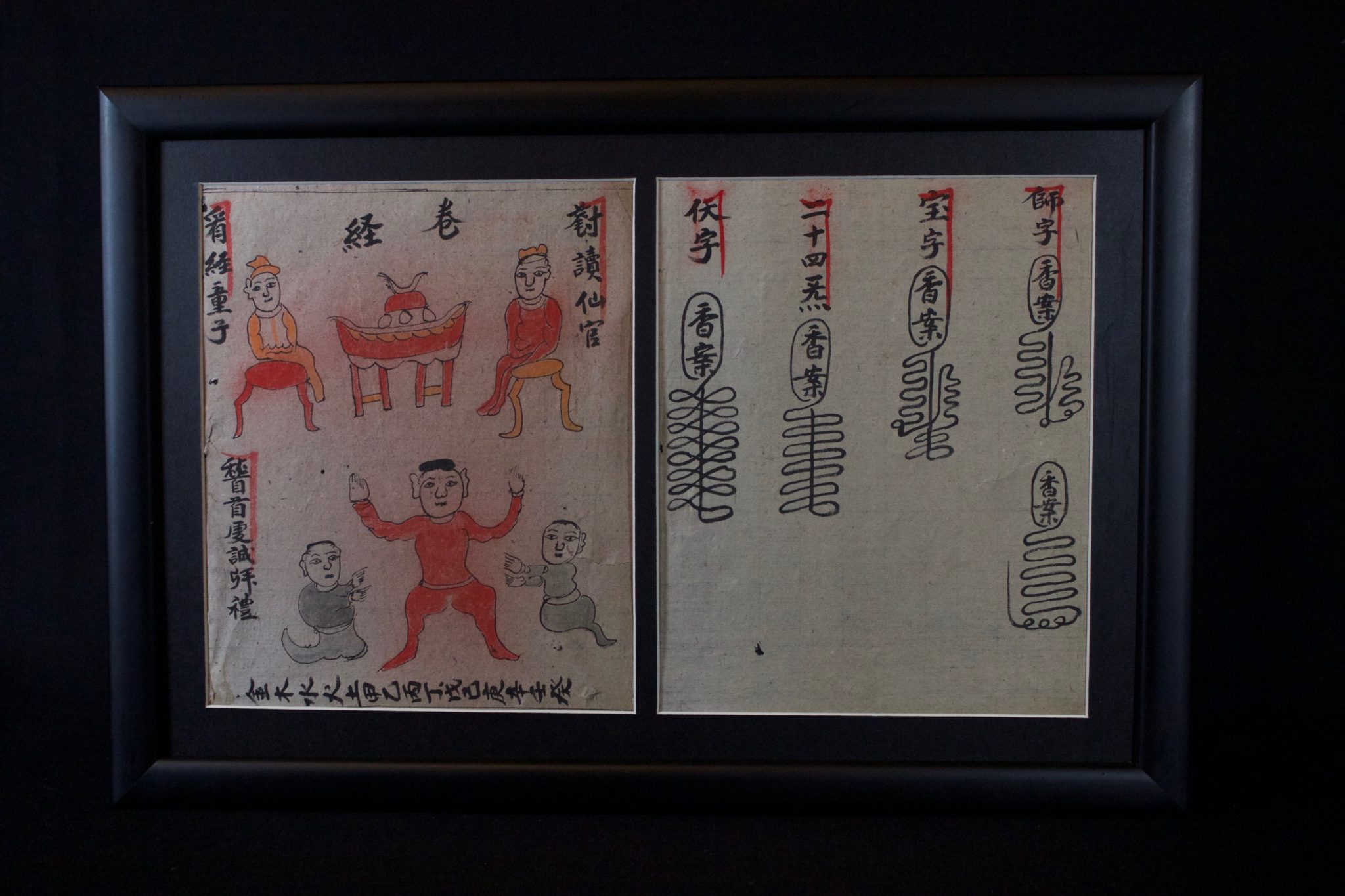
It is a book for making astrological predictions using the East Asian zodiac’s twelve animal characters. The text of the book uses images, maps and text to describe in detail, for the learned shaman, how to navigate this complex system of looking into the future. 12” x 17 ¾” x ¾”, $260.
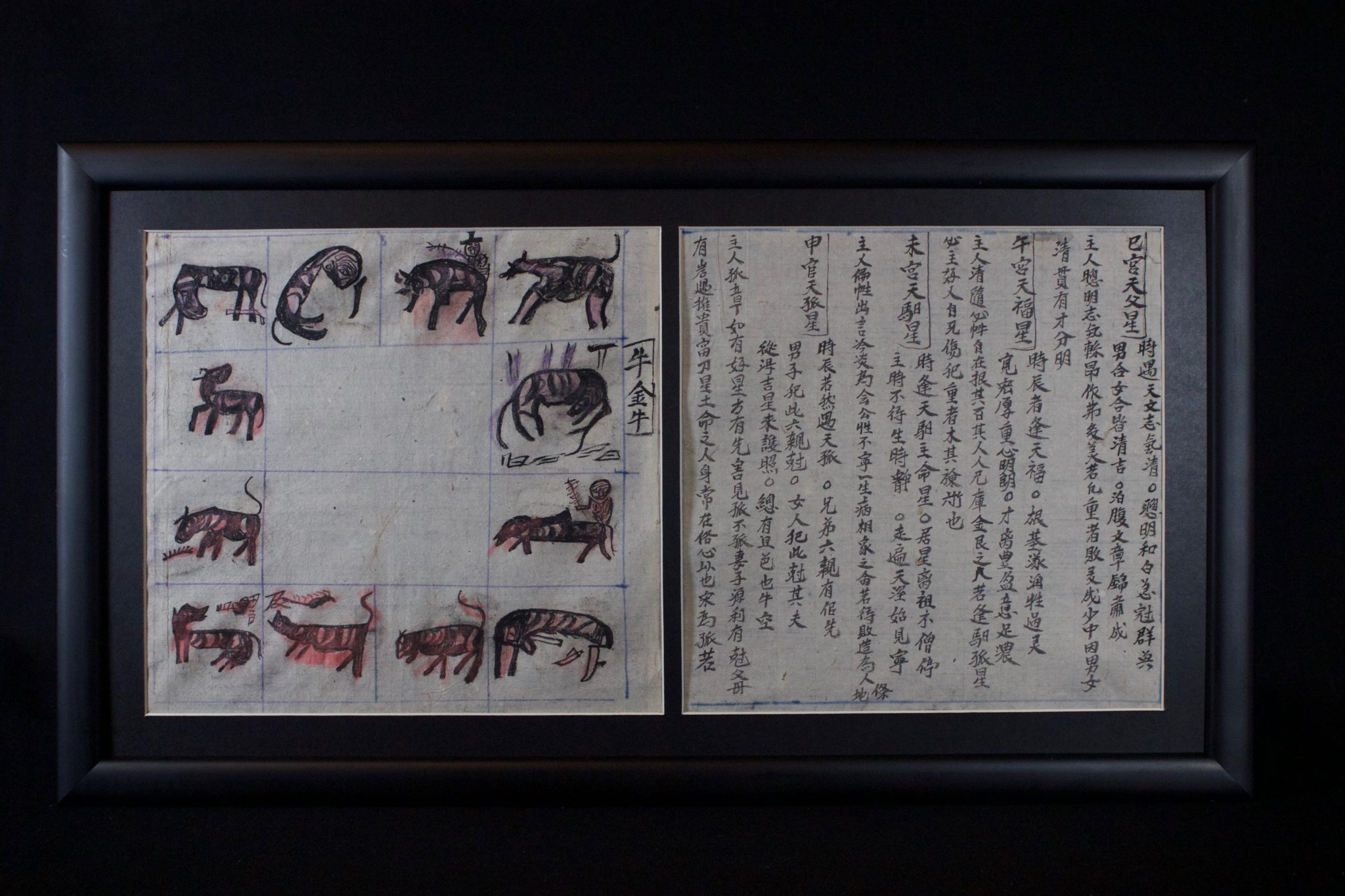
Red Yao people, Early 20th c, Ink on handmade mulberry paper
Written in Nom (Chinese characters adapted to Vietnamese), books are an integral part of a shaman’s repertoire. They range from explanations of various rituals and use of objects, to astrology, history, songs, laws, etiquette, children’s tales, hunting practices, formulas, spells and Feng Shui. Shaman make their own books to help store their knowledge therefore no two are alike and a high level shaman will have a large library. 9 ½” x 8 ½” x ¾”, $850.
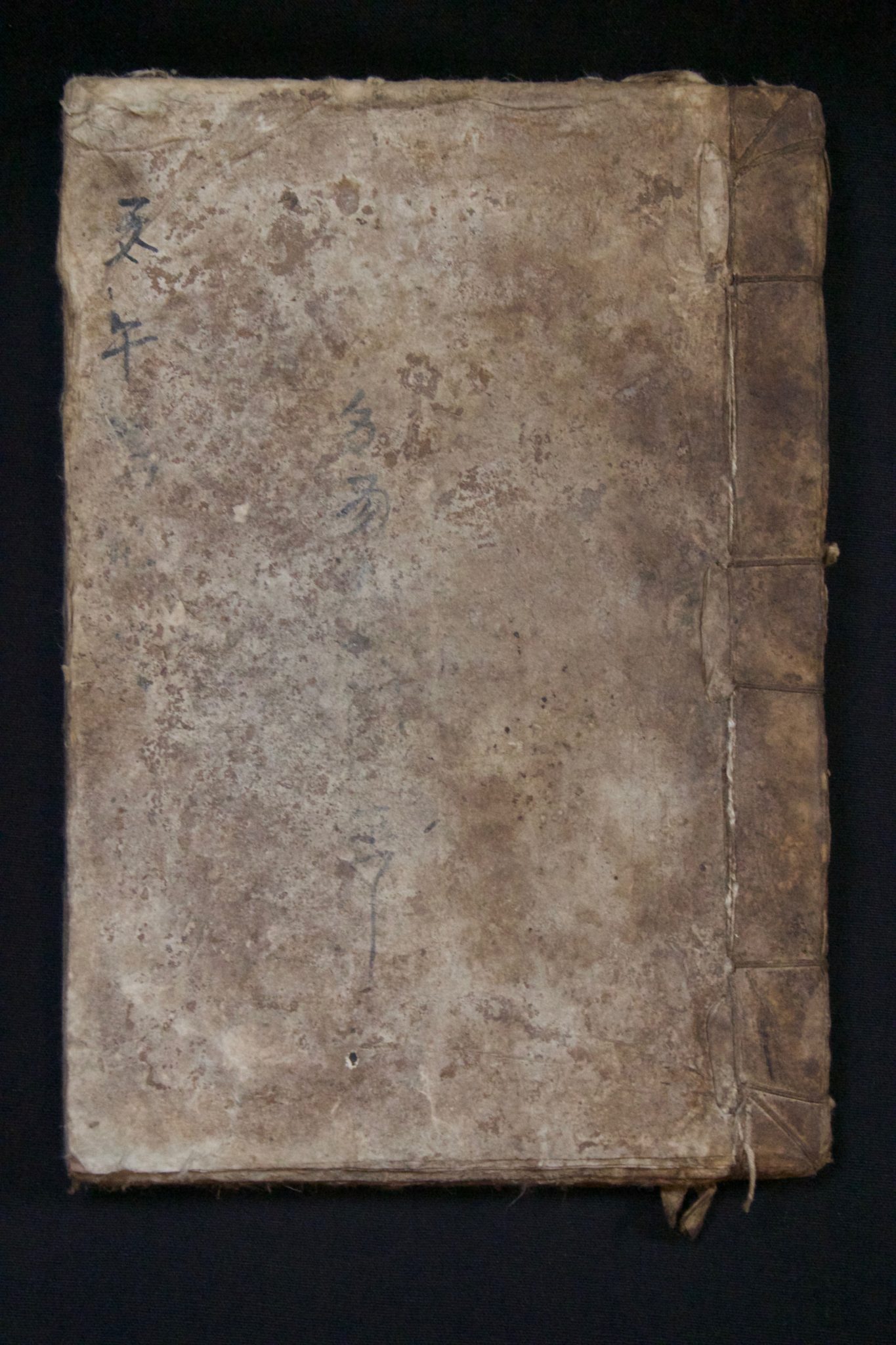
Scripted by the shaman, on handmade paper, to record all his knowledge and to instruct future shaman, 9” x 6 ¼” 1”, $750. (see below for inside detail)
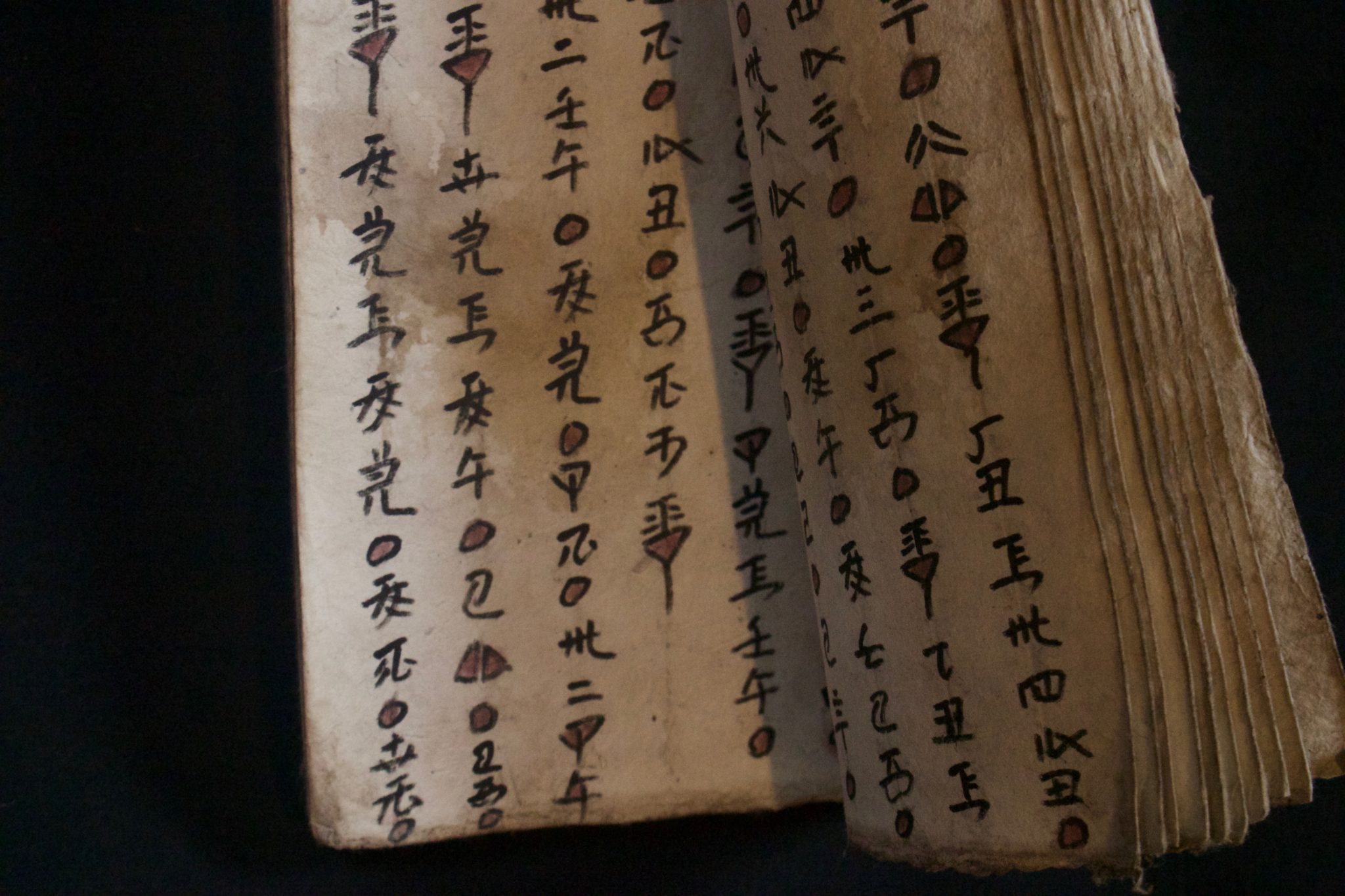
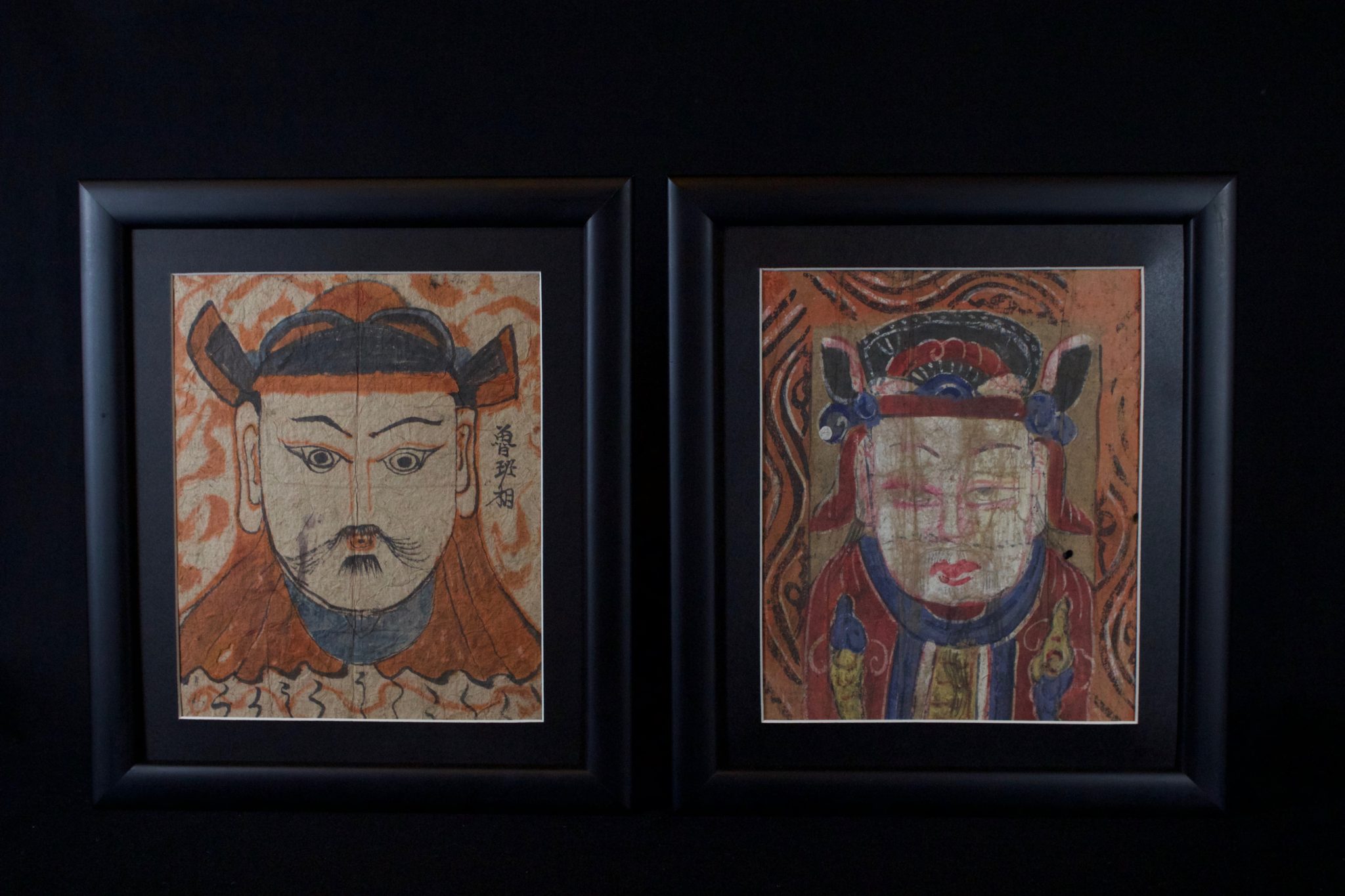
Paper masks are required possessions for shaman. Usually tied to the forehead, they are worn during certain rituals to impersonate deities. A shaman will have a full set of twenty seven. Only female shaman can wear masks of female deities. 11 ¼” x 9 ¾” x ¾” (framed) $240 each
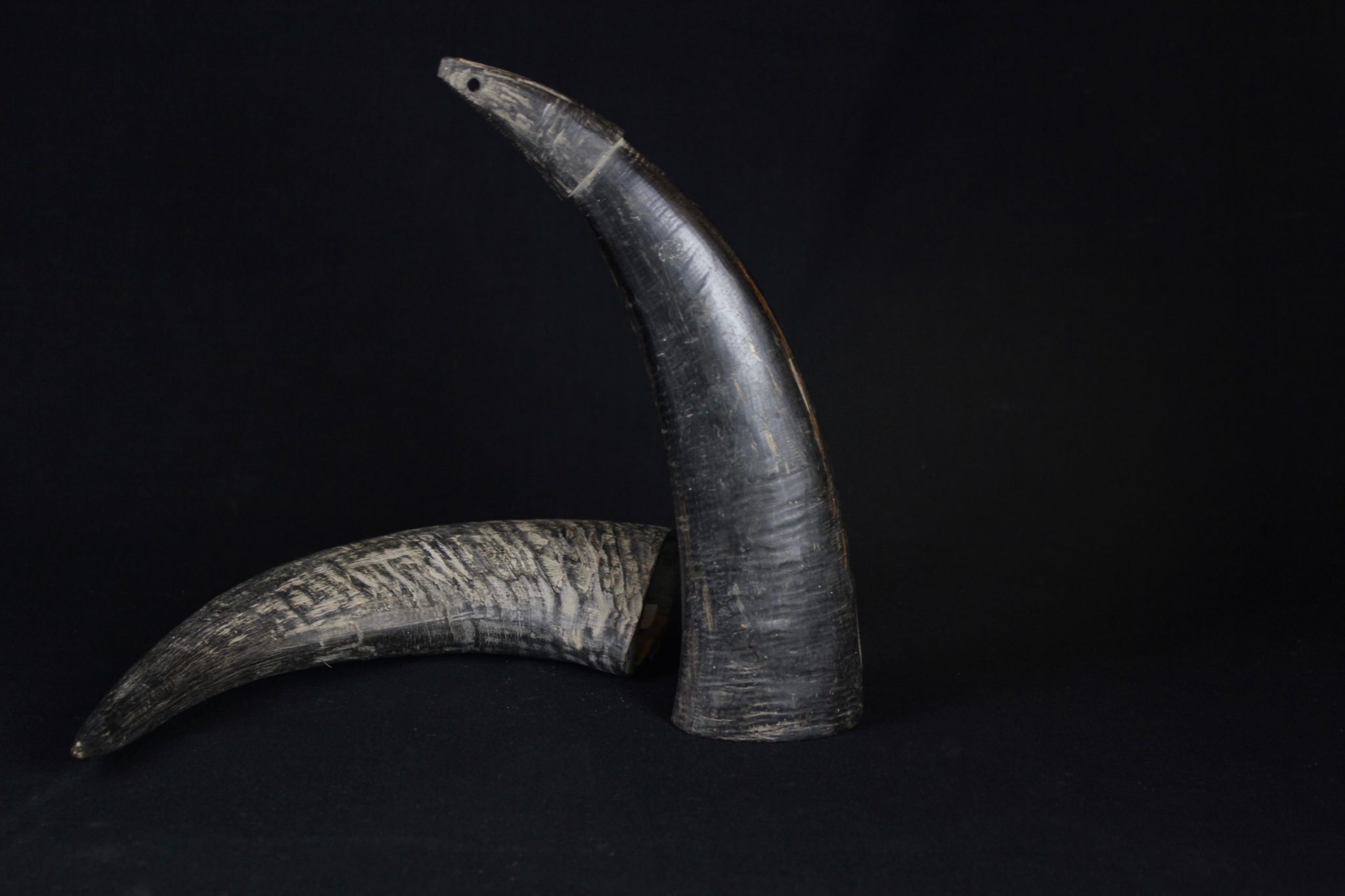
(horizontal – 11 ¾” x 2 ¼” x 5”, $160.); (vertical – 12” x 3 ¼” x 2 ¼”, $160.)
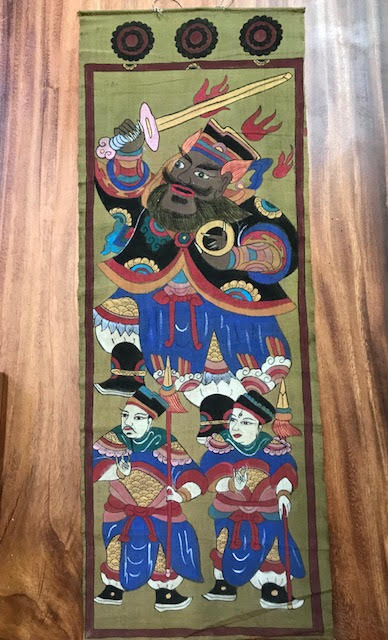
Shaman ritual painting, 42″ x 16″, $425.
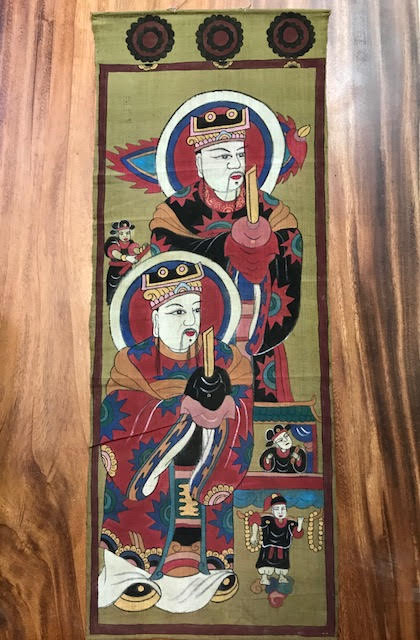
Shaman ritual painting, 42″ x 16″, $425.
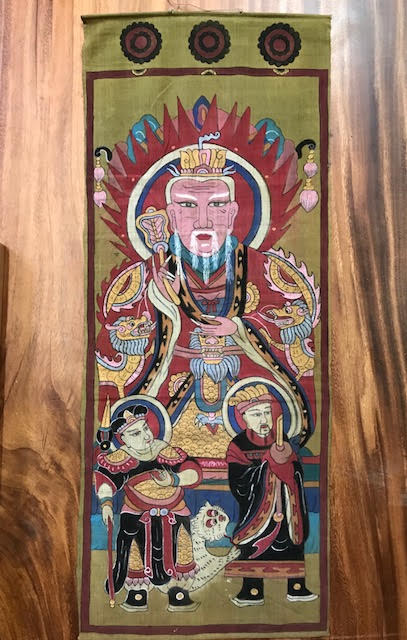
Shaman ritual painting, 42″ x 16″, $425.
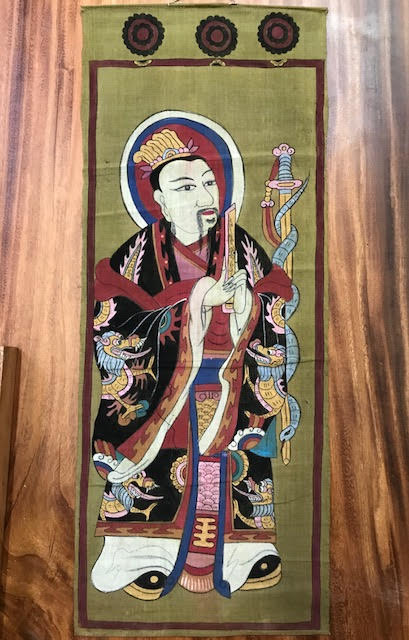
Shaman ritual painting, 42″ x 16″, $425.
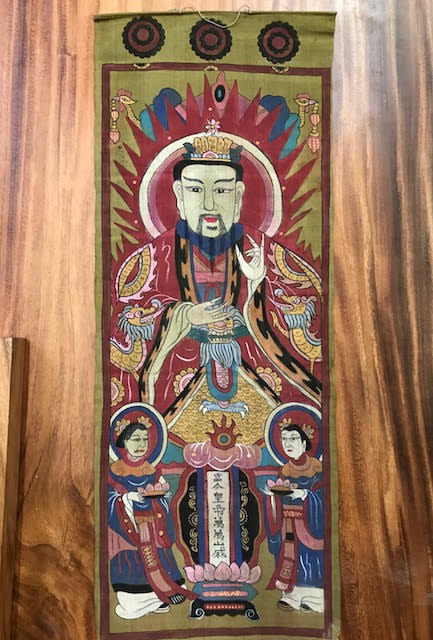
Shaman ritual painting, 42″ x 16″, $425.
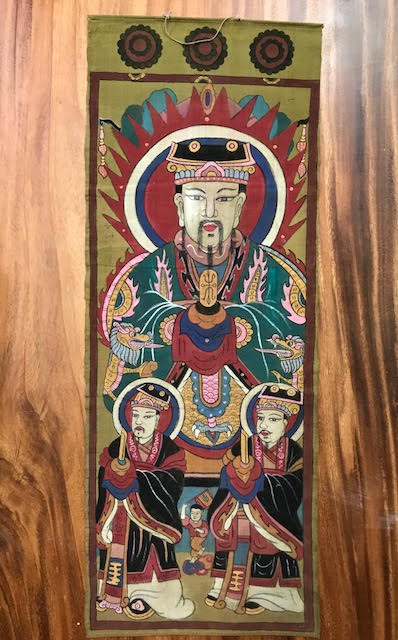
Shaman ritual painting, 42″ x 16″, $425.
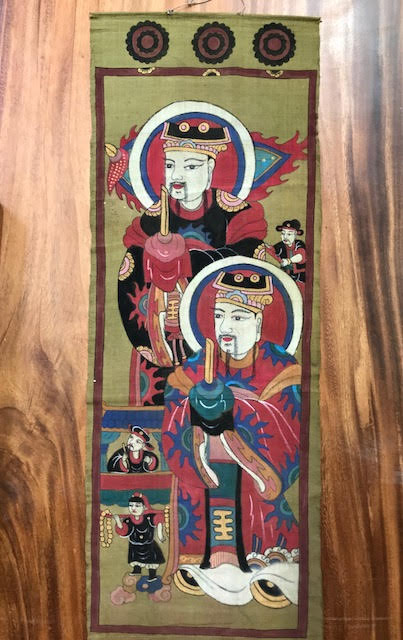
Shaman ritual painting, 42″ x 16″, $425.

Shaman ritual painting, 42″ x 16″, $425.
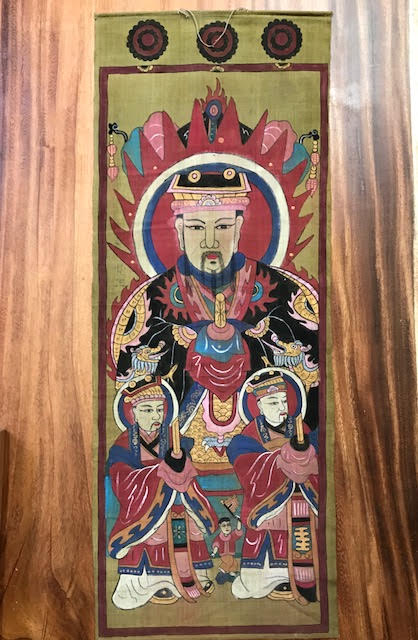
Shaman ritual painting, 42″ x 16″, $425.
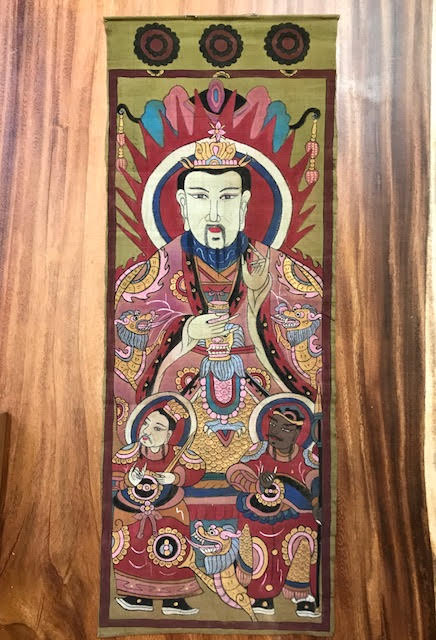
Shaman ritual painting, 42″ x 16″, $425.
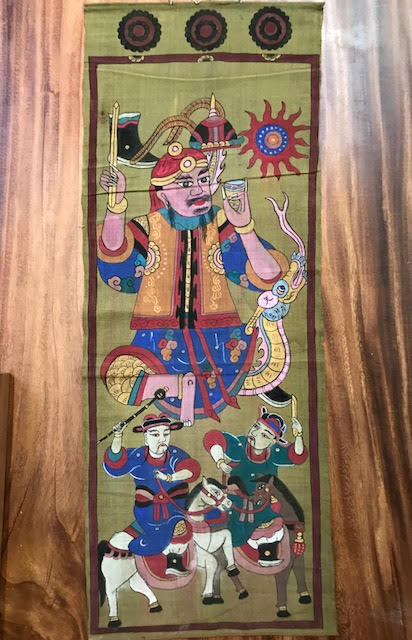
Shaman ritual painting, 42″ x 16″, $425.
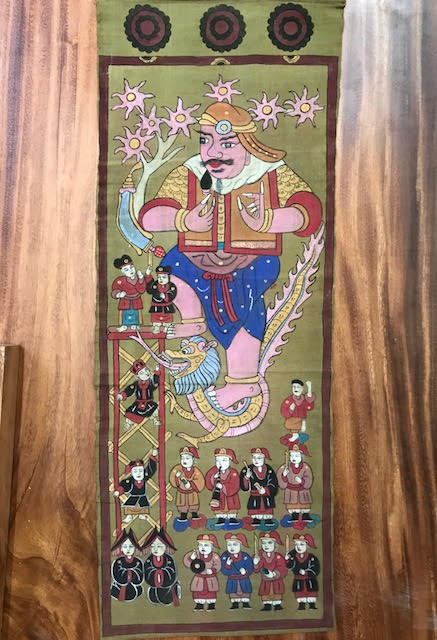
Shaman ritual painting, 42″ x 16″, $425.
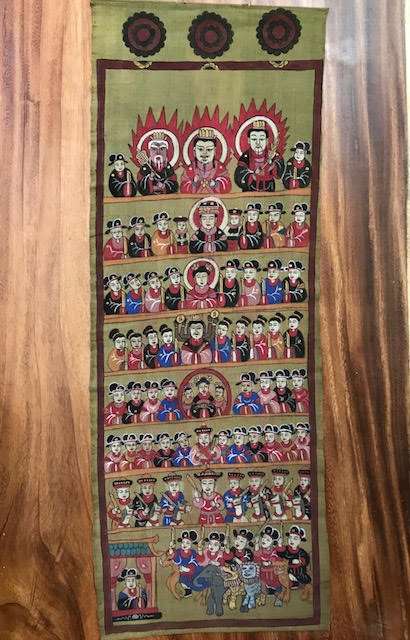
Shaman ritual painting, 42″ x 16″, $425.
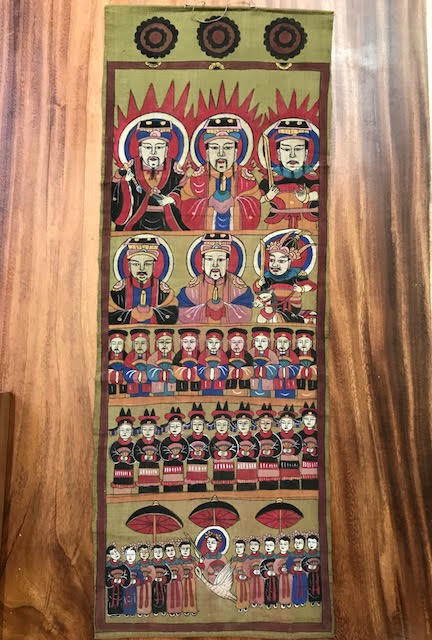
Shaman ritual painting, 42″ x 16″, $425.
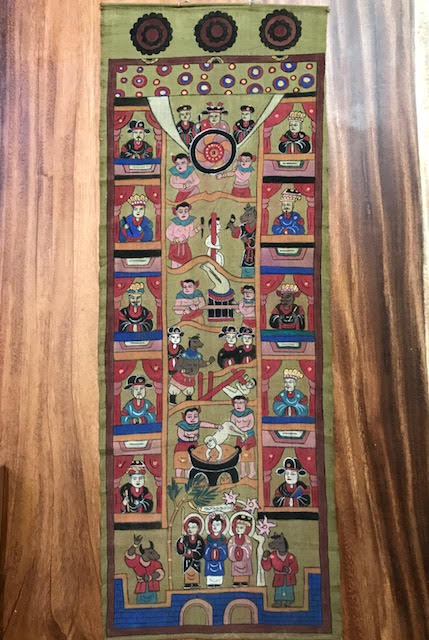
Shaman ritual painting, 42″ x 16″, $425.

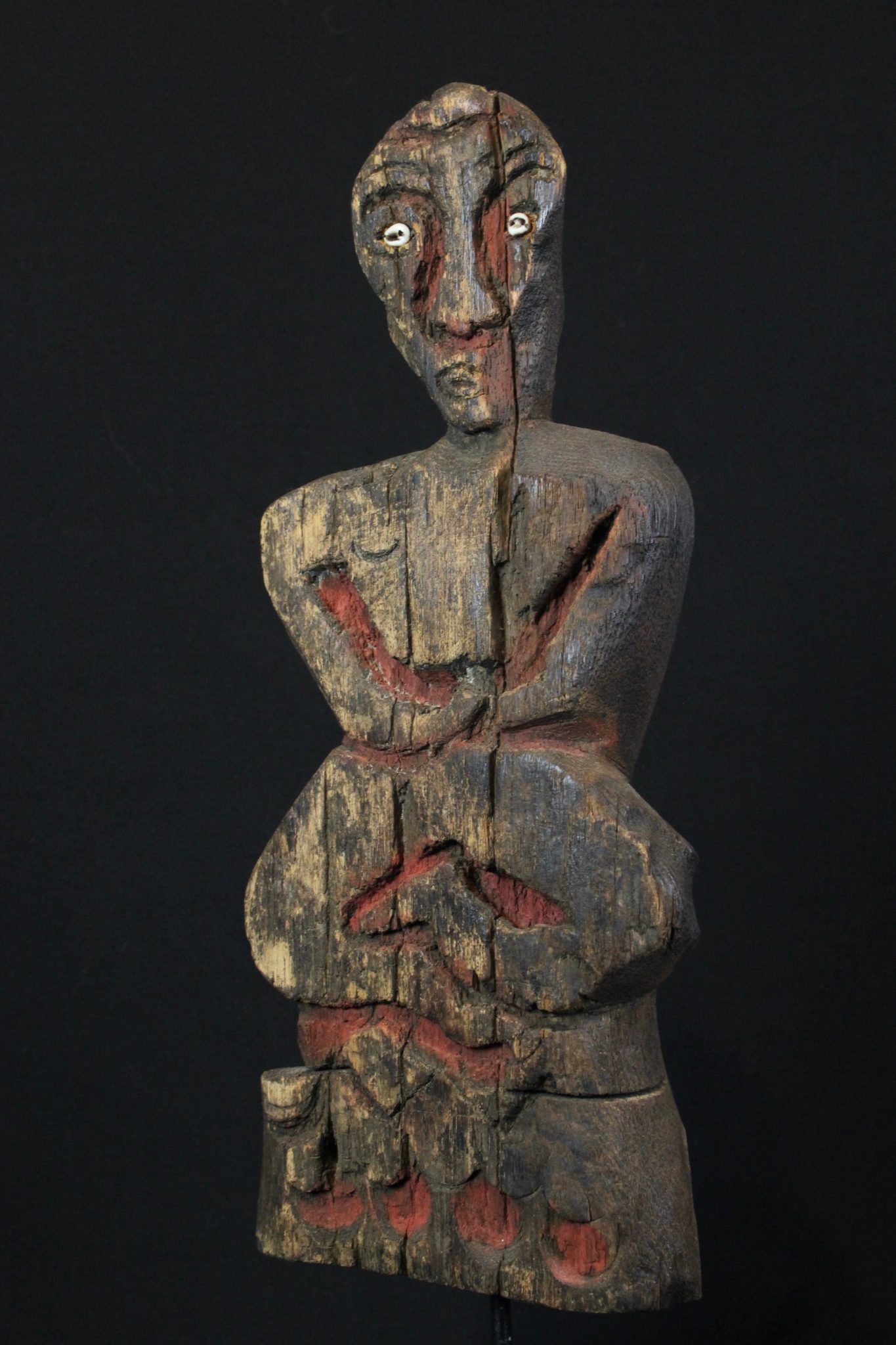
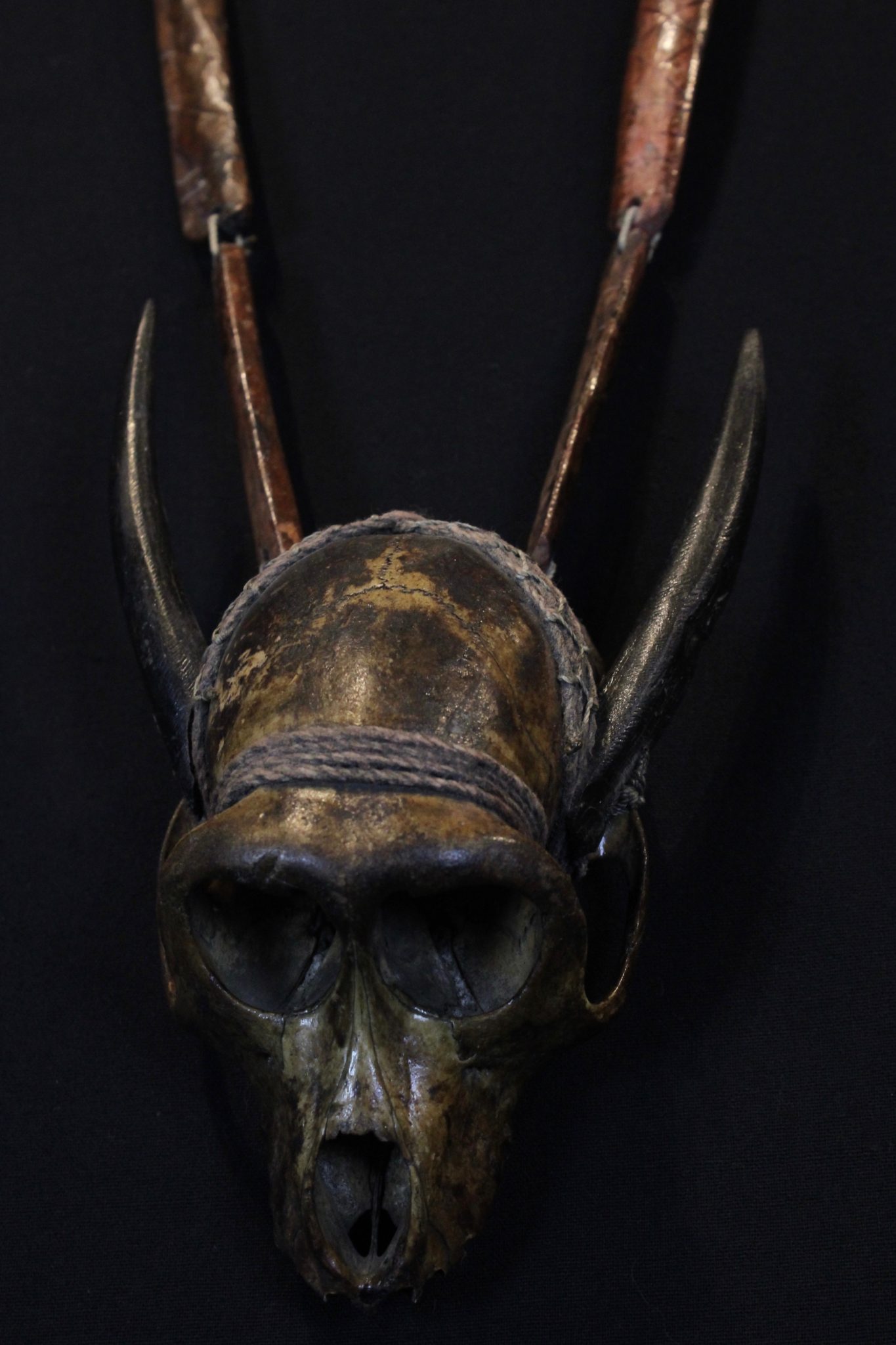
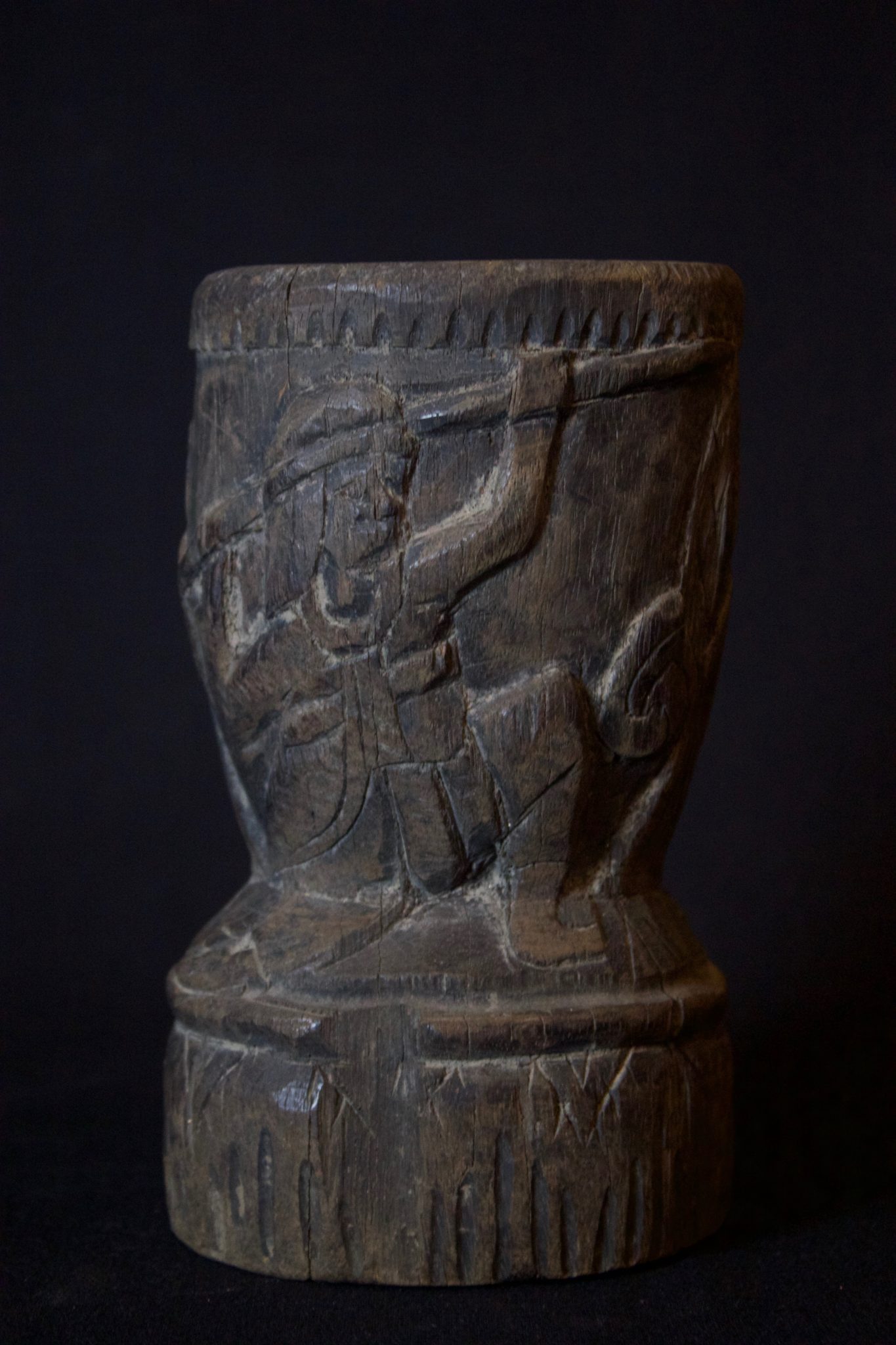
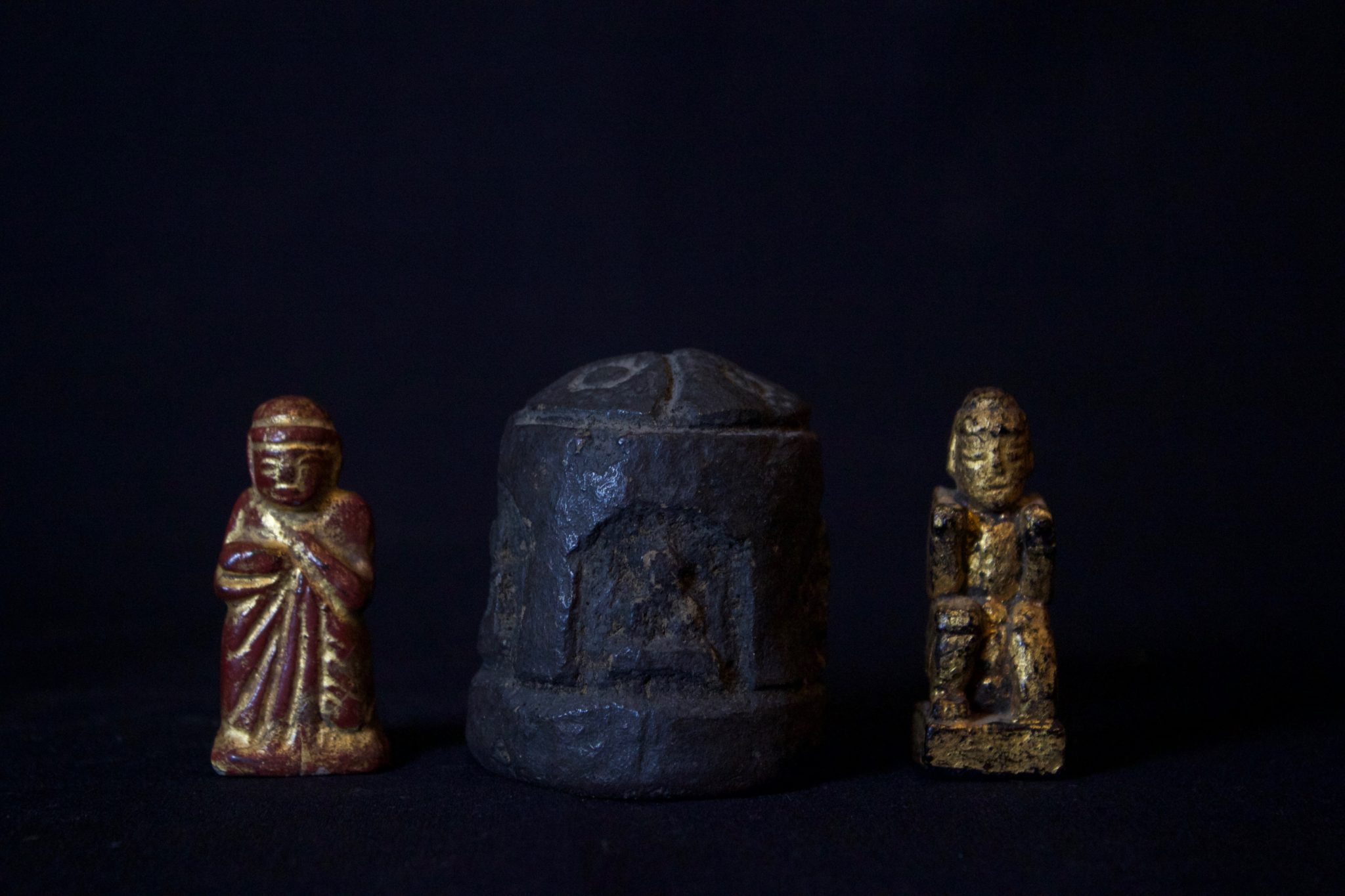
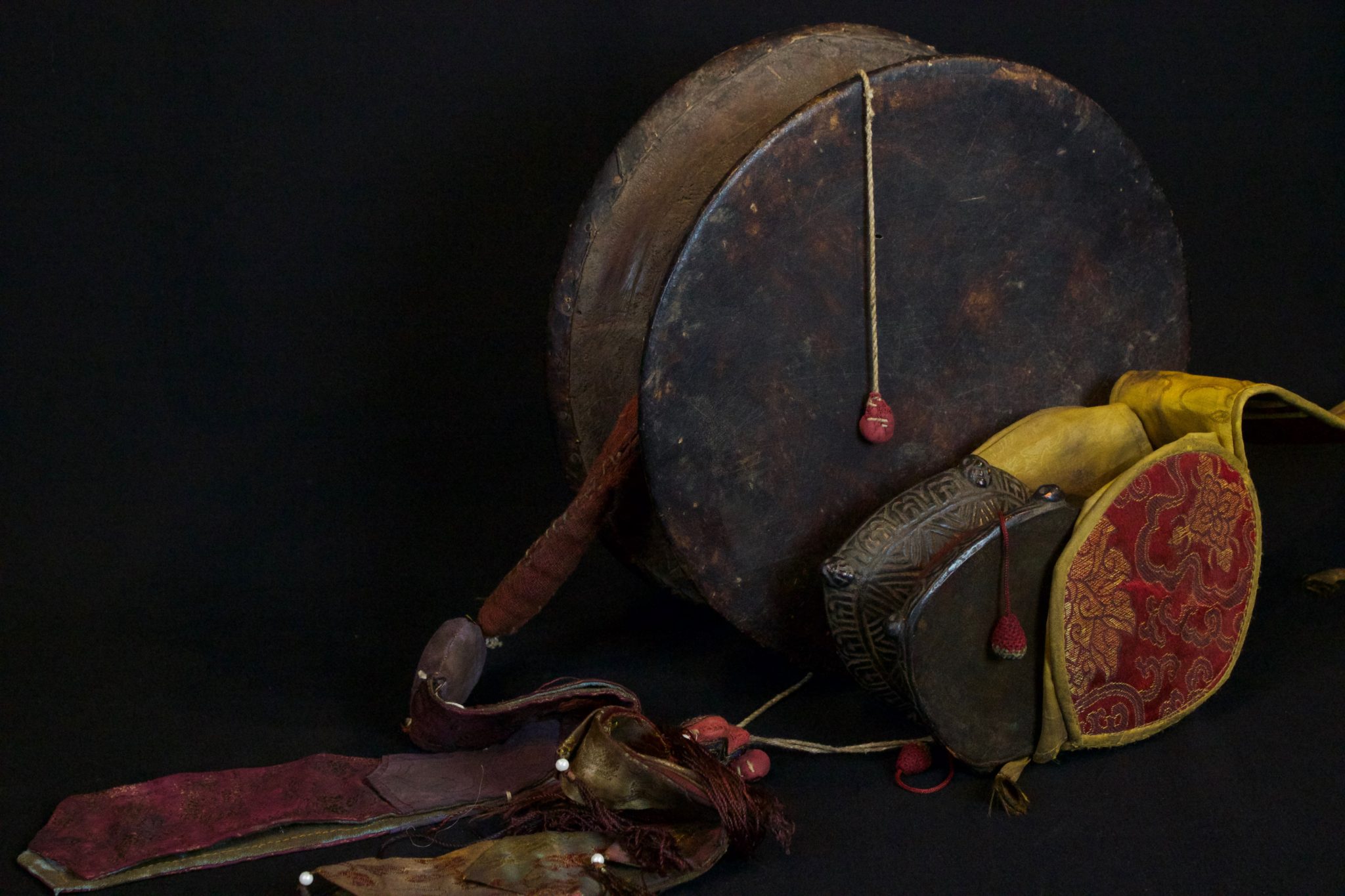
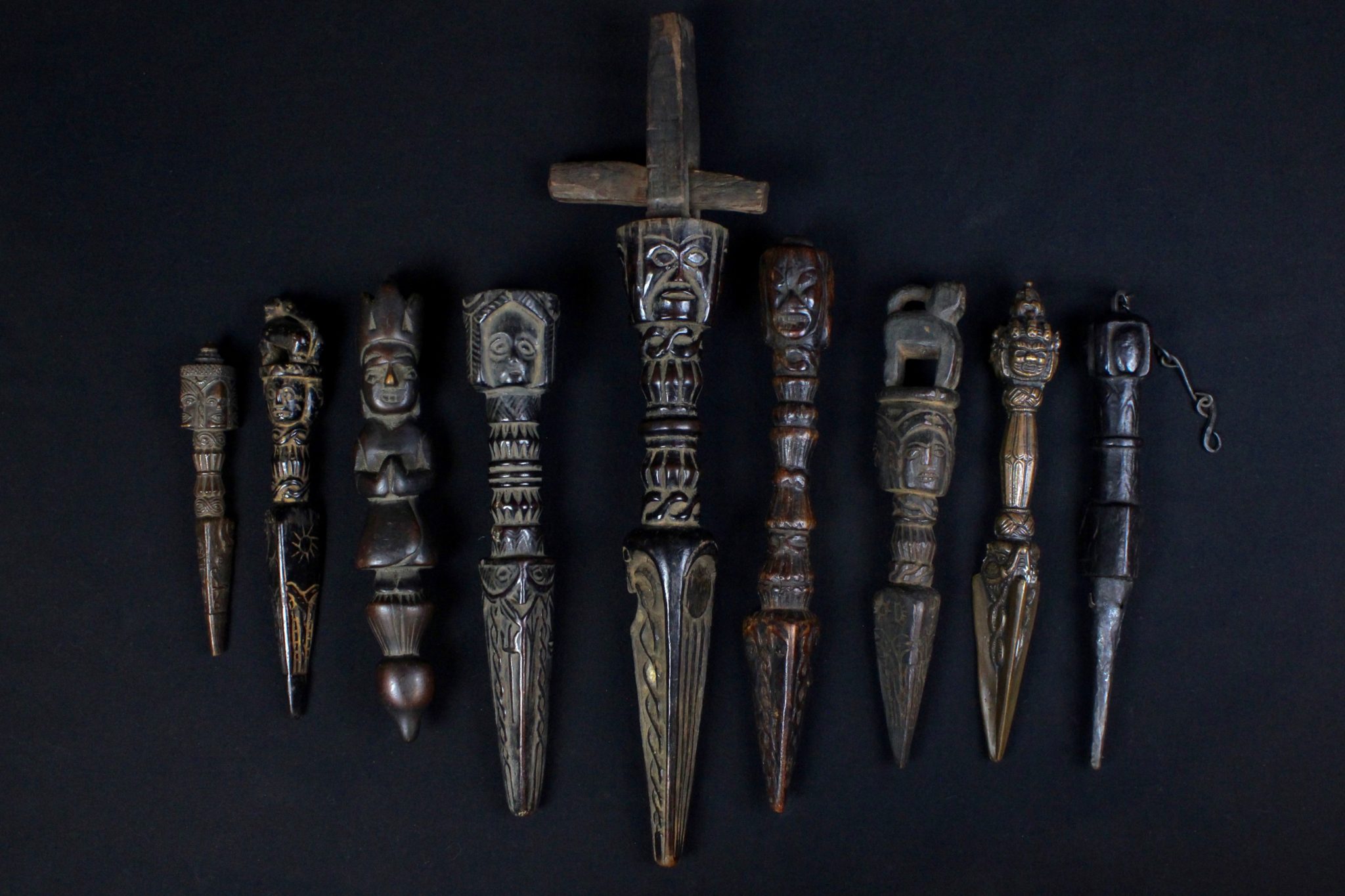
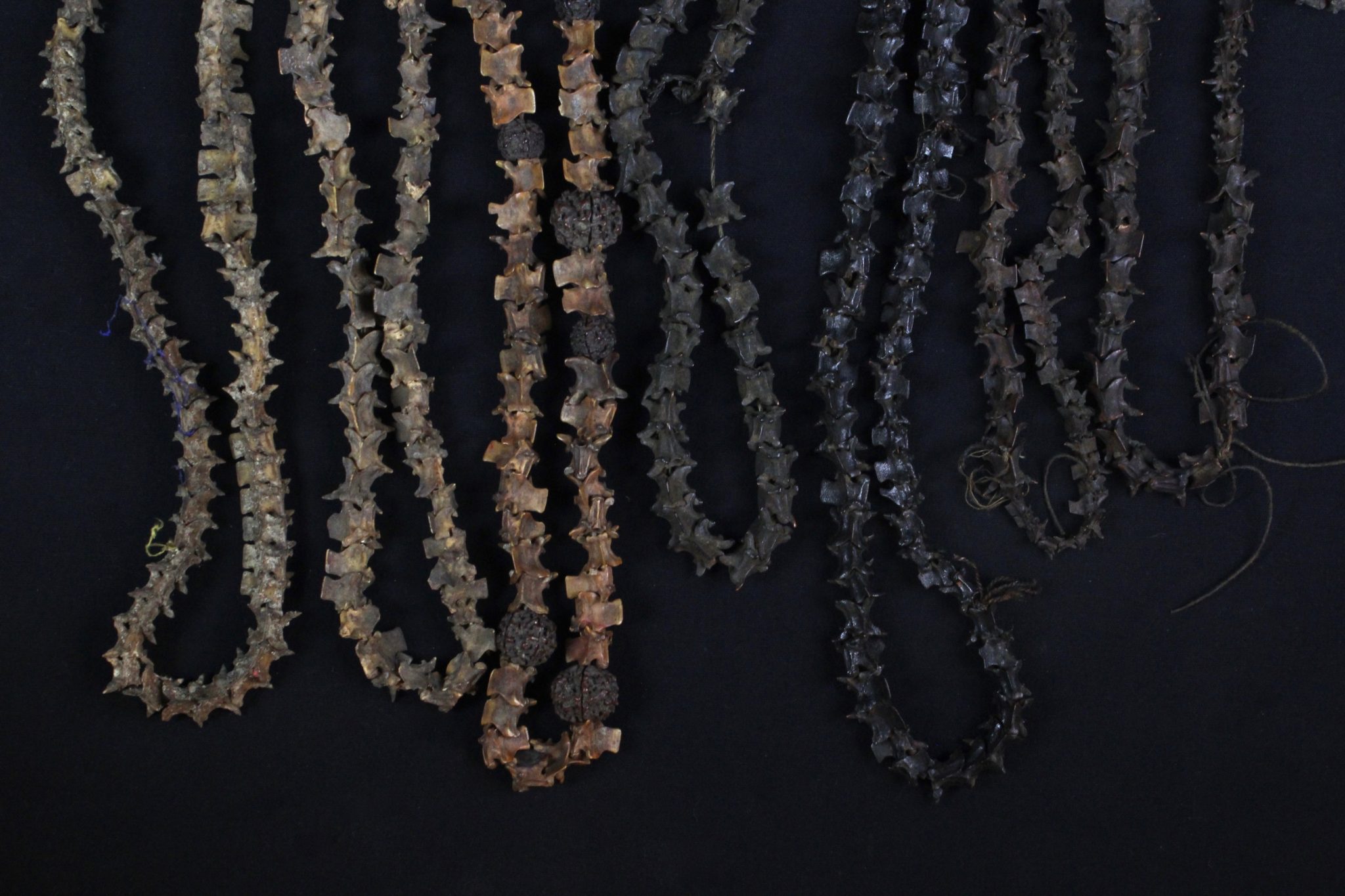
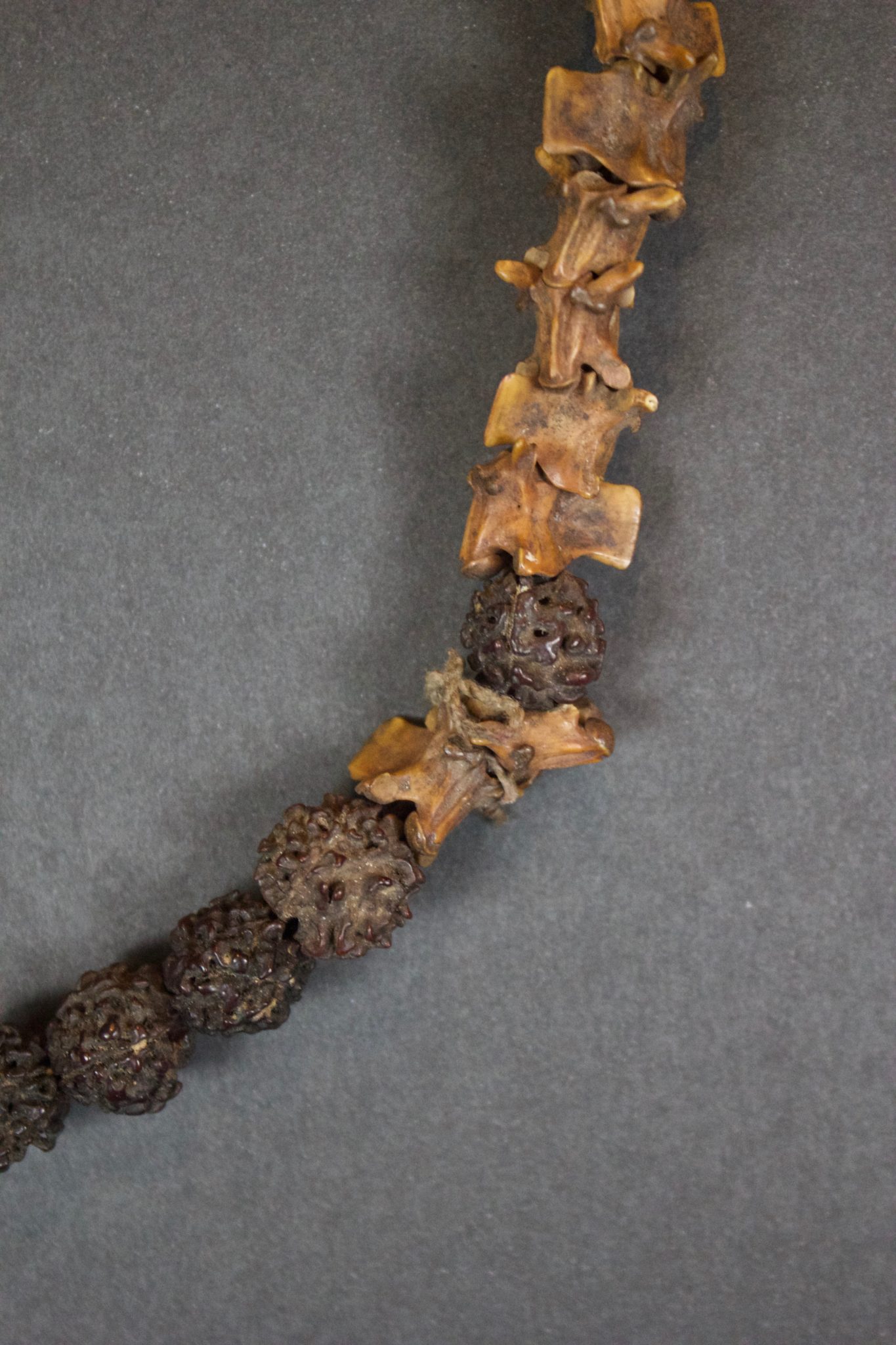
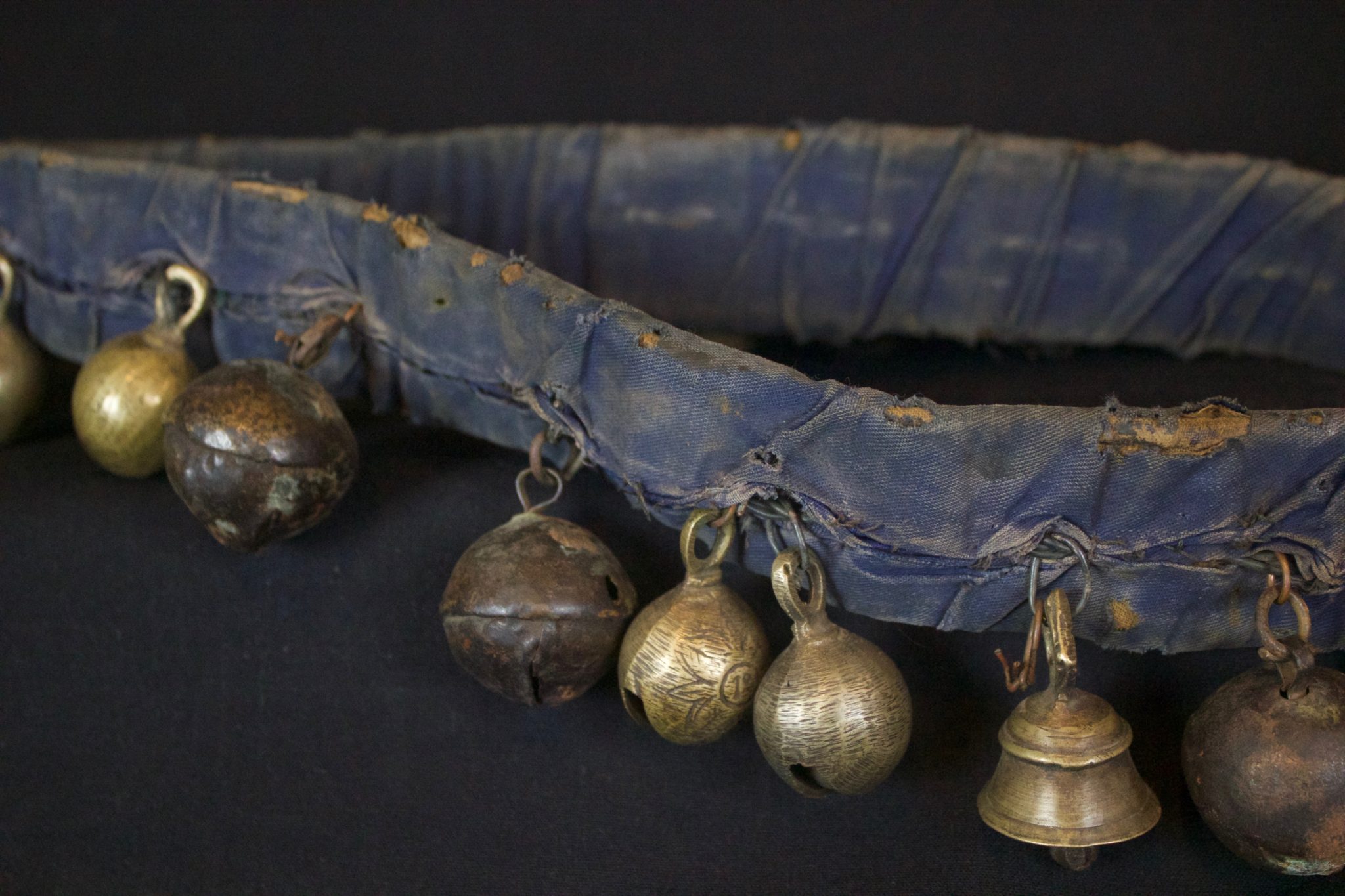
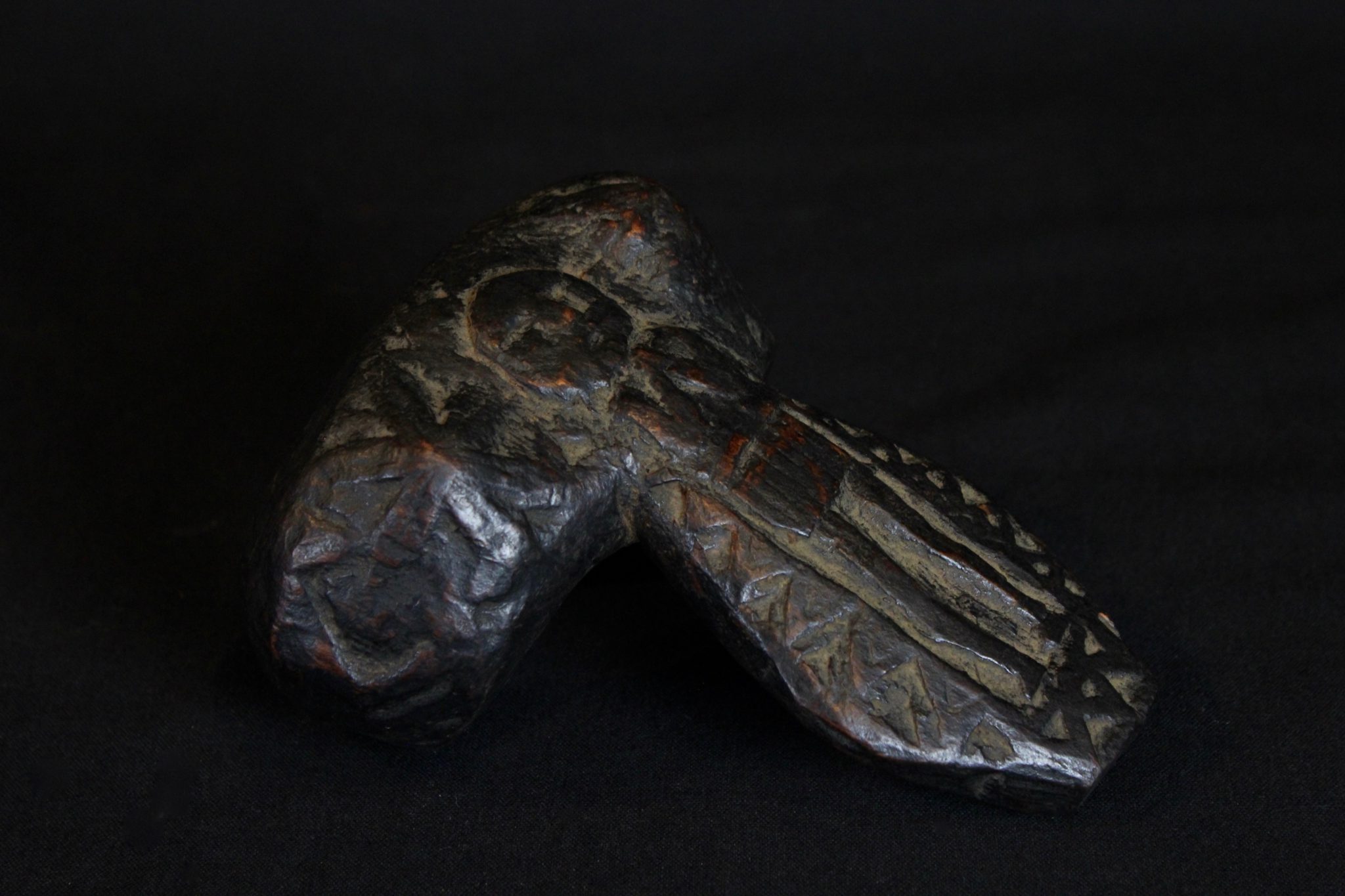
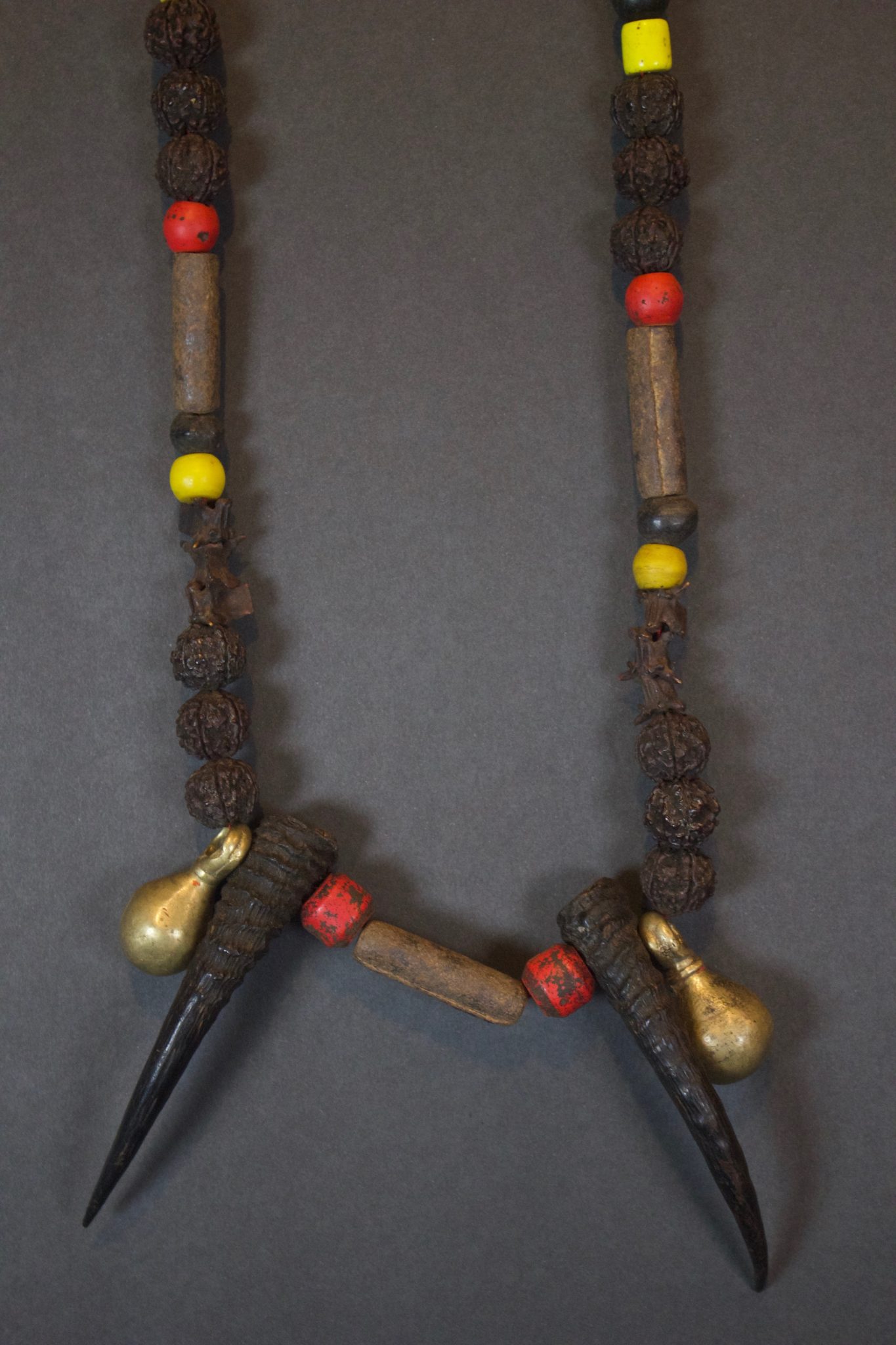
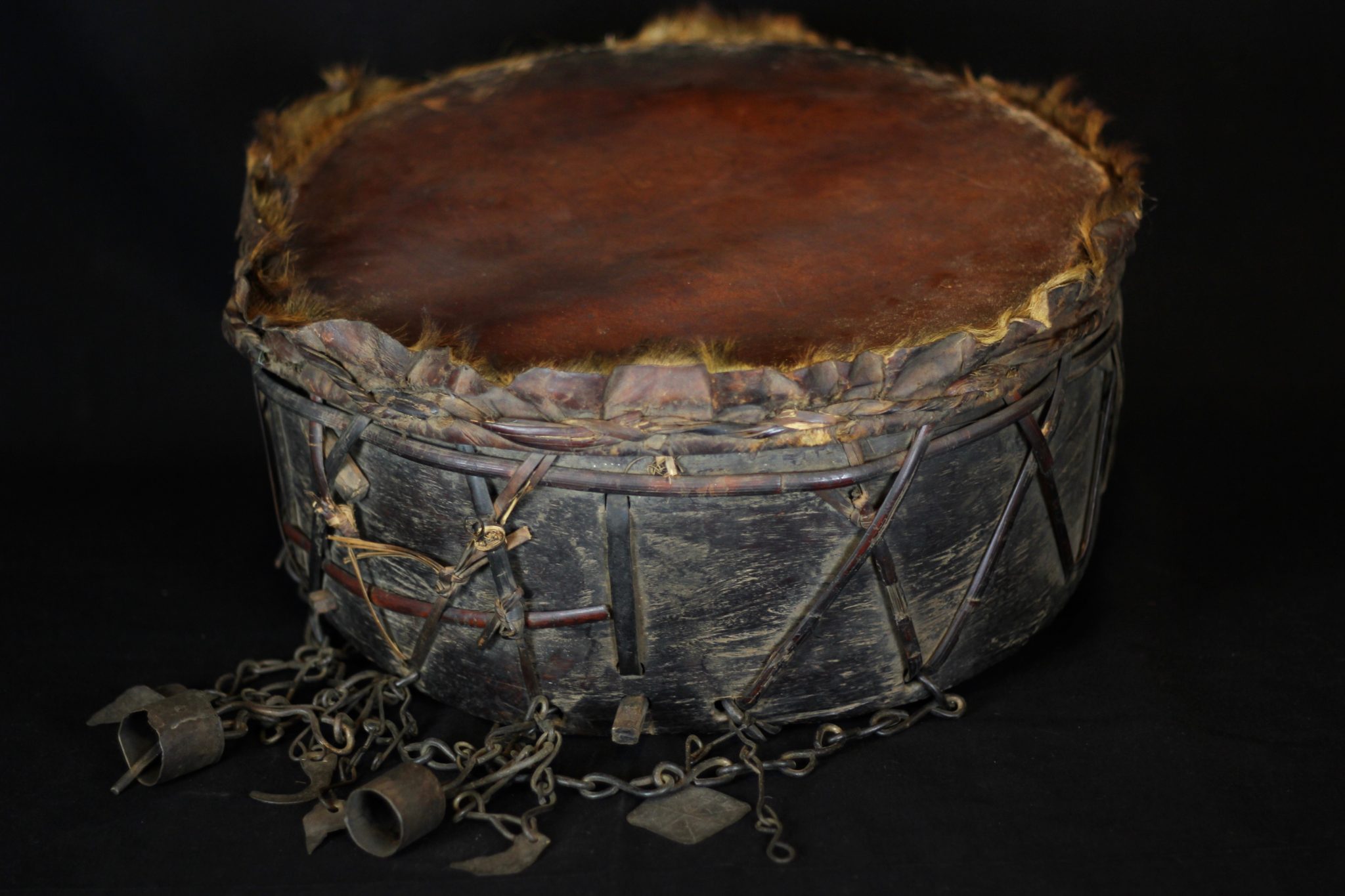
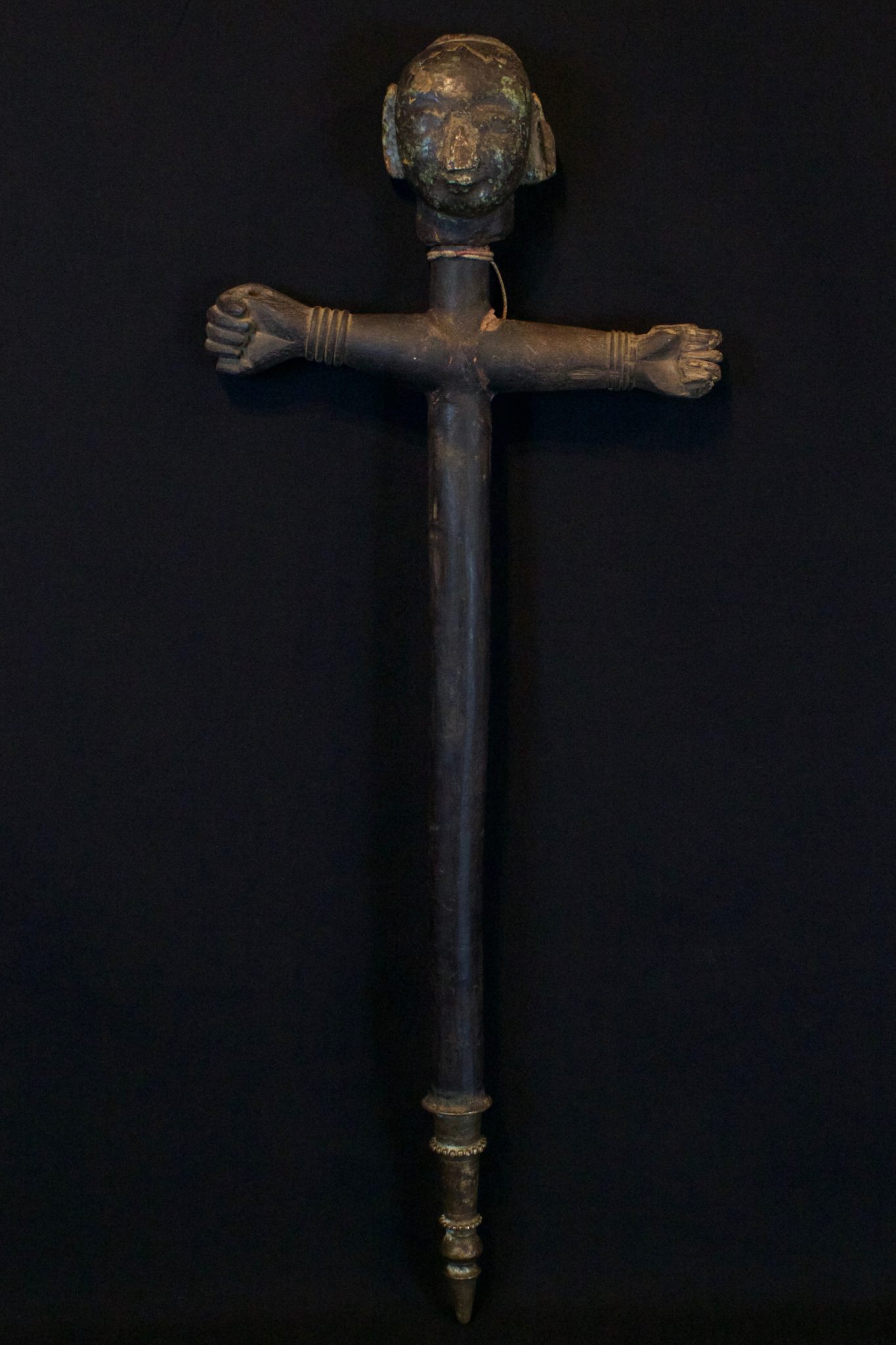
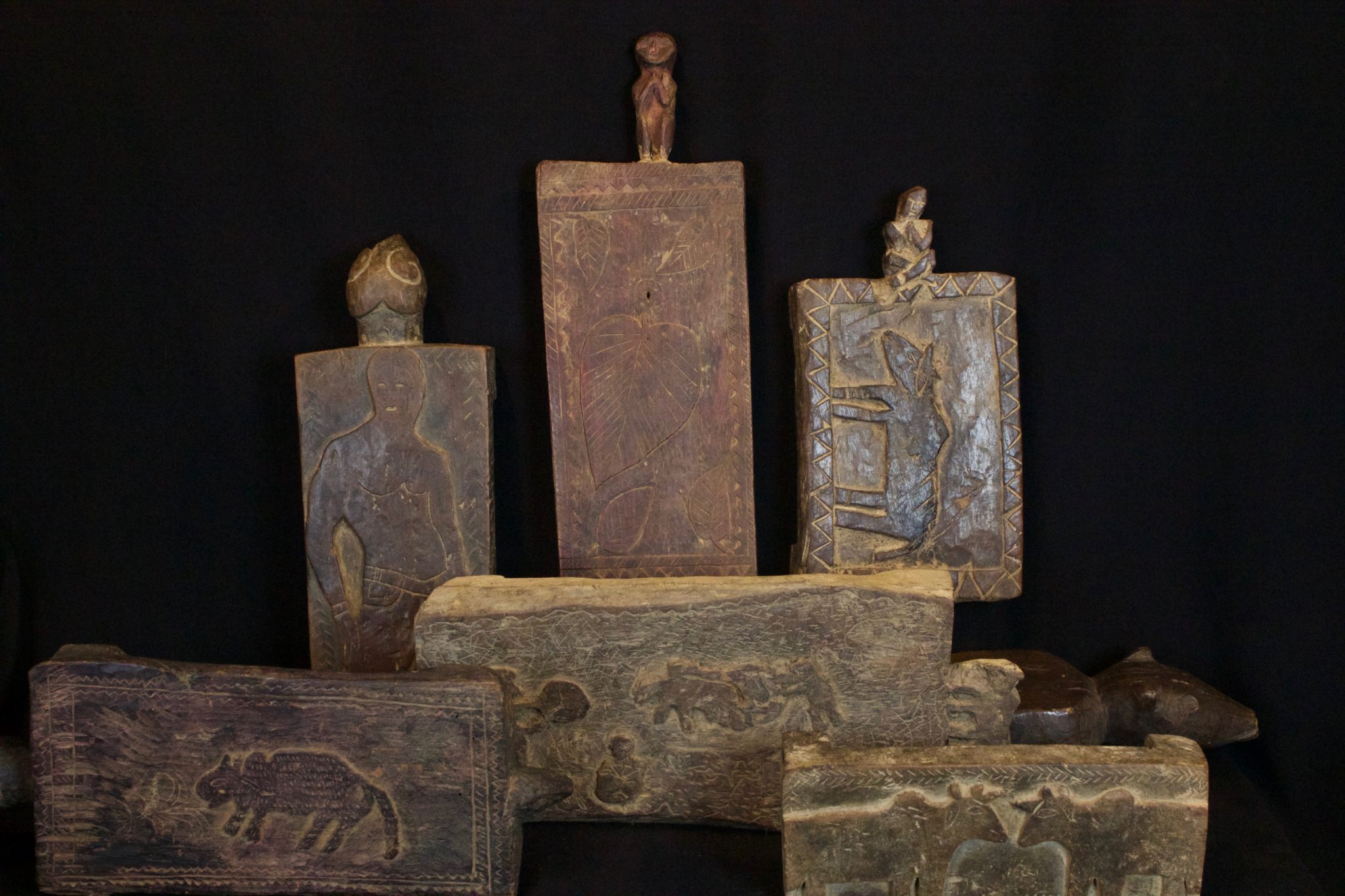
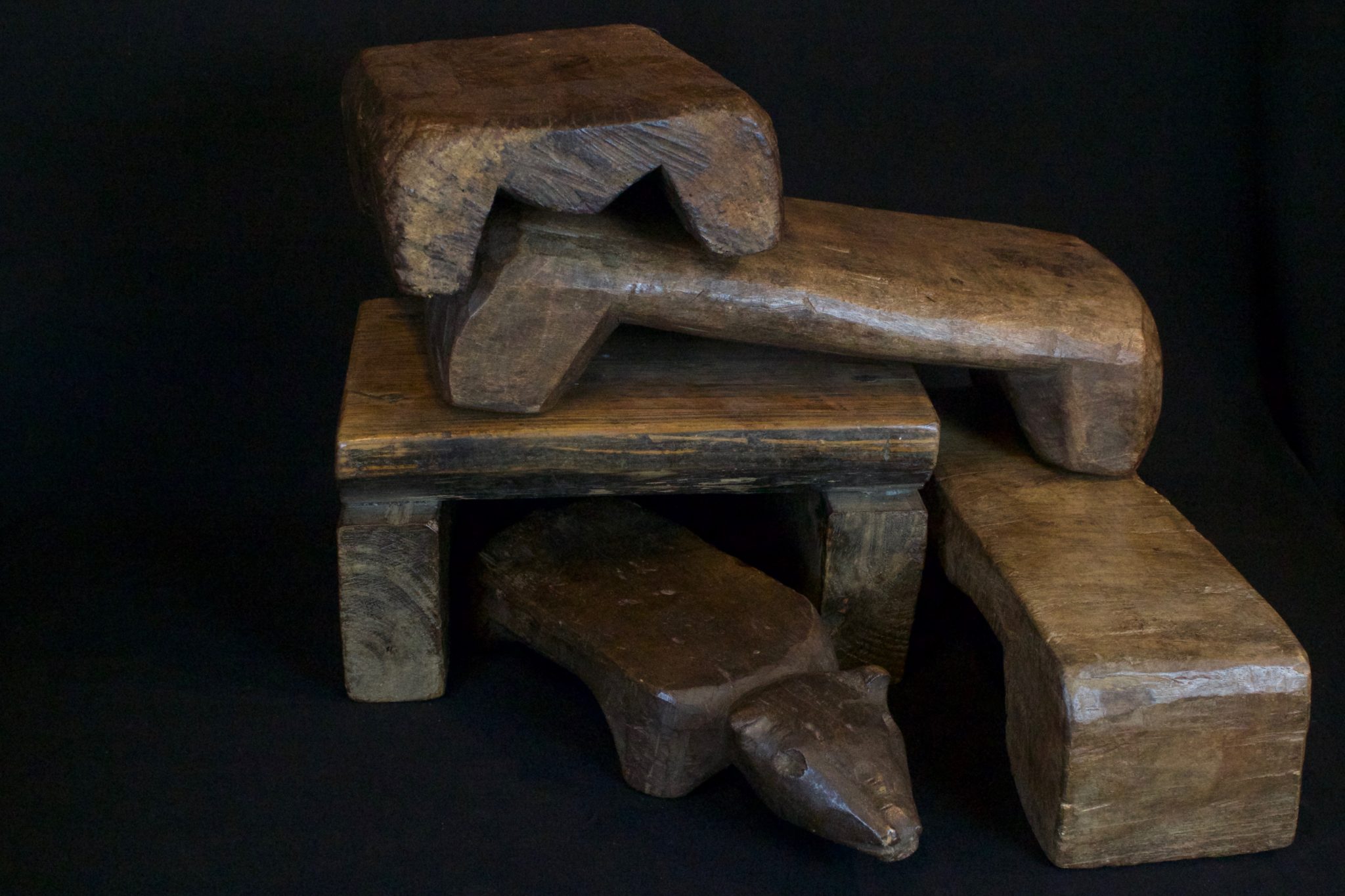
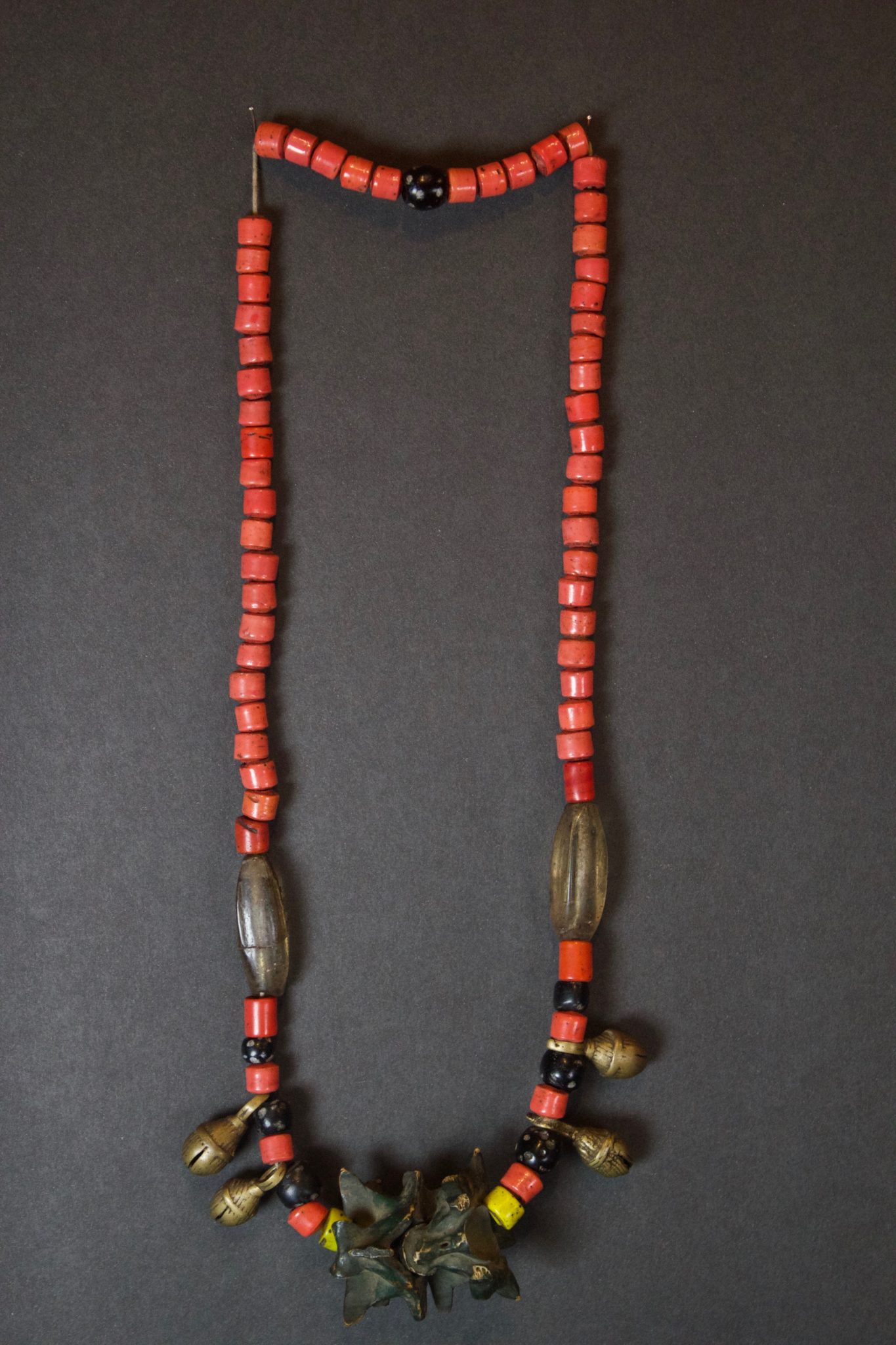
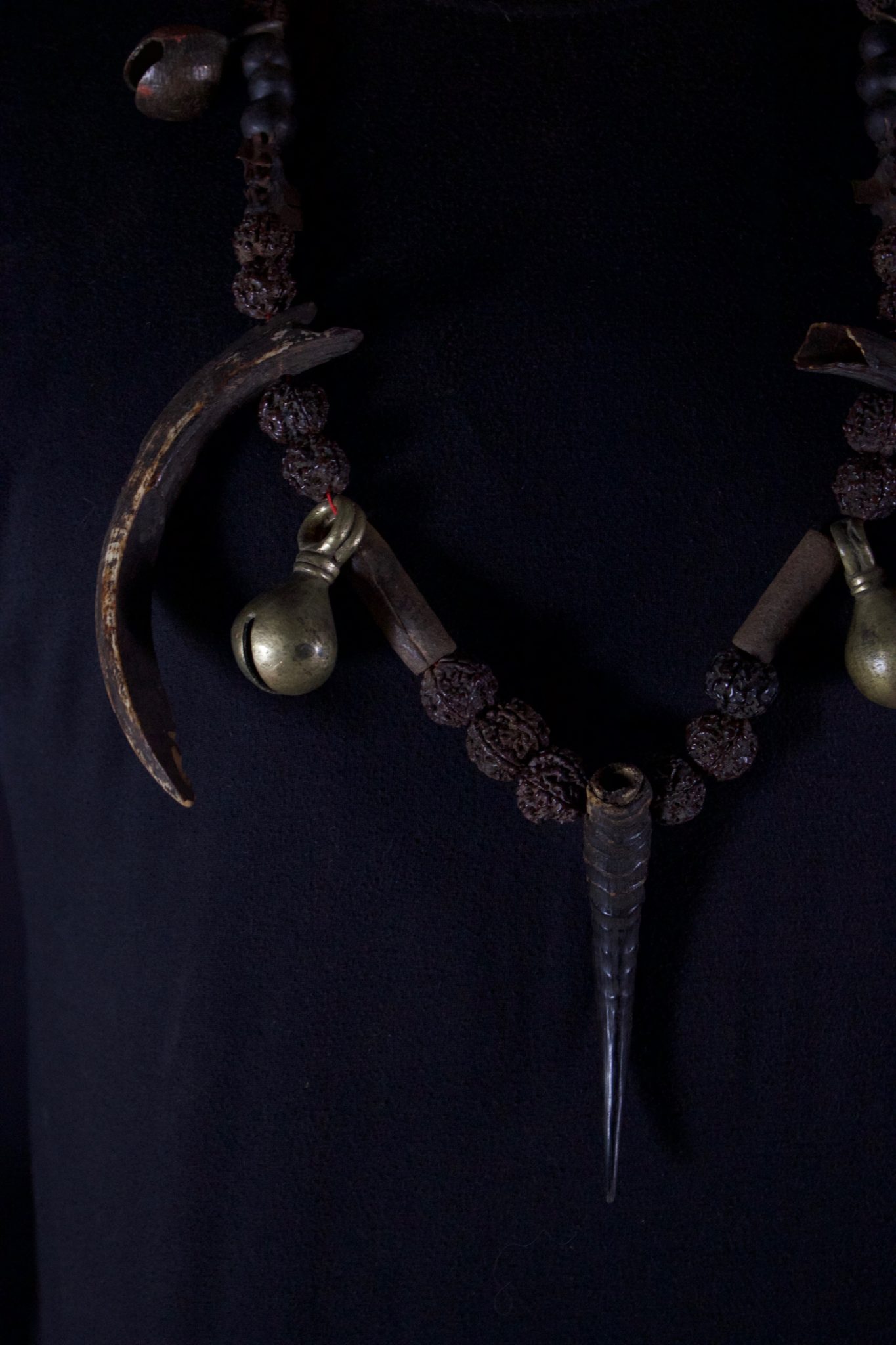
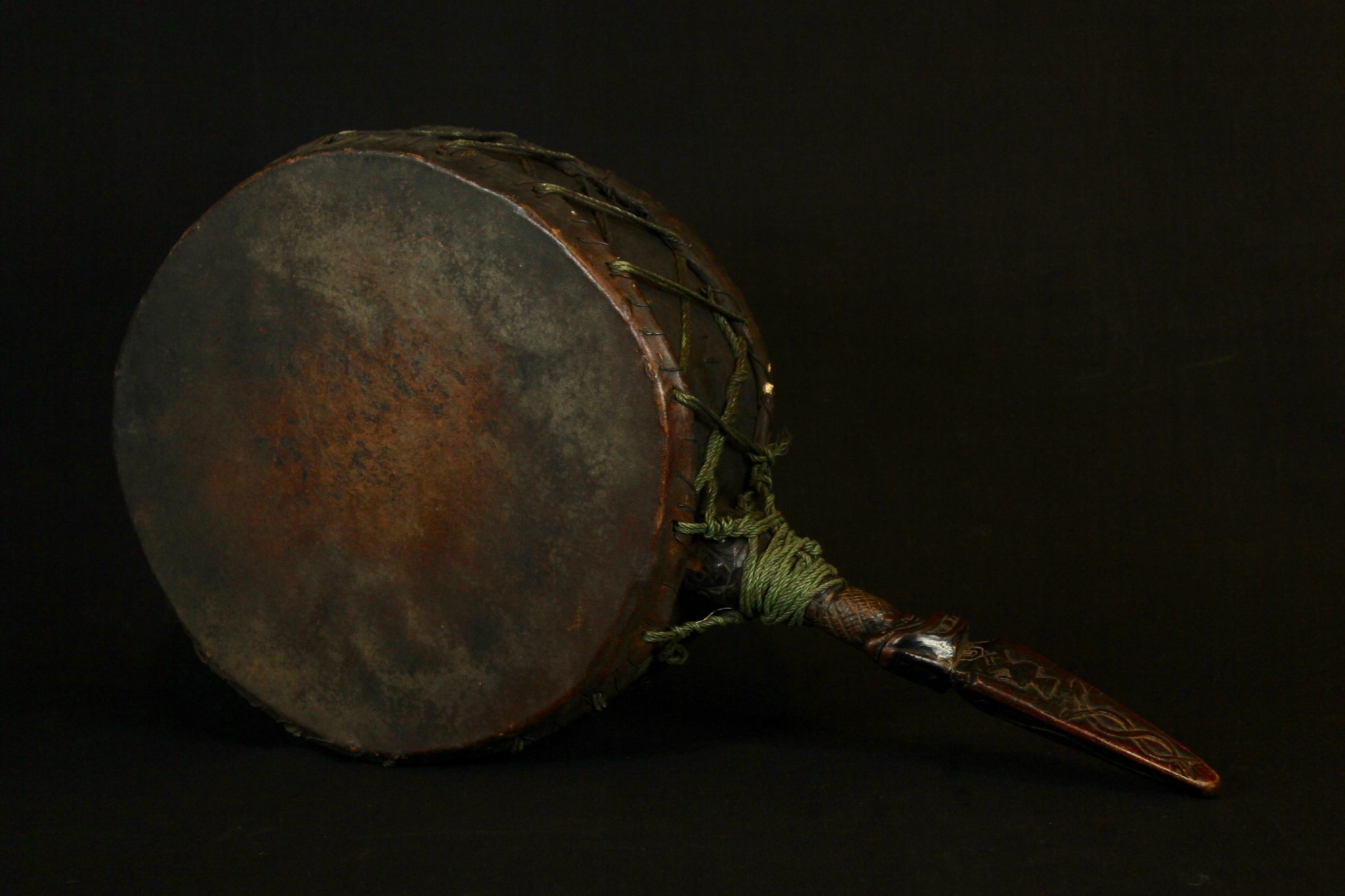
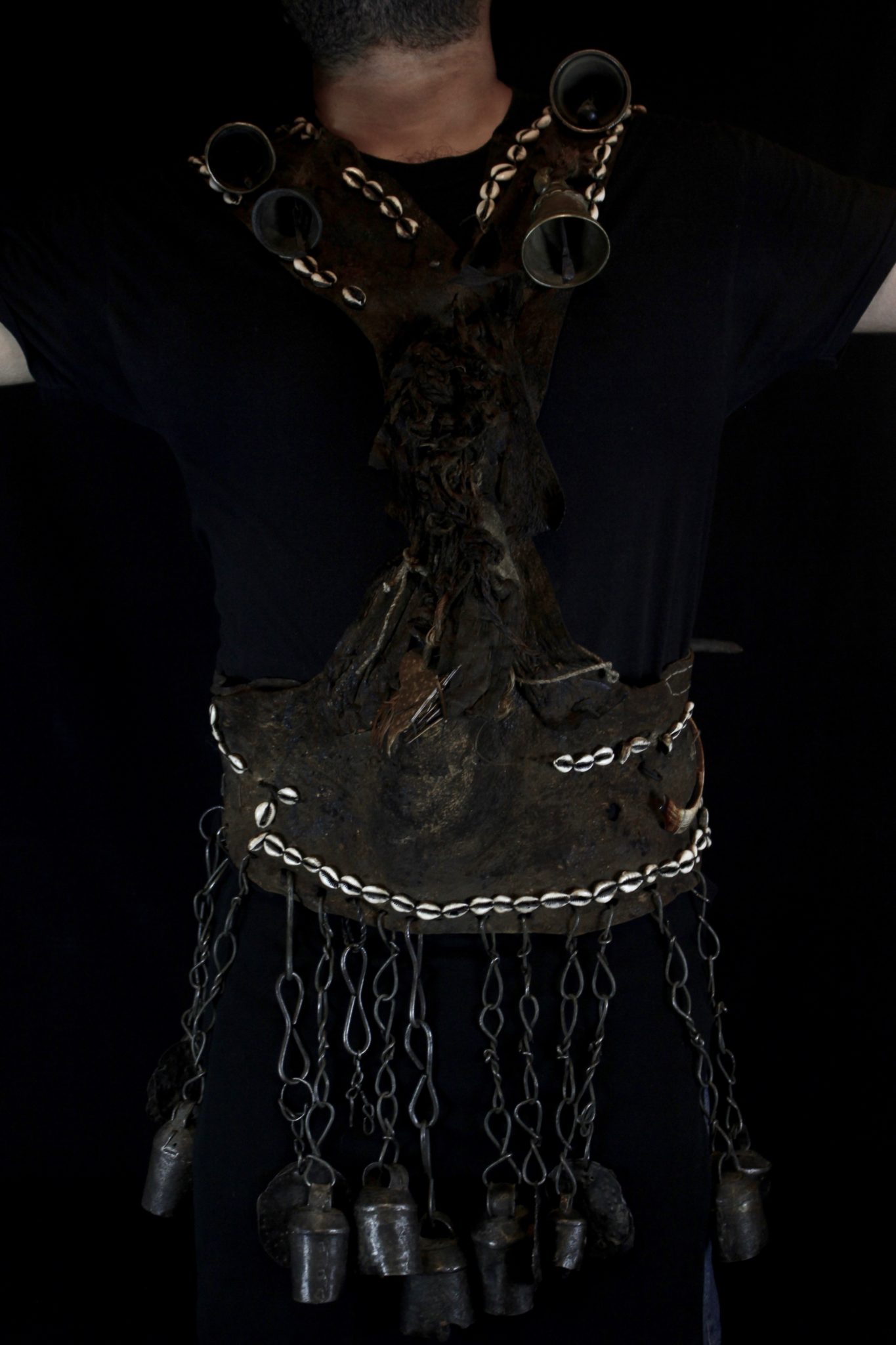
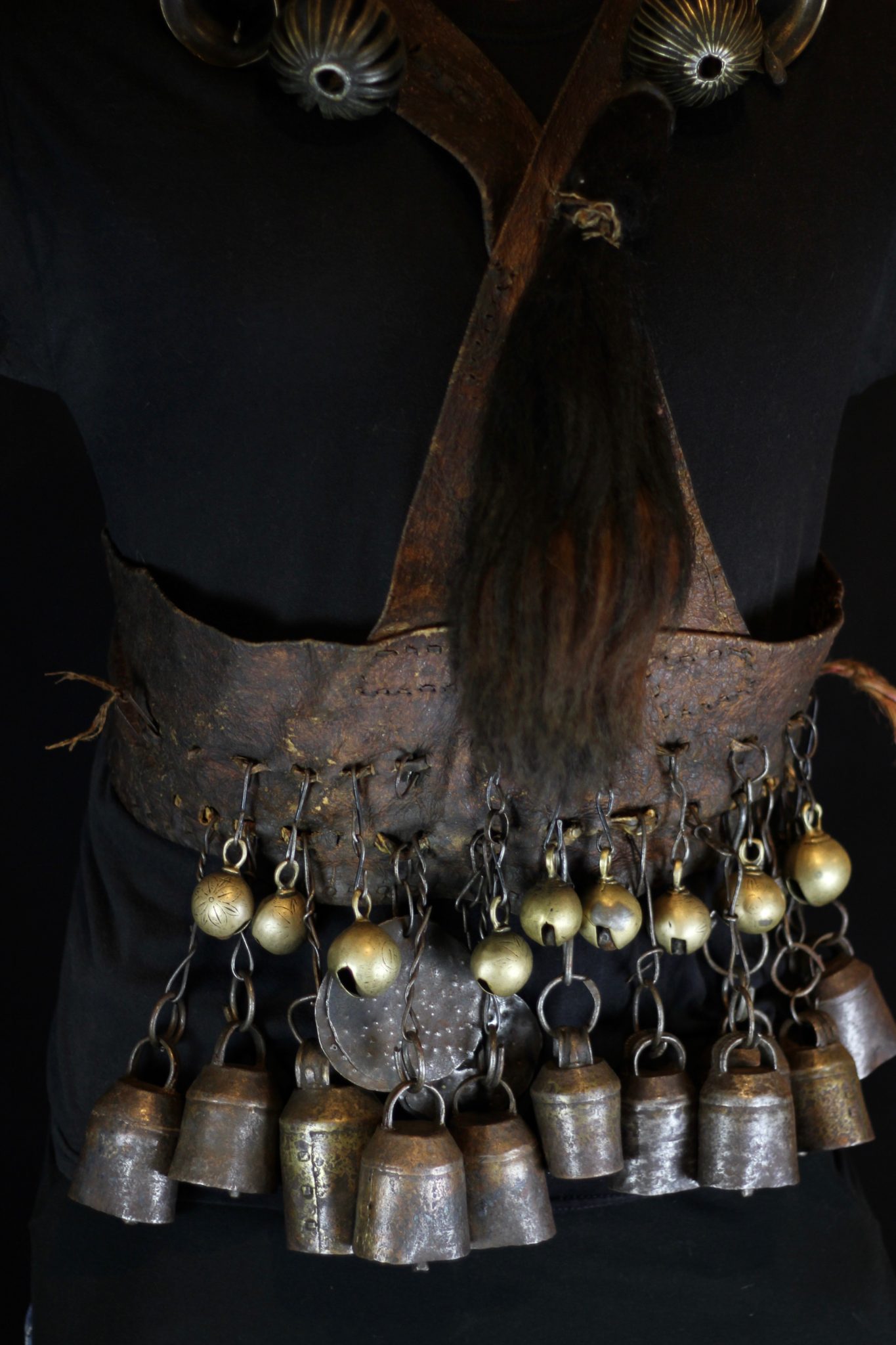
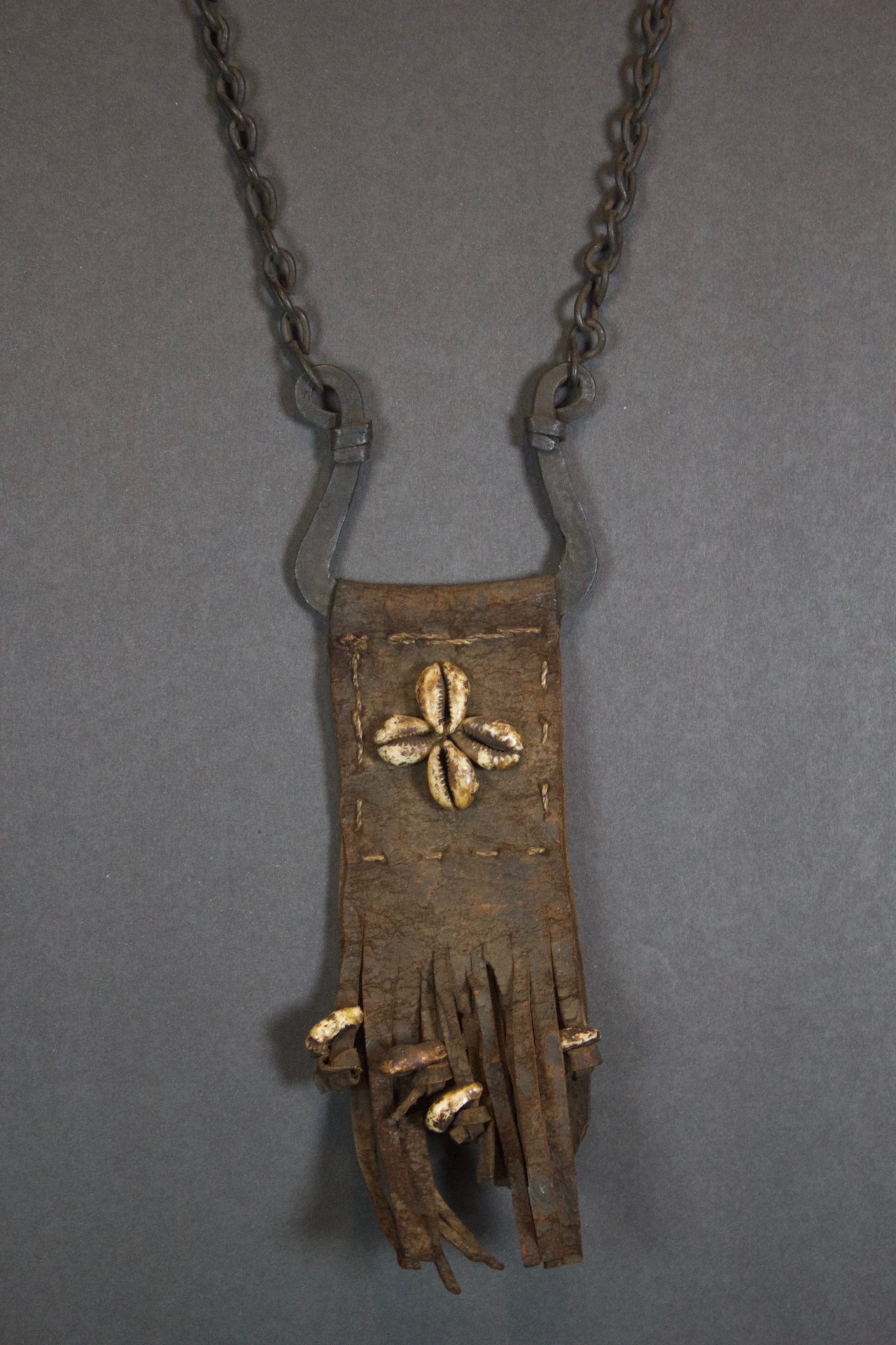
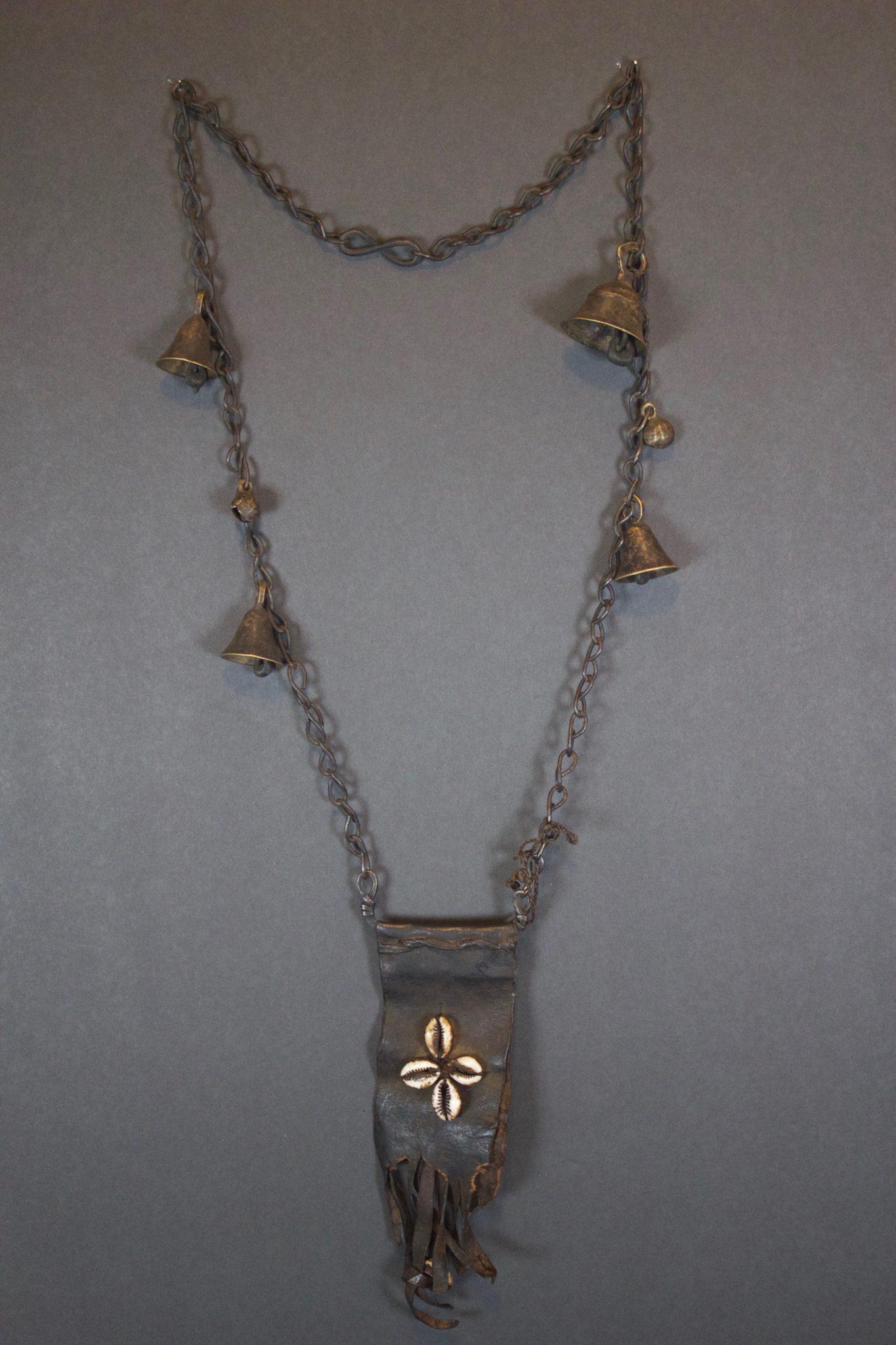
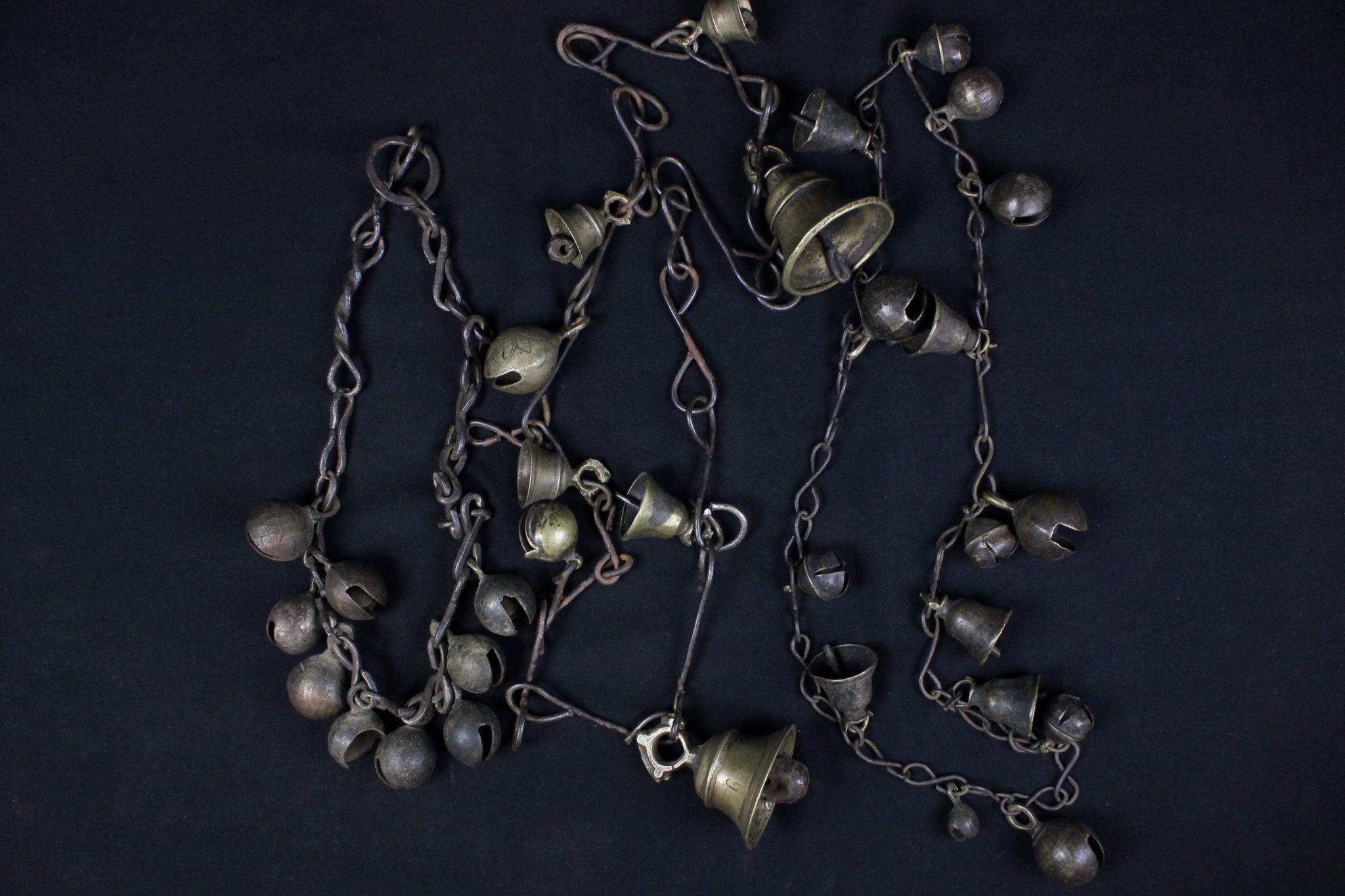
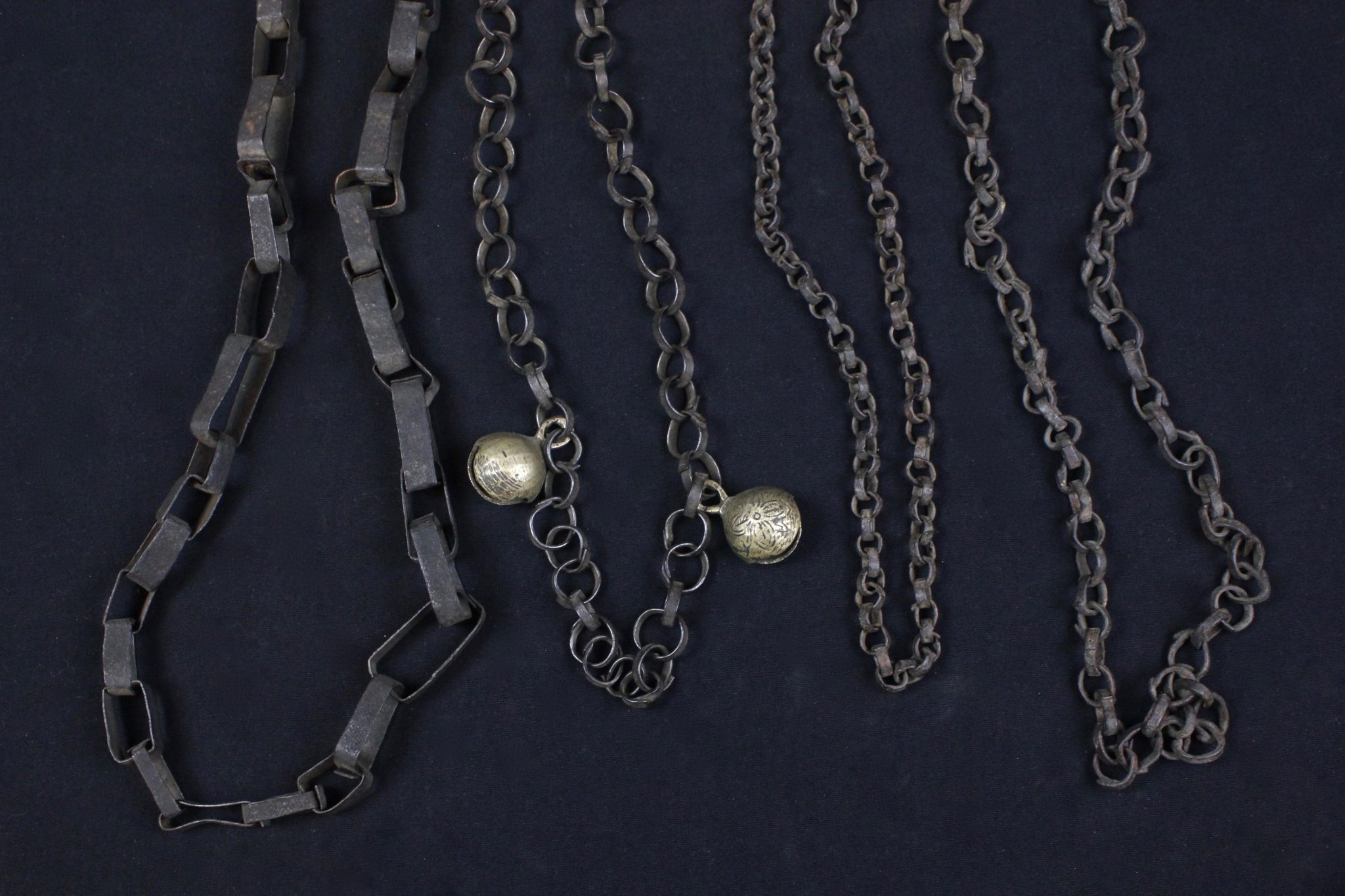
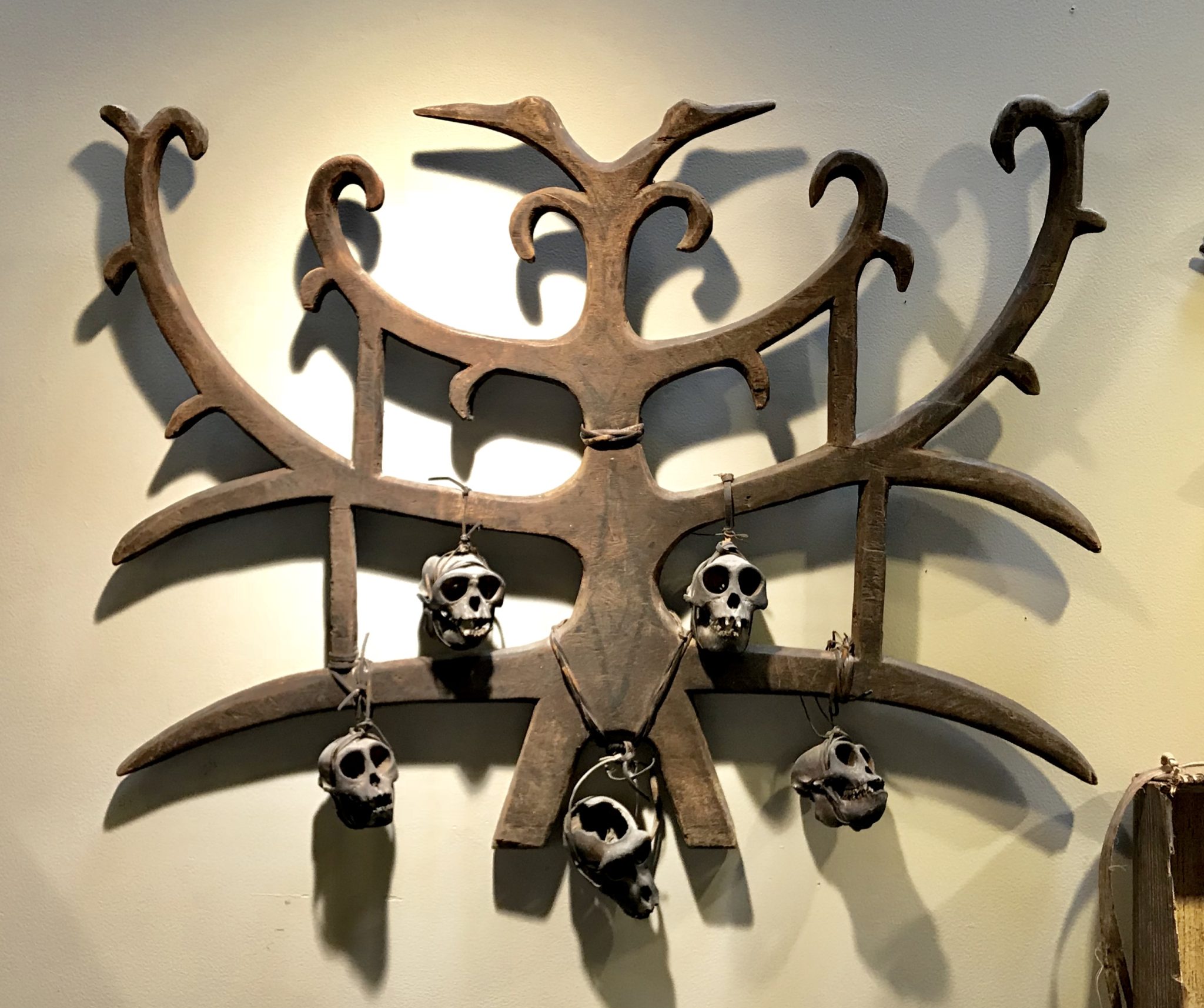
 It took months to research the individual pieces that represent many different, ancient healing cultures from South East Asia – Nepal, Vietnam, Thailand, Myanmar, Nagaland (India) and across the 17,000 Islands of Indonesia. Some of the pieces have been passed down through generations of healers and date back 400 years. Please inquire for a tour of the magical mystery pieces! If you have the time to browse, we learned a lot and would love to share all the intriguing histories.
It took months to research the individual pieces that represent many different, ancient healing cultures from South East Asia – Nepal, Vietnam, Thailand, Myanmar, Nagaland (India) and across the 17,000 Islands of Indonesia. Some of the pieces have been passed down through generations of healers and date back 400 years. Please inquire for a tour of the magical mystery pieces! If you have the time to browse, we learned a lot and would love to share all the intriguing histories.